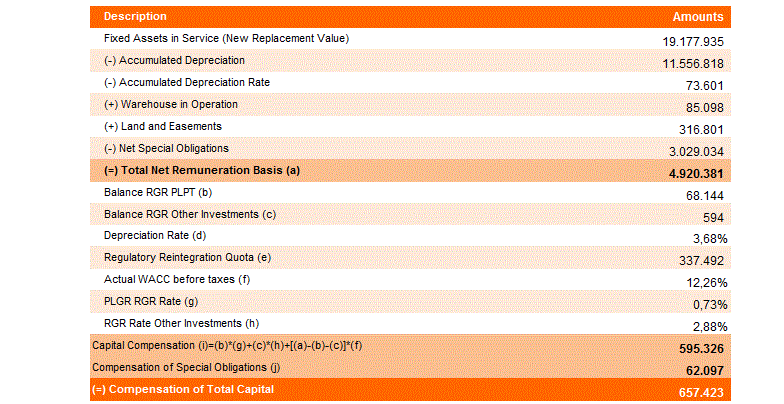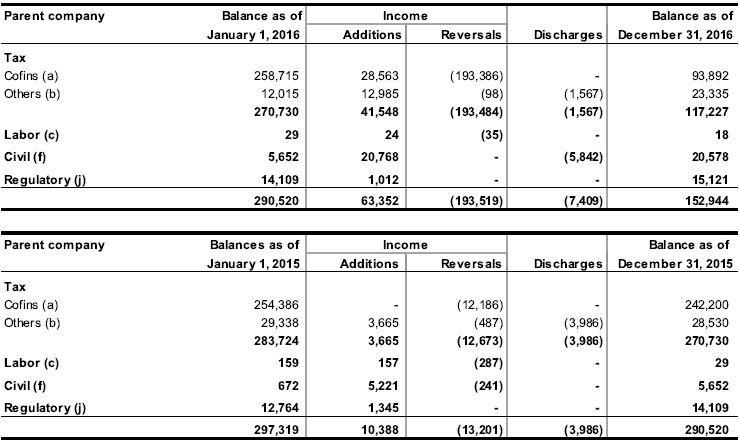SECURITIES AND EXCHANGE COMMISSION
Washington, D.C. 20549
FORM 6-K
Report of Foreign Private Issuer
Pursuant to Rule 13a-16 or 15d-16 of the
Securities Exchange Act of 1934
For the month of July, 2018
Commission File Number 1-14668
COMPANHIA PARANAENSE DE ENERGIA
(Exact name of registrant as specified in its charter)
Energy Company of Paraná
(Translation of Registrant's name into English)
Rua Coronel Dulcídio, 800
80420-170 Curitiba, Paraná
Federative Republic of Brazil
(5541) 3222-2027
(Address of principal executive offices)
Indicate by check mark whether the registrant files or will file annual reports under cover Form 20-F or Form 40-F. Form 20-F ___X___ Form 40-F _______
Indicate by check mark whether the registrant by furnishing the information contained in this Form is also thereby furnishing the information to the Commission pursuant to Rule 12g3-2(b) under the Securities Exchange Act of 1934.
Yes _______ No ___X____

Companhia Paranaense de Energia
Corporate Taxpayer's ID (CNPJ/MF) 76.483.817/0001-20
State registration 10146326-50
Publicly-Held Company- CVM 1431-1
www.copel.com copel@copel.com
Rua Coronel Dulcídio, 800, Batel - Curitiba - PR
CEP 80420-170
MANAGEMENT'S REPORT AND FINANCIAL STATEMENTS
2016

| TABLE OF CONTENTS |
| |
| MESSAGE FROM THE CEO | | 3 |
| 1. | Organizational Profile | | 5 |
| 2. | GOVERNANCE AND SUSTAINABILITY | | 10 |
| 2.1.Governance structure | 10 | |
| 2.2.Integrity Practices | 12 | |
| 2.3.Sustainability Management | 14 | |
| 3. | OPERATIONAL PERFORMANCE | | 16 |
| 3.1.Macroeconomic analysis | 16 | |
| 3.2.Regulatory environment | 17 | |
| 3.3.Business Segments | 22 | |
| 4. | ECONOMIC-FINANCIAL PERFORMANCE | | 44 |
| 4.1.1.Net Operating Revenue | 44 | |
| 4.2.Operating Costs and Expenses | 46 | |
| 4.3.EBITDA | 48 | |
| 4.4.Financial Result | 49 | |
| 4.5.Added Value | 49 | |
| 4.6.Debt | 50 | |
| 4.7.Net Income | 51 | |
| 4.8.Non-Paying Consumers | 52 | |
| 4.9.Investment Program | 53 | |
| 4.10.Research & Development - R&D | 53 | |
| 4.11.Energy Efficiency Program - PEE | 53 | |
| 5. | HUMAN RESOURCES | | 55 |
| 5.1.People Management | 55 | |
| 6. | SOCIAL AND ENVIRONMENTAL PERFORMANCE | | 59 |
| 6.1.Suppliers | 59 | |
| 6.2.Customer | 59 | |
| 6.3.Community and Environment | 60 | |
| 7. | SOCIAL BALANCE SHEET | | 71 |
| 8. | COMPOSITION OF GROUPS RESPONSIBLE FOR GOVERNANCE | | 74 |
MESSAGE FROM THE CEO
The political and economic instability of Brazil had no mitigating factor 2016, which resulted in another year of difficulties for the national productive sector and the maintenance of low levels of energy consumption. This scenario has presented major challenges for the electric sector and for Companhia Paranaense de Energia - Copel. But it was also a year of good news and achievements, as the Company was again in the first place in the evaluation of the customer in the Abradee Award (Brazilian Association of Electric Energy Distributors) and received the Cier trophy as the Best Distributor in Latin America.
Also in the distribution area, we had the fourth tariff cycle and have received the recognition by Aneel (National Agency of Electric Energy) of the investments made in the last four years in this activity, which made it possible for us to double our asset base in the segment to R$4.9 billion. The increase gives a renewed impulse to the distributor's program of construction works, which starts from a more realistic level of assets for the maintenance of its economic-financial balance and the provision of services in keeping with the new quality requirements in the sector. Copel's diversified business portfolio has also ensured higher-than-expected results in the telecommunications segment, as well as a growth in generation and transmission, as expected, given the current market conditions.
The activities of the commercialization company Copel Energia also started, which is an option for companies that migrate to the Free Market, mainly for those coming from the regulated market of the group's own distributor. The subsidiary had a fast growth, closing the year with an average of 30 megawatts of energy sold. By 2017, we expect to double the volume traded, with more than 20 ongoing negotiations.
Regarding our program of construction works and projects in the generation and transmission segments, even amid the crisis of confidence that still hangs over the market, we have raised around R$1.0 billion in 2016 with debentures, which highlights the good reputation that Copel has historically enjoyed with the investors and the market.
In 2016, Copel Renováveis continued the construction works of the fourth wind farm in Rio Grande do Norte, with estimated investments of approximately R$2.2 billion. By 2018, the units will add 28 farms in that region. With this, the wind energy equivalent of Copel will total 665 MW, complying with the strategic and sustainability guidelines established. Currently, the Company has 93% of its generation from renewable sources.
In the transmission segment, the year was impacted by the start-up of 1,678 kilometers of lines and the start of the implementation of a project of R$258.8 million, resulting from an auction due in 2015. Currently, the Company concentrates its efforts on the construction of seven projects, which will add 2,878 kilometers of range and 4,150 MVA of transformation capacity to the set of transmission lines and substations.
An extremely important issue in our current situation, we have reinforced our commitment to fight corruption and to comply with ethical and legal standards in our practices by upgrading the areas of governance, risk and compliance, structured in 2015, to the management level. The new body expresses our conviction that transparency and accountability are key practices for the longevity and for the sustainable growth of thebusiness.
The Company also increased its investments in people management in order to speed up the self-development of our employees and their more effective engagement with the planning and execution of the strategy. By mobilizing 94% of the employees in face-to-face queries that analyzed Copel's challenges and gathered more than 5,000 suggestions and critics, the Anima Program started a movement that intends to prepare it to face the future in an innovative manner in all the areas in which it operates.
The pursuit of innovation is part of our daily routine and we currently work with the main goal of fomenting this culture throughout the Company, in order to contribute with its long-term vision. Good examples of this effort are the Mais Clic Rural program, the implementation of smart networks in the main agribusiness hubs, and the micro-generation project in Entre Rios do Oeste, which connects small and medium-sized pig farmers to large power plants from biogas, while avoiding the environmental impact of waste in the nature.
Also in terms of business sustainability, in 2016, Copel recorded its best historical position in relation to the averages of the Corporate Sustainability Index (ISE) of Bovespa. There are several advantages that guaranteed to the Company a record score, from practicing actions focused on climate change, with commitments of greenhouse gas inventory extended to its value chain up to the early adoption, required by Law, of the Integrated Report - model of accountability that focuses on transparency by connecting economic, social, environmental and governance outcomes.
These initiatives have an important thing in common: they are actions that will allow the Company to continue to grow in a sustainable way in the coming decades and to increase the capacity to serve its customers with quality and agility.
Have a good reading.
Antonio Sergio de Souza Guetter
1. Organizational Profile
Copel was created in October 1954 and is the largest company in Paraná. It operates with state-of-the-art technology in the areas of generation, transmission, commercialization and distribution of energy, as well as telecommunications and natural gas.
It operates a comprehensive and effective electrical system with its own generator unit of power plants, transmission lines, substations, electric lines and networks of the distribution system and a modern optical telecommunications system that integrates all the cities of the State.
Although the Company is headquartered in Curitiba, Paraná, Copel is present in ten Brazilian states, according to the following map:
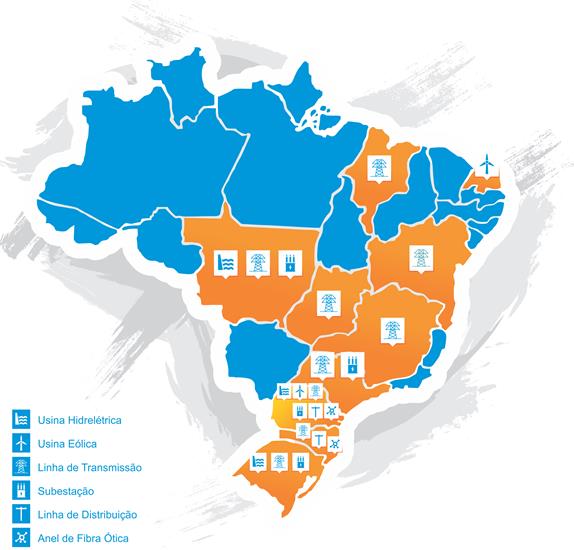
Hidroelectrical Power Plant
Wind Farm
Transmission Line
Substation
Distribution Line
Optic Fiber Ring
· Participation in the Market

· Awards and Certifications

· Strategic Reference
The guidelines expressed in the Company's strategic reference guide its management and all internal and external actions and decisions. They include:
Mission:Provide energy and sustainable development solutions.
Vision:To be a reference in the businesses in which it operates generating value in a sustainable way.
Values:
· Ethics: Result of a collective agreement that defines individual behaviors in line with a common goal.
· Respect for people: Taking others into account.
· Dedication:Ability to engage intensely and completely in the work contributing to the achievement of the organization's goals.
· Transparency: Accountability of the decisions and achievements of the company to report their positive or negative aspects to all the interested parties.
· Safety and Health: Healthy working environment in which workers and managers collaborate to use a process of continuous improvement of the protection and promotion of safety, health and well-being for all.
· Responsibility:Conduct the life of the company in a sustainable manner, respecting the rights of all stakeholders, including future generations and the commitment to support all life forms.
· Innovation: Applying ideas in processes, products or services in order to improve something that already exists or to build something different and better.
· Organizational structure
The following chart shows the Company's shareholding structure on December 31, 2016:
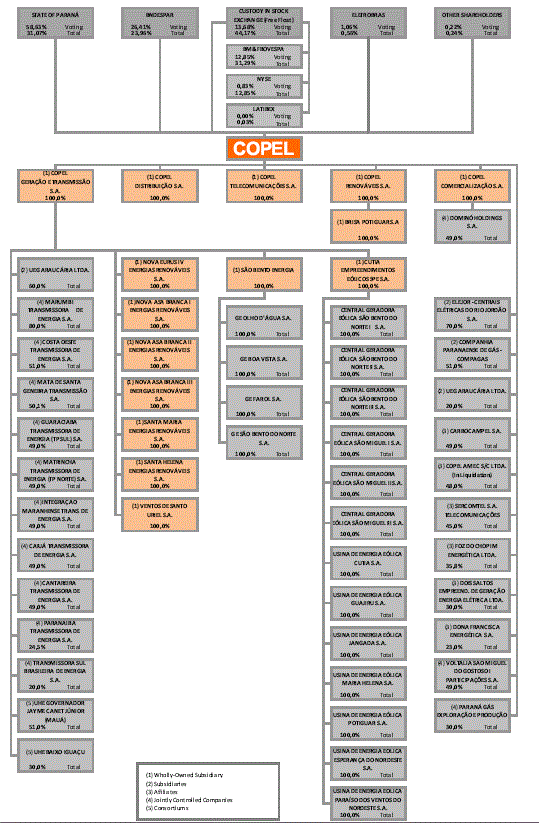
· Copel in Numbers
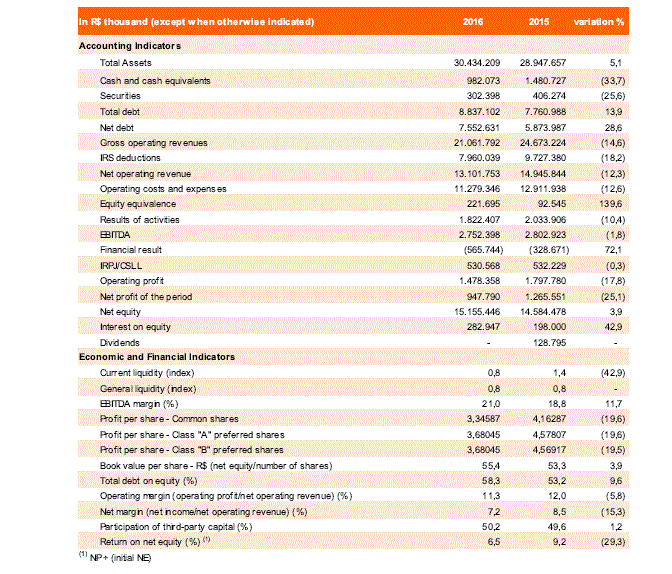
2. GOVERNANCE AND SUSTAINABILITY
Copel's governance model is guided by transparency, compliance and corporate social responsibility, according to the practices proposed by the Brazilian Institute of Corporate Governance (IBGC).
Four principles guide the corporate governance: Transparency, Equity, Accountability and Corporate Responsibility. Based on these principles, Copel has developed its Governance Policy to establish the standards and the best practices of corporate governance to be adopted by the Company and its subsidiaries.
In order to be permanently guided by morally positive principles, all those working on behalf of the Company are subject to a code of conduct developed in accordance with Copel's values, the Global Pact Principles and the Corporate Governance Principles.
In 2016, the company made progress in improving its corporate governance practices with the creation of a new Board of Governance, Risk and Compliance. The creation of this board anticipated the compliance with the requirements of the Anti-Corruption Law - regulated in 2015, and the new State Law 13,303/2016.
2.1. Governance structure
The Company's governance structure on December 31, 2016 is as follows:
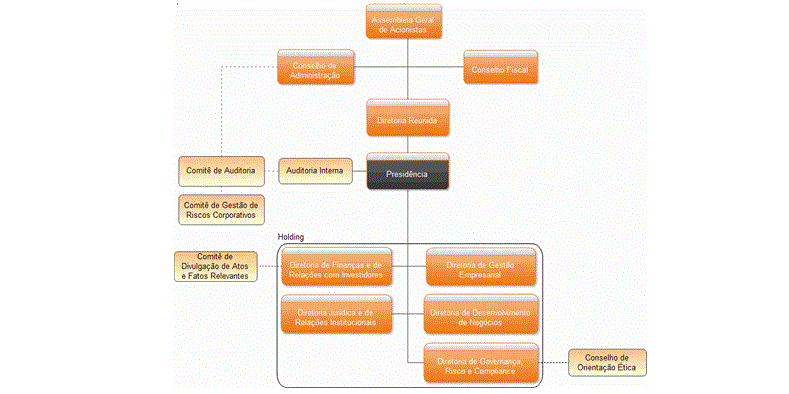
Translation (top-down, left-right): General Shareholders’ Meeting, Board of Directors, Fiscal Council, Joint Executive Board, Audit Committee, Internal Committee, Presidency, Corporate Risk Management Committee, Holding, Committee for the Disclosure of Material Acts and Facts, Finance and InvestorRelations Office, Corporate Management Office, Legal and Institutional Relations Office, Business Development Office, Governance, Risk and Compliance Office, Ethical Guidance Board
General shareholders' meeting
It is the forum in which the shareholders have the power to decide all the business related to the Company's purpose and to take the resolutions considered convenient to its defense and its development.
Fiscal Council
Permanent body that examines the financial statements, gives opinions on the management's report, capital modification, capital budget, dividends distribution and oversees the work of the management. It has five sitting members and five alternates with a one-year term.
Board of Directors - BOD
Copel's Board of Directors has nine members, five of them independent. The BOD holds four ordinary meetings according to the pre-established schedule, in addition to eventual extraordinary meetings (on average, eight meetings per year).
Executive Board gathered
It has executive powers and duties and enforces the Company's strategy. Members: CEO, five executive officers and one assistant officer. Term of office of three years after the BOD election.
Audit Committee
Directly connected to the Board of Directors, the Audit Committee has three members of that Board, independent under the terms of Rule 10A-3 of the Securities Exchange Act, with its characteristics, composition, functioning and competences established by a specific Internal Regulation.
The appointment of the candidates, from the next term of office, for the members of the Committee, which will begin in May 2017, the Company will adopt the requirements of Art. 25 of Law 13,303/2016 and in the State Decrees 6262 and 6263/2017.
Board of Ethical Guidance - BEG
An administrative board connected to the Presidency, with the duty to contribute with the Company's performance to be permanently driven by ethical principles in the development of its business. It has twelve officers, of whom eleven are Copel's employees and one is a representative of the civil society.
Committee of disclosure of material acts and facts
It has 15 members and supports the Finance and Investor Relations Office in the practice of the Policy for Disclosure of Relevant Information and the Policy for Trading Company's Shares, pursuant to CVM Instruction 358/2002.
Committee of Corporate Risk Management
The Committee of Corporate Risk Management is the board responsible for surveying the Company's risk matrix, managing it and appointing preventive security measures to the business. Copel also has an Internal Audit structure, responsible for assessing the adequacy of internal controls, the effectiveness of the risk management, the compliance with standards and the process reliability.
Copel's risk management model takes into account legal, regulatory, social, environmental and reputational aspects as the basis for the decision-making processes and operating activities, with the following risk profiles: strategic, operational and compliance. The model also establishes the parameters of risk appetite, the possibility of its occurrence and its social, environmental, financial, operational and image impacts, providing tools for its preventive treatment and mitigation.
2.2. Integrity Practices
Copel has several structures to establish a transparent dialogue and ethical relationship with all its stakeholders. These mechanisms are included in the integrity practices of the Company and its subsidiaries, based on the alignment with the UN Global Pact and the public commitment to fight corruption. The Company adopts internal tools to disseminate an ethical behavior and identify deviations, making available the Compliance Portal.
· Integrity Program
The Integrity Program is a platform for disseminating the Company's commitments with transparency and the fight against corruption. In 2016, the program's trainings were implemented in the education model of Remote Learning (EAD) to raise awareness on the ethical behavior among all employees of Copel and its subsidiaries. 7,724 employees were trained in the fight against corruption, equivalent to 90.54% of the Company's employees.
The Company's ethical standards were disclosed in all internal communication channels, and all corporate rules related to the Integrity Program are available on the internet.
· Code of Conduct
The Company's Code of Conduct is in line with the values, the UN Global Pact Principles and the Corporate Governance guidelines. It establishes actions that aim for integrity, transparency, safety and health. The document also addresses social and environmental responsibility, respect and relationship with the several segments in which it operates.
Created in 2003, with ethical parameters, it should serve as a guiding instrument for the acts of all those who carry out activities on Copel's behalf. In 2017, the Company will promote a new update of the Code of Conduct, in order to make it more adherent to the new Anti-Corruption Law. The code of conduct is available to all interested parties on Compliance Portal.
This set of actions is subject to the standards established by the Committee of Sponsoring Organizations for the Treadway Commission -COSO.
In order to disseminate the concepts of the Code of Conduct, in 2016, Copel has developed a specific training in the "Distance Learning" modality (EaD), in which 543 employees already participated. Copel's goal is to ensure that all employees perform this module by October 2017.
· Corruption Risk Assessment
As part of its Policy of Integrated Management of Corporate Risk, Copel seeks to ensure a constant monitoring of the threat of corruption within the Company and of fraud in the internal control environment.
Due to these safety criteria, all operational processes are annually submitted to the evaluation of risks related to errors or fraud, which may interfere with the results of the financial statements. In this respect, are established controls submitted to tests by the Internal Audit and by the Independent Auditor, the results of which are reported to senior management.
In 2016, the Company submitted 28 transactions to risk assessments related to corruption. This represented 100% of the operations carried out during the year. No cases of corruption were identified in the period.
· Reporting channels
In order to receive opinions, criticisms, complaints, claims and personal inquiries, Copel provides communication channels that, in addition to contributing to the fight against fraud and corruption, also expand the organization's relationship with its stakeholders. They are:
· Confidential Communication Channel: intended to receive complaints and communications of non-compliance with laws and regulations, especially of fraud or irregularities involving issues on the area of finance, auditing or accounting. The channel guarantees protection, preservation of the identity of the person making the claim and an answer to the complaint. It is available 24 hours a day, seven days a week, toll-free call. Phone Number: 0800 643 5665.
· Ombudsman: There are two channels open to all stakeholders, internal and external, for suggestions, claims and complaints, and are available on weekdays, from 8am to 6pm, with toll-free call. The Copel Distribuição Ombudsman is available through the phone number 0800 647 0606 and also through the email ouvidoria@copel.com. In addition, it can receive the complaints in person or through correspondence sent to its address at Rua Professor Brasílio Ovidio da Costa, 1703, in the Santa Quitéria Neighborhood, CEP: 80310-130, in Curitiba - PR. The Copel Telecomunicações Ombudsman is available through the phone number 0800 649 3949 and through the email ouvidoriatelecom@copel.com., able to receive the complaints in person or through correspondence sent to its address, at Rua Emiliano Perneta, 756, Batel Neighborhood, CEP: 80420-080, in Curitiba - PR.
· Commission for analysis of complaints of harassment - CADAM: assists and supports every employee who is a victim of bullying in its work environment. The information is confidential and both the complainant and the respondent have a guarantee of identity preservation. Email:cadam@copel.com
· Ethics Guidance Board - EGB: assesses and issues guidance on processes related to ethical conduct in the Company and has a maximum deadline of 90 days to provide a final answer. Emailconselho.etica@copel.com.
· External Audit
Under the terms of Instruction 381/2003 of the Brazilian Securities and Exchange Commission, in an internal Corporate Governance standard and under the review and supervision of the Audit Committee, the Company and its wholly-owned subsidiaries have a contract with Deloitte Touche Tohmatsu Auditores Independentes since March 21, 2016, to provide audit services of the financial statements, being that the work necessary for the evaluation of the fiscal year will extend until June 30, 2017, date that will correspond to its final term, and may be formally extended in up to 48 months.
Every five years, following the criterion of rotation of the independent auditors according to CVM Instruction 308/99, the Company changes the company responsible for auditing its financial statements.
The amount contracted for the 2016-2017 period was of R$2.4 million and the total gross amount paid for external audit services rendered in 2016 was R$0.4 million.
Deloitte was hired by the amount estimated at R$0.8 million, 32.41% of amount hired by the external audit service providing engineering services specialized in independent technical advisory services for the election analysis.
When hiring other services from its external auditors, the Company's practice of action foresees the prior review by the Audit Committee of the Board of Directors, which should take into account in this evaluation if the relationship or a service rendered by an independent auditor: (a) creates conflicting interests with its audit client; (b) puts them in a position to audit their own work; (c) results in working as manager or as employee of the audit client; or (d) puts them in a position to work as lawyer to the audit client.
The Audit Committee also considers in this type of assessment if any service rendered by the independent audit firm may impair, in fact or the appearance, of the firm's independence. Whenever necessary, the Audit Committee can count on the technical support of the Internal Audit or also of an independent advisory service for a technical evaluation that may be required in each specific case, with this hiring of an independent advisory service being recorded in the minutes of the meetings of these boards.
2.3. Sustainability Management
The challenges of sustainability are part of Copel's strategic reference contained in the mission and vision of business. The permanent search for improving the performance of the area of sustainability, as well as its communication with stakeholders and the management of matters and indicators are steps of this strategy.
All of this work involves some of the main market practices to:
· direct and assess their performance, as well as compare their practices with world and national references: RobecoSAM questionnaire (Dow Jones Sustainability Index - DJSI), Ethos Indicators forSustainable and Responsible Business Models, and Corporate Sustainability Index (ISE - BM&FBovespa).
· report their performance and engage their stakeholders: Global Reporting Initiative - GRI, Carbon Disclosure Project - CDP and Global Greenhouse Gas Protocol - GHG.
One of the results of Copel's actions was the Company's selection, in November 2016, to remain in the group of the most sustainable companies of the São Paulo Stock Exchange (BM&FBovespa) in the 2016/2017 portfolio. The Company has been part of the ISE portfolio since its creation in 2005. Copel was included in eleven of the twelve editions of the index.
The 2016 year was also featured by the Company's continuity in the sustainability index of the Morgan Stanley Capital International MSCI, the world leader in the composition of financial indices that work as a reference for investors. The MSCI ESG seal is awarded to companies with excellent performance in the social, environmental and corporate governance areas. Copel achieved the maximum score in 27 of the 28 indicators analyzed in 2016. Among the indicators are: the control of its carbon emissions and the disclosure given to administrative and financial management information.
· Voluntary Commitments
Copel — committed to the sustainable development — has made several voluntary commitments throughout its history, disseminating them to its value chain and other stakeholders:
· Global Pact
· National Movement ODS We Can
· Business Contribution for the Promotion of the Green and Inclusive Economy
· Statement Call to Action for Governments in the Fight against Corruption
· Business Pact for Integrity and Against Corruption
· Eradication of Child Labor, Forced Labor or Compulsory Labor
· Sexual Exploitation of Children and Teenagers
· Fighting the practice of Discrimination and Valuing Diversity
· Preventing Moral Harassment and Sexual Harassment
· Respecting the right of free association and the right of collective bargaining.
· Principles for Responsible Business Education - PRME
· Network of Companies for Education and Eradication of Child Labor
3. OPERATIONAL PERFORMANCE
3.1. Macroeconomic analysis
The world economy had the weakest performance since the global financial crisis in 2016, due to the stagnation of trade, the low volume of investments and the high level of political uncertainties, closing the year with an estimated growth of around 2.3%1. Only at the end of the year, the economy showed a slight acceleration, when confidence indicators in general began to show improvement in several regions of the world, especially those related to the confidence of the manufacturing industry. The volume of world trade has reached very low levels in the first half of the year and is now beginning to recover. The United States, after growing below 1.0% in the first half of the year, performed better in the second half, and China, although showing a growth lower than the previous year, performed better than initially estimated by economists.
The 2016 year was featured by events that expressed the desire for changes in relation to the political and economic model currently in force in many countries, which allows greater commercial freedom and flow of people between nations. This interest could be observed in the success of the Brexit and also in the election of Donald Trump for the government of the United States of America, events that generated uncertainties and risks for the politics and the global economy. Such facts bring important signs for 2017, such as the possibility of a slowdown in globalization, given that the resurgence of nationalism in some parts of the world will put the rules of the World Trade Organization to the test; the increase in the level of uncertainty regarding the intensity with which the politics will direct the economy; and the return of the US monetary policy to normal levels, with a gradual advance of the monetary tightening throughout the year.
The troubled political context and the size of the budget deficit were decisive factors in bringing Brazil into the current recessive context, which has been extending since the second quarter of 2014, caused by the significant increase in government spending that made the budget deficit and the gross debt rise, scaring off investments due to fear of non-payment and leading to the loss of three degrees of investment and a strong currency devaluation, which helped to speed up the price inflation. The reduction in the volume of jobs associated with the stagnation of the labor income, led to a significant loss of salary mass, preventing the recovery of the consumption of the families, with immediately impacted the trade and services sector. The difficulty to reverse the recession process remained throughout 2016, due to the high level of indebtedness of companies and families. Gross Domestic Product - the national GDP decreased by 3.6%2 in 2016.
1 World Bank Estimate - Global Economic Prospects - January/2017
2 Source: Brazilian Institute of Geography and Statistics – IBGE
The state economy decreased by 2.4%1 in 2016, as a result of the lower performance of the industrial segment, a frustration with the crop that negatively impacted the agricultural sector and the low dynamism in the trade and services segment. The outcome of the industrial segment was mainly influenced by the automotive industry, besides the areas of machinery and equipment, furniture and nonmetallic minerals. The agricultural sector had a decrease of 5.7% in the grain production, due to less favorable climatic conditions. The trade and services segment suffered a decrease due to the loss of work income.
3.2. Regulatory environment
Since 2013, the Brazilian Electricity Sector faces a major crisis that can be divided into 3 distinct moments: (a) from 2013 onwards, a period of hydrological restrictions, which hindered the production of electricity in the National Interconnected System (SIN); (b) the financial restructuring of generation and distribution agents due to the exposure to the short-term market, followed by a strong judicialization, practically halting operations in the national energy market from the end of 2014; (c) renegotiation of the liabilities hired by the agents in this period and attempt to unlock the segment.
In this context, 2015 was a year in which the Brazilian electricity sector had its regulatory environment strongly influenced by the search for solutions to equation this third phase of the crisis. After a long period of discussions with the society, the Federal Government issued MP 688, later converted into Law 13,203/2015. Subsequently, on December 11, 2015, Aneel published the Normative Resolution 684, which established the criteria for consent and other conditions for the reconvening of the hydrological risk of hydroelectric generation by agents participating in the Energy Reallocation Mechanism.
In 2016, with the change of ownership of the federal government, it was possible to observe a change in the way the policies for the electric energy sector were carried out in the country, which became less interventional, seeking to improve the business environment to attract new investments in the sector. An example of this change was the approval of Law 13,360/2016, which comes from Provisional Measure 735/2016.
In general, the new law sought to facilitate the privatization processes, reduce the bureaucracy of auctions and the costs of the Union with subsidies to concessionaires and allows the privatization of state distributors that were federalized. In all, 12 standards of the sector were amended, including Law 10,488/2004, which was considered as the legal framework for the "new model" of the Brazilian electric energy sector. In general, the new regulation signals to the market an intention of the federal government to de-judicialize the sector and mechanisms for solving problems.
1Source: Paraná's Institute of Economic and Social Development - Ipardes
· Rationing Risk
Approximately 61.0%1 of Brazil's capacity currently comes from hydroelectric generation (ANEEL - Generation database). Therefore, Brazil and the geographic region in which we operate are subject to hydrological conditions that are unpredictable due to non-cyclical deviations from average rainfall. Among other things, unfavorable hydrological conditions may lead to comprehensive electricity saving programs such as a rationalization or even mandatory reduction of consumption, which is the case of rationing.
Adverse weather situations affected Brazil's main river basins and reservoirs in the Southeast/Midwest and Northeast during the year 2016, which prompted the bodies responsible for the sector to take measures to optimize water resources and ensure full compliance with offtakes.
However, concerning the short-term risk, according to the Committee of Monitoring of the Electric Sector - CMSE, the risk of any energy deficit is within the margin of safety. The same position is adopted by the National Electric System Operator - ONS concerning the risk of medium term deficit, as presented in the EOP 2016 - Energy Operation Plan 2016-2020.
Although the stocks stored in reservoirs are not ideal, from the point of view of regulators, when combined with other variables, they are enough to maintain the risk of deficit within the safety margin established by the National Council for Energy Policy (CNPE) (maximum risk of 5.0%) in all subsystems.
· Extension of Concessions
Concerning the extension of the concessions delegated to Copel, it is important to note that, in 2012, a new regulation was established for concessions in the electric energy sector, in which the concession was extended, provided that several concessions are accepted by the Concessionaire Grantor. At that time, MP 579/2012 was published, later converted into Law 12,783/2013, which provided, among others, for the treatment to be given to the generation, transmission and distribution concessions under articles 17, 19 and 22 of Law 9,074/1995, whose maturity would initially be between 2015 and 2017 and which had already undergone a single extension. This rule also remains valid for the concessions that will expire as of this date.
Generation Concessions
For the concessions of generation, an extension of up to 30 years was established. The extension was granted to the concessionaire and its adoption depended, in addition to the acceptance of anticipation of the original term of its concession, also the express acceptance the following conditions: (a) remuneration per rate calculated by Aneel for each hydroelectric plant; (b) allocation of quotas of physical guarantee of energy and power of the hydroelectric plant to the concessionaires and permissionaires of the public electricity distribution service of the SIN, to be established by the regulatory agency, according to the regulation of the granting authority; and (c) compliance with the quality of service standards established by Aneel.
1 Generation Information Bank - Aneel
Copel Geração e Transmissão, after learning the conditions for the extension, carried out the possible analyses, concluded that it was not feasible to adopt the extension at that moment of the concessions of generation of its four plants due between 2014 and 2015: Rio dos Patos with 1.8 MW of installed capacity, Governador Pedro Viriato Parigot de Souza Plant with 260.0 MW, Mourão with 8.2 MW and Chopim I with 1.8 MW.
Subsequently, MP 688/2015, among other matters, changed the conditions for the renewal of the concession of these plants, which became subject to an auction, being disputed through the highest grant bonus to be offered by the concessionaire in comparison with the lower revenue required. Thus, on November 25, 2015, Auction 12/2015 was held, in which the plants of Mourão and Governador Pedro Viriato Parigot de Souza were offered. After the event, Copel Geração e Transmissão was the winner in Lot B1, in which the HPP Governador Pedro Viriato Parigot de Souza was tendered, thus renewing the concession of the plant for another 30 years. For the Mourão plant, Copel Geração e Transmissão did not present a proposal, being taken over by another concessionaire.
As for the Chopim I plant, after the concession was terminated, it became recorded by Copel Geração e Transmissão, pursuant to Law 12,783/2013. Rio dos Patos, in turn, is subject to the quota system introduced by the same law.
The next plant to have its concession expired is TPP Figueira, which has its contractual term scheduled for March 26, 2019. On March 24, 2017, Copel already filed with Aneel its intention to extend the granting of the generation concession of the TPP; however, it highlighted that it will sign the necessary agreements and/or amendments only after knowing and accepting the contractual terms and rules that will guide it. TPP Figueira has an installed capacity of 20 MW and is currently undergoing a modernization process.
Transmission Concessions
For the concessions of transmission, an extension of up to 30 years was established. Extensions of up to 30 years were introduced for transmission concessions as an option for their concessionaires. Adhesion depends on accepting acceleration of the original agreement and express acceptance of the following conditions: (i) fixed revenues determined in accordance with criteria set by ANEEL; and (ii) submission to levels of service quality set by ANEEL.
Having been informed of the conditions for extension, and analyzed and evaluated them, Copel Geração e Transmissão opted for extension of its transmission agreement. However, the extension failed to take into account several investments made by concessionaires that were not reimbursed by the concession granting authority. Normative Resolution 589 issued in 2013 set rules for indemnifying investments not yet amortized and/or depreciated existing on May 31, 2000, which were designated as Basic Network of the Existing System - RBSE and RPC (connection and other transmission facilities).
Copel Geração e Transmissão compiled a report assessing the amount required to reimburse these investments which was submitted to ANEEL on March 31, 2015 and is awaiting validation by the agency for the amount to be subsequently paid by the Ministry of Mines and Energy (MME).
On April 20, 2016, the MME published by Ordinance 120/2016 in which were presented the guidelines for the payment of the indemnities related to the appraisal report of the assets of RBSE and RPC of Copel Geração e Transmissão, which should be recognized from the 2017 tariff cycle.
Based on the information available in Ordinance MME 120/2016 - in the Tariff Regulation Procedure - PRORET, and in its best estimate, the Company recorded the amount of R$1,187.0 million in accounts receivable related to the concession, with effect of R$809.6 million in the operating revenue for the year. This amount will be received through two means: (a) in 8 years for the period between 2013 and June 2017; and (b) from July 2017 until the end of the useful life of the assets, limited to the end of the concession agreement. These amounts will be incorporated into the Annual Revenue Allowed - RAP of the transmission concession agreement 060/2001, to be established as of July 2017.
Distribution Concessions
Decree 8461 issued on June 2, 2015 regulates extensions of electricity distribution concessions referred to in Article 7 of Law 12,783/2013. Decree 8461 enables the MME to extend electricity distribution concessions for thirty years in order to meet the following criteria:
I - Efficiency in terms of quality of service;
II - Efficiency in relation to economic and financial management;
III - Operational and economic rationality; and
IV - Moderate tariffs.
A Ministry of Mines and Energy order issued on November 9, 2015 granted the request for extension and the fifth contractual amendment signed in December 2015 formalizing the extension of the Public Service Concession for Distribution of Electricity 46/1999 until July 7, 2045.
The fifth amendment imposes conditions related to indicators of quality of service and economic and financial sustainability, which will be supported by an investment program focusing automation and new technologies, full implementation of tariff adjustments approved by ANEEL, and the implementation of corporate governance structure to be defined by the regulator, ensuring the protection and individualization of Copel Distribuição.
The following chart shows the goals set for Copel Distribuição in the first 5 years of renovation:
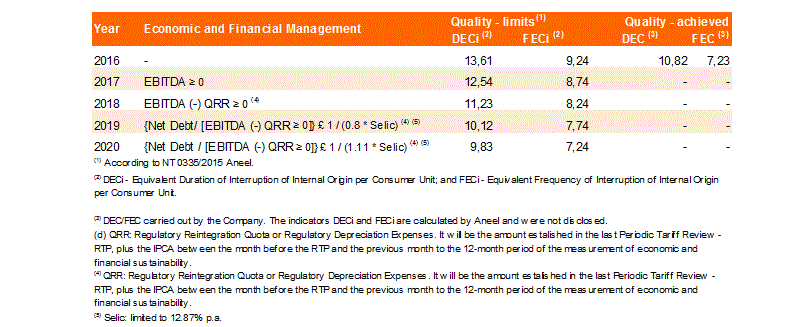
In 2016, the Company met the DEC and FEC goals established and reiterates its commitment to the economic sustainability of the concession and continued investments backed by management's efforts to cut costs, maximize productivity and improve operational efficiency.
· Energy Flow (% and GW/hour)
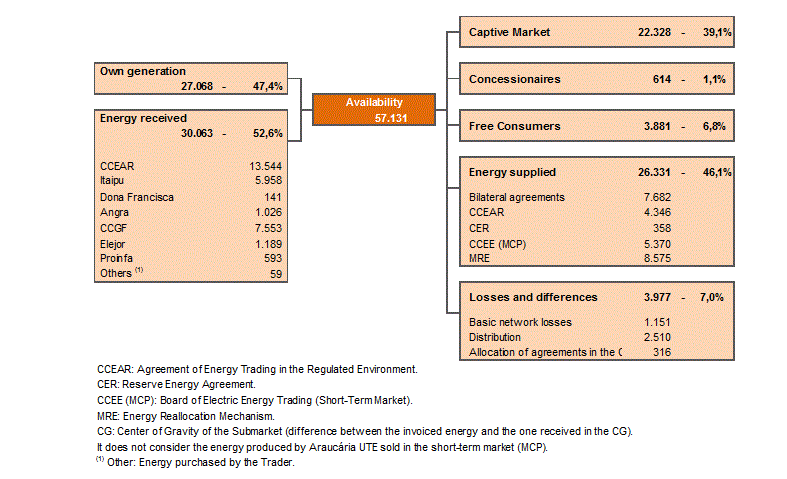
3.3. Business Segments
3.3.1. Generation
Copel operates 30 plants of its own and has ownership interests in another 9. Of the total, 21 are hydroelectric, 16 wind powered and 2 thermoelectric plants, with total capacity of 5,674.7 MW and physical guarantee 2,651.4 MW, as shown below:
Plants in Operation - Physical Characteristics
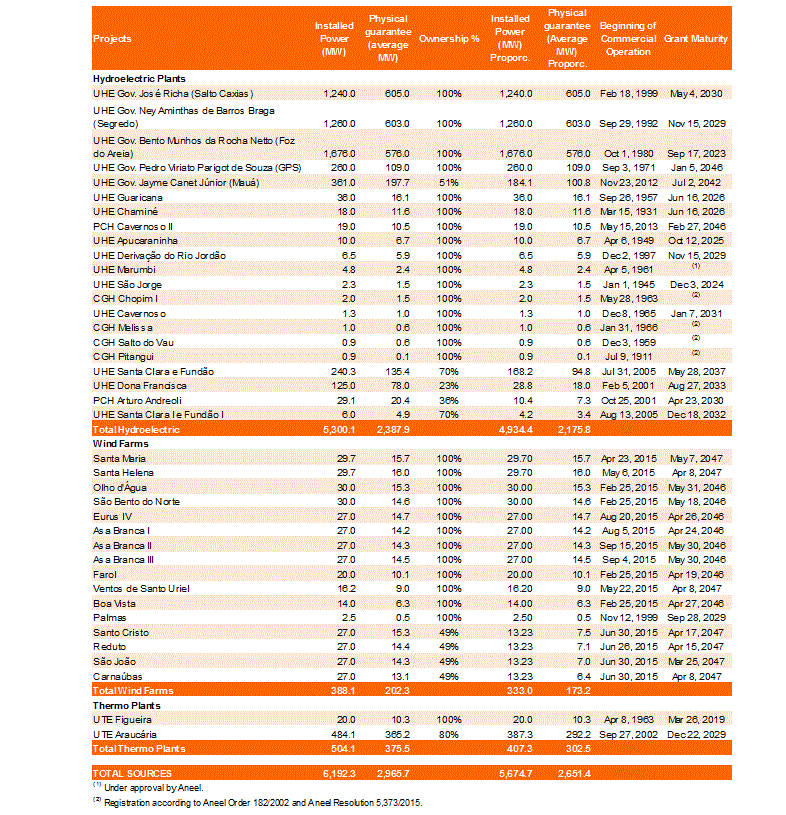
To fulfill important strategic and sustainability guidelines established for the generation business, the Company's main purpose is to profitably and sustainably boost the share of renewable alternative sources in the energy mix.
The composition of the generating park by source is as follows:

Translation:
Generation Park – Physical Guarantee by Source Generation park forecasted for 2019
Physical guarantee by source
Hidroelectric Power Plant
Wind Farms
Thermoelectric Power Plant
Currently, the Company is focusing its efforts on the construction of 15 plants, which will add 737.1 MW of installed capacity and 355.5 MW on average of physical guarantee to the generator park, with 20% of this physical guarantee expected to start the commercial operation during 2017, according to the table:
Power Plant Projects under Construction - Physical Characteristics
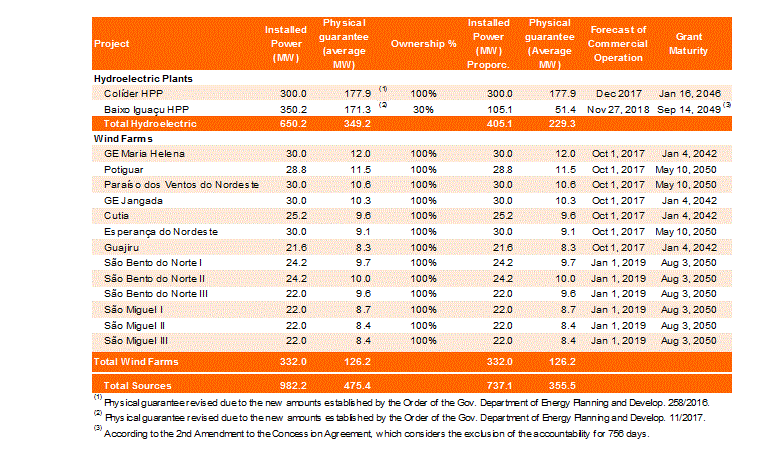
R$3.2 billion were invested in these generation projects up to December 31, 2016, of which R$2.2 billion was until December 31, 2015. Of the total, R$2.4 billion refers to the improvement in fixed assets in progress of our own and consortium plants, and the remainder refers to capital contributions in the companies in which the Company has a stake. The evolution of the generating park with the gradual commercial start-up of the plants under construction can be represented as follows:
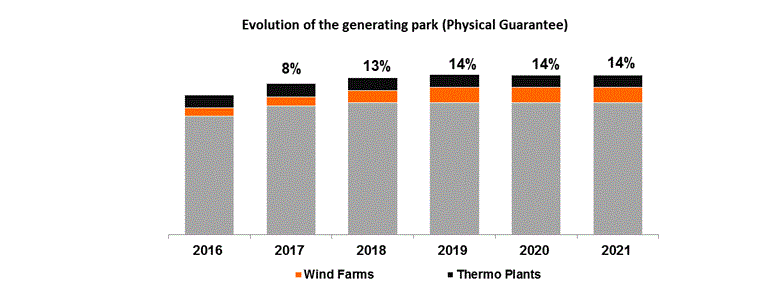
In the segment of electric energy generation, we also highlight:
· Colíder Hydroelectric Power Plant: The plant located in the Teles Pires River, between the cities of Nova Canaã do Norte and Itaúba, in Mato Grosso, had the construction works started in 2011 and should absorb R$2.1 billion in investments. In 2016, the work of suppression of vegetation around the future reservoir was completed and 91% of the construction works have already been completed. The project will have 300 MW of installed capacity, expected to begin its commercial operation in December 2017. Copel Geração e Transmissão won the concession for the implementation and operation of the plant for 35 years in the energy auction held by Aneel on July 30, 2010.
· Baixo Iguaçu Hydroelectric Power Plant: With a 30% interest in the project, the Company estimates to invest R$592.4 million. After the Baixo Iguaçu Entrepreneurial Consortium (CEBI) having carried out actions to meet the additional requirements of the environmental licensing imposed by the Chico Mendes Institute of Biodiversity Conservation (ICMBio - Instituto Chico Mendes de Conservação da Biodiversidade), in February 2016 the construction work resumed fully. Also in August 2016, Aneel formalized the publication of the 2nd Amendment to the Concession Agreement, in order to formalize the redefinition of the schedule of the HPP Baixo Iguaçu , as well as its final closing date, acknowledging in favor of CEBI an exclusion of liability for the delay in the implementation of the project for a period corresponding to 756 days, recommending to the MME the extension of the term of the grant and establishing that the CCEE must promote the postponement of the beginning of the supply period of the CCEARs for the period of the recognized exclusion of liability. The plant will have an installed capacity of 350.2 MW with a 30% stake of Copel Geração e Transmissão in partnership with Geração Céu Azul S.A.
· Governador Pedro Viriato Parigot de Souza Plan:On January 5, 2016, started the concession agreement for operation and maintenance of this plant until 2045. In 2016, 100% of the guaranteed energy of the plant was allocated in quotas for the regulated market, and from 2017 until the end of theconcession, 70% will be allocated to the quota holders of the regulated market, and the concessionaire may freely market the remaining 30% of this energy.
· Modernization of the Figueira Thermoelectric Power Plant: The Company started the modernization work in 2015, in order to increase its efficiency and reduce the emission of gases and particles resulting from the burning of coal. Until the first quarter of 2016, the work developed as it should, but after the second quarter of the same year, as a result of financial difficulties, the company hired to carry out the services showed signs of difficulty to maintain the execution of the activities of the agreement, culminating in the near paralysis of the work. In view of this situation, the Company also began in 2016 the contractual termination process with the contractor, currently in progress. In order to continue the modernization work, Copel is preparing a new bidding process to hire the completion of the work, estimating the completion of the project until the end of the second half of 2017, allowing the commissioning and start-up of the commercial operations at the beginning of 2018.
3.3.2. Transmission
The main responsibility of the segment is to provide electric energy transportation and transformation services, and is responsible for the construction, operation and maintenance of substations, as well as lines for the transmission of energy.
The Company owns and participates in transmission concessions in operation, corresponding to 5,552 km of transmission lines and 44 substations of the basic network with a processing power of 14,602 MVA. Below is the breakdown of transmission lines and substations in operation:
Transmission Lines and Substations in Operation

The transmission concessions in operation on December 31, 2016 are generating a RAP to Copel of R$455.8 million, proportional to its share in the projects.
Currently, the Company is focusing its efforts on the construction of 7 projects, which will add 2,878 kilometers of range and 4,150 MVA of transformation capacity to the set of own and in partnership transmission lines and substations, as follows:
Transmission Lines and Substations Projects - Physical Characteristics
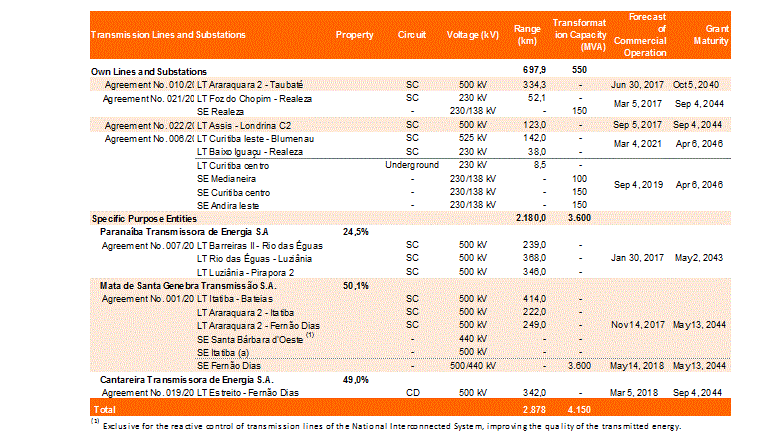
R$1.1 billion was invested in these transmission projects up to December 31, 2016, with R$455.6 million as of December 31, 2015. Of the total, R$622.3 million refers to the increase in own transmission assets and R$509.3 million refers to capital contributions in companies in which the Company has a stake.
· Transmission works:
· LT Araraquara - Taubaté:ProjectLT 500 kV Araraquara 2 - Taubaté, SE Araraquara SE Taubaté, including the implementation of the Transmission Facilities of Lot A - Auction 01/2010. The construction and operation of 330 km of 500 kV Transmission Line, starting at the Araraquara 2 SE porch to the vicinity of SE Taubaté (T-752) and the respective line entrances, bar interconnections and other equipment, will enable an increase of the RAP to Copel of R$20.0 million, amount on the date of the signing of the concession agreement. The project is under construction and forecasted to start operating in 2017.
· LT Foz do Chopim — Realeza: Project LT 230 kV Foz do Chopim — Realeza Sul and SE Realeza Sul 230/138 kV, including the installation of transmission facilities of Lot K - Auction 01/2014, Aneel concession agreement 021/2014. The construction of the 230 substation and of the 53 km 230 kV line will enable an increase of the RAP to Copel of R$5.7 million, amount on the date of the signing of theconcession agreement. The project is under construction and forecasted to start operating in 2017, within the deadline established in the concession agreement.
· LT Assis — Londrina: Project 500 kV Assis - Londrina C2, including the installation of transmission facilities of Lot M - Auction 01/2014, Aneel concession agreement 022/2014. The construction of the 500kV line, a simple circuit and of an extension of 120km between the states of Paraná and São Paulo, will enable an increase of the RAP to Copel of R$15.0 million, amount on the date of the signing of the concession agreement. The project is under construction and forecasted to start operating in 2017, within the deadline established in the concession agreement.
· Lot E - Auction Aneel 005/2015:The auction Aneel 005/2015, Lot E includes a series of projects that are expected to start operating in September 2019 and March 2021. The project will enable an increase of the RAP to Copel of R$97.9 million, amount on the date of the signing of the concession agreement. Lot E has been divided into several projects that are in progress.
In addition to the works won in the auctions promoted by Aneel, Copel has the works coming from the authorizing resolutions in order to expand and improve existing facilities.
· Authorization Resolution 4,890/2014: dismantling 137 km and building 142 km of transmission line in 230 Kv, starting in the porch of SE Figueira and arriving to SE Ponta Grossa Norte and the respective entries of lines and interconnections of bars and other equipment. The planned investment is of R$63.8 million and the RAP of approximately R$9.0 million from the commercial start-up, scheduled for 2017.
· Authorization Resolution 5,711/2016: implantation at the 230 kV Figueira substation - of the first 138 kV - 15 Mvar capacitor bank, with an investment of R$4.8 million and RAP of approximately R$0.8 million from the commercial start-up, scheduled for March 2018.
· Authorization Resolution 5,776/2016: implementation at the 230 kV Sarandi substation - of the second 230/138kV - 150 MVA autotransformer, with an investment of approximately R$14.8 million and RAP of approximately R$2.3 million from the commercial start-up scheduled for October 2018.
· Authorization Resolution 5,834/2016: implementation at the 230 kV Apucarana substation - of the 138 kV - 30 Mvar capacitor bank, with an investment of approximately R$5.5 million and RAP of approximately R$0.9 million from the commercial start-up scheduled for May 2018.
· Authorization Resolution 5,930/2016: implementation at the 500 kV Bateias substation - of a 500 kV - 200 Mvar bank of bar reactor, with an investment of approximately R$30.0 million and a RAP of approximately R$4.3 million from the start-up Scheduled for September 2018.
· Other highlights
On January 25, 2016, the operation of the new power substation in Paraguaçu Paulista, in the southwest region of São Paulo, began. The substation operates at 230 kV and has three single phase transformers of 50 MVA each, totaling 150 MVA of total transformation power. The installation also has a backup transformer for emergency situations. The project includes a 41.5 km long transmission line that connects ParaguaçuPaulista II to another existing substation in the neighboring municipality of Assis. The set has the function of improving the flow of energy from thermal plants to the biomass existing in the region, given the increase in the electricity demand registered mainly in the cities of Presidente Prudente, Assis and Salto Grande. This is the second transmission project in the Company's own assets, outside the borders of Paraná.
With the start-up of commercial operations in July, the Curitiba Norte 230 kV substation in the metropolitan region of Curitiba, and the transmission line with a 31.7 km extension that will connect it to another existing substation called SE Bateias were also completed in 2016. This project will provide to the Company a RAP of approximately R$8.4 million per year.
3.3.3. Distribution
In the scope of the electric energy distribution, Copel Distribuição's main activities are to provide, operate and maintain the infrastructure, as well as to provide related services, described in the Concession Agreement 046/1999, signed on June 24, 1999, extended until July 7, 2045 by means of the Fifth Amendment Term.
Copel Distribuição's activities are aimed at serving more than 4.5 million energy consumers in 1,113 locations in 394 cities in Paraná and one in Santa Catarina, Porto União. The cities of Guarapuava and Coronel Vivida are partially served. In addition to operating and maintaining the installations at voltage levels up to 34.5 kV, it also operates in installations with voltage levels of 69 and 138 kV.
In 2016, new substations and high voltage lines were connected to reinforce the electrical distribution system, improving the quality and increasing the availability of electric energy to consumers. The works of the new substations completed are:
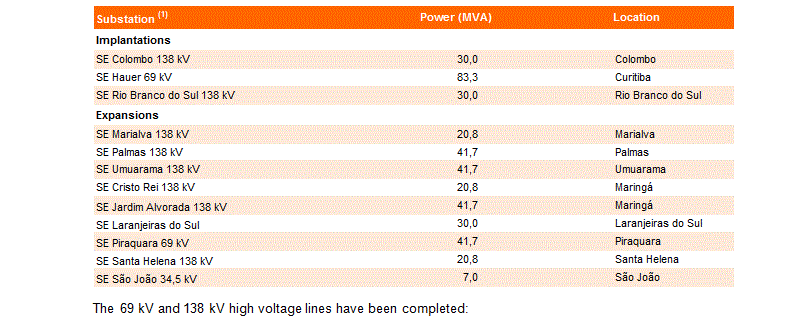
The 69 kV and 138 kV high voltage lines have been completed:

In all, in 2016, these projects have added approximately 416.5 MVA to the distribution system and 84 km of new 138 kV transmission lines.
· Distribution Lines
The following table shows the distribution lines of Copel Distribuição:

· Substations
The following table presents the Copel Distribuição substation park, open for voltage:

· Quality of Supply
Supply quality is measured by indicators that monitor distributors' performance in terms of continuity of service. The Outage Duration Equivalent per Consumer Unit (DEC) measures the number of hours on average that consumers remain without power during a certain period. The Outage Frequency Equivalent per Consumer Unit (FEC) indicates the average number of outages per consumer unit. Based on DEC and FEC, ANEEL establishes individual continuity parameters (DIC, FIC and DMIC) which are itemized in electricity consumers’ monthly bills.
These indicators are reviewed in the Periodic Tariff Review (RTP), and are increasingly becoming stricter in order to improve the quality of customer service. The indicator is established in concession agreements and failing to fulfill the efficiency criterion for quality of service for two consecutive years during the period assessed or in the year 2020, will lead to the concession being canceled.
Copel Distribution's DEC and FEC indicators showed improvement in the number and duration of outages for the year 2015 compared to the previous year, due to more periodic maintenance, preventive inspections, additional facilities and expansion as shown below:
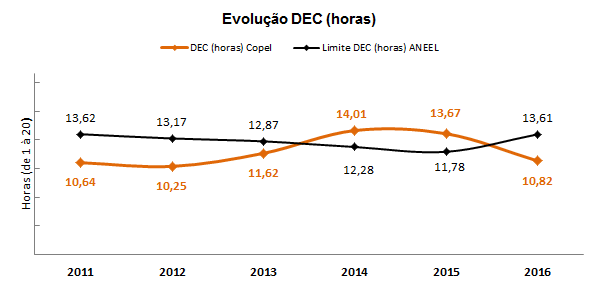
Translation: DEC Evolution (hours)
Hours (of 1 to 20)
DEC (hours) Copel DEC Limit (hours) ANEEL

Translation: FEC Evolution (disruptions)
Disruptions (of 1 to 15)
FEC (disruptions) Copel FEC Limit (disruptions) ANEEL
· Management of energy losses
Energy losses are inherent to the nature of the process of transforming, transmission and distribution of electricity. An analysis of the electricity required to serve consumers must bear in mind that not all electricity generated is delivered to end consumers.
In this context, losses may be segmented between losses in the Basic Grid, which are external to the concessionaire's distribution system and are imminently technical in their origin, and distribution losses that may be of a technical or non-technical nature.
Technical losses refer to the portion of distribution losses inherent to the process of transporting, transforming voltage and measuring electricity in the concessionaire's grid. Non-technical losses mean all other losses associated with the distribution of electricity, such as theft, measuring errors, mistakes in the billing process, consumer units lacking meters, and other issues.
In 2016, overall distribution losses - technical, non-technical and basic network - accounted for 9.6% of the energy injected into the distribution system. This percentage remained in line with the one observed in 2015 and below the levels of recent years.
Copel Distribution runs a program to combat non-technical losses, a factor that is helping to reduce this indicator. The program consists of several measures for reducing or maintaining the current level of non-technical losses, through the following initiatives:
· Constantly mapping the situation of illegal connections for Copel by identifying the areas and number of families using illegal connections;
· Enhancing initiatives to combat irregular procedures, improving the performance of targeted inspections;
· Investments to ensure availability and/or purchase of equipment for inspections;
· Developing and implementing specific training and recycling related to commercial losses;
· Inspections of both medium and low voltage lines; and
· Educational notes in the press and messages added to electricity bills.
Reflecting the high-quality equipment purchased, training for teams and measures related to inspections in the field, the effectiveness of inspections has risen significantly over the last four years from 11.1% in 2012 to 32% in 2016, when there were approximately 46,752 inspections that detected 14,974 irregular procedures. Prospecting target areas before inspections is based on the use of information available in records of consumer units and analysis of niches of fraud in the various classes of consumers.
· Captive market
From January to December the captive market consumption was of 22,328 GWh, with a negative variation of 7.1% in relation to the same period of 2015. The drop in the captive consumption is mainly due to the recession of the economy that began in the second quarter of 2014 and has been worsening since then and also to the migration of 491 consumers to the free market in 2016, which represented a consumption of 1,296 GWh in the year. The number of captive consumers billed by Copel Distribuição in December 2016 was 1.4% higher than in December of last year, totaling 4,478,767 consumers.
The tables show the energy sold and the consumption class in number of consumers:
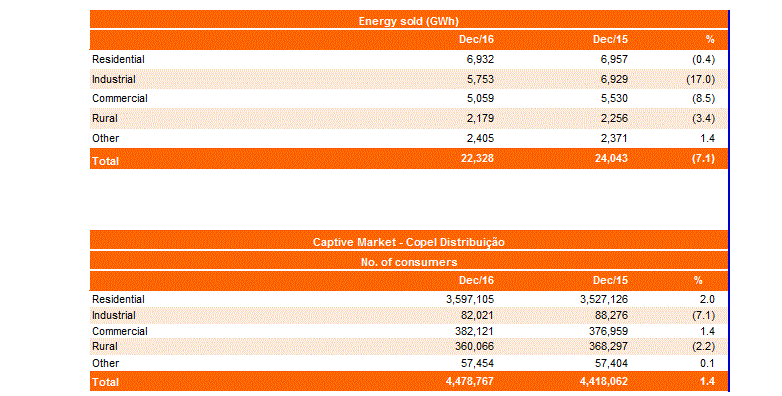
The charts show the participation of the captive market by class, in relation to the consumption of energy and number of consumers:
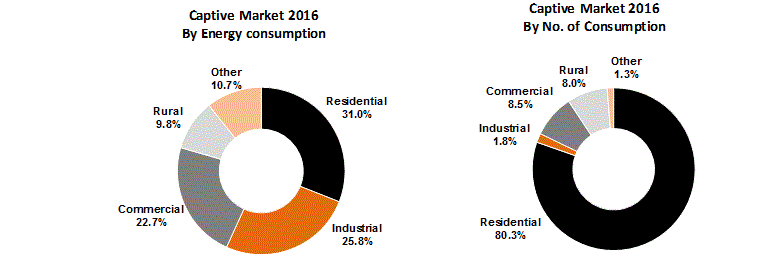
· Wire Market (TUSD)
In 2016, the wire load, which takes into account all consumers who accessed the network of the Distributor, presented a reduction of 2.0%, when compared to 2015. The industrial wire market decreased by 1.4% in the year, with the most significant branches of the industrial class presenting a decrease in 2016 were the "Manufacture of Nonmetallic Mineral Products", "Manufacture of Wood Products" and "Manufacture of Rubber and Plastic Material Products".

· Purchase of Energy
Under the current regulatory reference, the contracting of energy by the distributors mainly occurs through an auction regulated by Aneel. Copel Distribuição participated in the 23rd New Energy Auction (A-5), which took place on April 29, 2016, with a 40.5 MWmed acquisition and a start-up from January 1, 2021 to supply part of the market for 2016 and coming years.
In addition to this event, Copel Distribuição received the compulsory allocation of new physical guarantee quotas from July 2015, from plants that started operating under the quota system under Law 12,783/2013.
The receipt of these quotas, coupled with the low performance of the national economy in the period and the intensification of the migration of customers to the ACL (mainly of special clients) without the corresponding possibility of adjustment of the agreements due to the limitation of the current regulation, were factors that motivated the elevation of the level of energy contracting, beyond the regulatory limits.
The charts show the composition of the volume of the purchase of energy by agreements and by type of source, respectively:
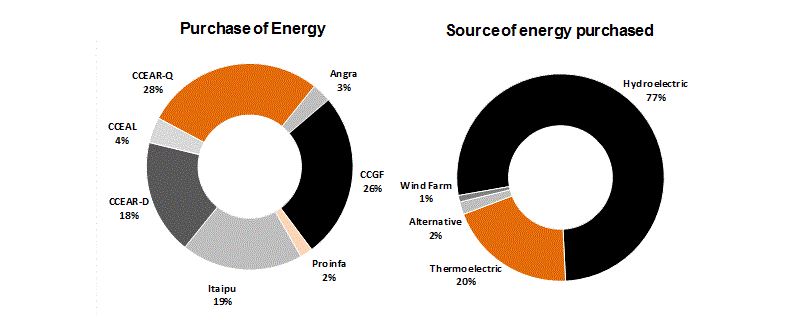
CCEAR-Q - Energy Trading Agreements in the Regulated Environment - By Quantity
CCEAR-D - Energy Trading Agreements in the Regulated Environment - By Availability
CCGF - Physical Guarantee Quota Agreement
CCEAL - Energy Trading Agreements in the Free Environment
Proinfa - Incentive Program for Alternative Energy Sources
· Overcontracting
In the current regulatory model, distributors must acquire the necessary volume to meet 100% of their market through auctions of the Regulated Contracting Environment, which occur at least five, three or one year before the beginning of the energy supply.
The verification on the entire contracting market is carried out observing the period comprised in the calendar year, and the difference between the costs remunerated by the tariff and those effected with the purchase of energy are fully transferred to the captive consumers, provided that the Distribuidora has a level of contracting between 100% and 105% of its market.
However, if distributors reach contracting levels below or above regulatory limits, they can still maintain the neutrality guarantee if it is identified that such violation is due to extraordinary and unforeseeable events, which cannot be managed by the buyer.
In 2016, the distribution segment was exposed to a scenario of generalized overcontracting, as most companies reached a contracting level of more than 105%.
Several measures were implemented to mitigate the overcontracting, given that it was understood that the several factors that contributed to this situation were extraordinary and unavoidable by the distributors, such as the compulsory allocation of physical guarantee quotas and the mass migration of consumers to the free market.
Through Normative Resolution 706/2016, Aneel regulated the recognition of involuntary overcontracting resulting from the reallocation of quotas of physical guarantee of the plants renewed in accordance with Law 12,783/2013.
In March 2016, Aneel opened the Public Hearing 12/2016 in order to obtain subsidies for the definition of mechanisms to adjust the levels of contracting of energy through bilateral agreements between distributors and generators, in order to minimize the impacts of overcontracting. Through the Normative Resolution 711/2016, Aneel established the criteria on which these agreements were allowed. They may involve the temporary reduction, total or partial, of the contracted energy, permanent but partial reduction of the agreement or termination of the agreement.
In July 2016, through Resolution 727, Aneel implemented a new type of Mechanism for Compensation of Surplus and Deficits - MCSD for new energy agreements between distributors and generators, allowing the reallocation of energy among these agents. This mechanism enables the reduction of the overall surplus of the distributors. Three processes of the New Energy MCSD were carried out in 2016. The participation in these MCSDs has helped to mitigate part of the over-contracted energy of Copel Distribuição for 2016.
On June 27, 2016, as a partial result of the Public Hearing 85/2013, Normative Resolution 726/2016 was published. At that time, Aneel confirmed the right of the Distributors to return the volume of energy de-contracted by special consumers, supported by the Legal Opinions 260/2012/PFANEEL/PGF/AGU and 219/2016/PFANEEL/PGF/AGU, as well as the Technical Notes NT 66/2012-SEM/ANEEL and NT 46/2016-SRM/ANEEL. Nevertheless, Aneel's Executive Board established that this possibility would apply only to existing energy agreements signed after the publication of the resolution, thus following the Rapporteur's vote, which justified this proposal, evoking principles of legal certainty and regulatory stability. Aneel understood that any interested distributors should individually request the recognition of their involuntary exposure, showing the use of the other possibilities at their disposal, due to not being included in the Public Hearing and also because it deems improper the judgment of this issue in a general manner.
On August 2, 2016, the Federal Government issued Decree 8,828, exempting over-contracted distributors from penalties, if they did not declare the need to contract energy to replace the agreements matured.
Lastly, on December 28, 2016, through Official Letter 339, Aneel allowed the Distributors to declare in the first Monthly MCSD of 2017 the amounts referring to potentially free customers that migrated to the free market after processing the last Monthly MCSD of 2016.
Copel Distribuição, in turn, sought to use all the tools available to manage the contracting levels, insofar as:
a) Proceeded with the full return, in the Monthly MCSDs, of the amounts of uncontracted energy by potentially free consumers and distributors supplied;
b) Fully declared its surplus, in the MCSD Free Exchanges and New Energy, related to the amounts of surplus energy of quotas of physical guarantee and uncontracted by special consumers;
c) Established negotiations with the generators for the reduction of the agreements, pursuant to ReN 711/2016.
· Tariff Flags
The purpose of the 'tariff flag' system for consumer prices to reflect conditions under which electricity is generated in the SIN by charging additional amounts in the Energy Tariff (TE), thus enabling consumers to vary their consumption as the real price of electricity changed. Green, yellow and red 'flags' show whether electricity costs more or less depending on conditions for electricity generation. Normative Resolution 689/2015 regulates module 6.8 of the Tariff Regulation Procedures (PRORET), which determines commercial procedures for implementing the 'tariff flag' system. 'Tariff flag' amounts are set in a specific document published by ANEEL each calendar year.
The system of 'tariff flags' was regulated by Aneel in December 2012. From July 2013 to December 2014, the 'tariff flags' were disclosed in a didactic manner, without collection, in order to familiarize the consumers with the flags - which were then divided by four sub-markets.
The collection began in January 2015 and, as of March of that year, the submarket division gave way to a single flag for the entire national interconnected system.
The incidence of the red flag during 2015 was due to the strict dry period that the country underwent and that mainly affected the reservoirs of hydroelectric plants and motivated the use of thermoelectric plants to supply the system.
Until February 2015, the tariff flags considered only the variable costs of the thermoelectric plants that were used in the generation of energy. For every 100 kWh consumed (or its fractions), the red flag was of R$3.00 and the yellow one was of R$1.50.
As of March 2015, with the improvement of the system, all generation costs, which vary according to the hydrological scenario, began to compose the calculation of the flags. From March 1, for each 100 kWh consumed (and its fractions), the red flag became R$5.50 and the yellow R$2.50.
From September 1, 2015, the red tariff flag decreased from R$5.50 to R$4.50 per 100 kilowatt-hours (kWh) consumed (or its fractions).
On February 1, 2016, the red flag gained two levels: R$3.00 and R$4.50, applied to every 100 kWh (kilowatt-hour) consumed. Also the yellow flag had its value reduced and went from R$2,50 to R$1,50, applied to every 100 kWh (and its fractions).
The table below shows the history of tariff flags and amounts charged:

· Periodic Tariff Review - RTP
The Periodic Tariff Review process includes analyzing, after a predefined period, the economic and financial balance of the concession. The 1st, 2nd, 3rd and 4th Tariff Review Cycles were carried out every four years and, from the 5th Cycle, started in January 2016, they will be held every five years, in view of the amendment promoted by the fifth amendment to the concession agreement.
The goal of the review is to ensure a fair tariff for customers, adequate remuneration for investors and to stimulate the increase of efficiency and quality of electric energy distribution.
During RTP, the tariffs are repositioned according to the new productivity standards required for the concessionaire and the changes in the cost structure. The average percentage of the tariff repositioning is the ratio of the required revenue, which reflects the efficient operating costs and the adequate remuneration of the investments required to provide the service, and the verified revenue, corresponding to the revenue earned by the concessionaire in the twelve months prior to review, if the rates practiced until then had not been changed. The required revenue is divided in Installment A - which involves the costs related to the acquisition of electric energy, use of transmission systems and sector charges, and Installment B - which are the costs inherent to the energy distribution activity, i.e. the operating and capital costs.
Approval Resolution 2,096/2016, which recognized the results of Copel's fourth Periodic Tariff Review, repositioned the application rates by -12.87%, corresponding to the average tariff effect to be perceived by consumers.
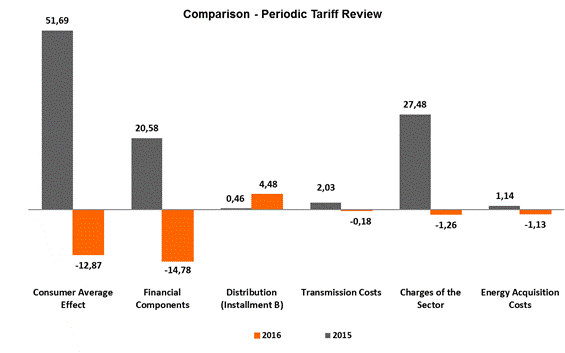
· Regulatory Remuneration Basis - BRR
The BRR corresponds to the amount of investments made by the distributors in the provision of services that will be covered by the tariffs charged by consumers. These assets connected to the concession of the public electric energy distribution service are only eligible to compose the BRR when effectively used in the granted activity.
Pursuant to the provisions of the PRORET (Tariff Regulation Procedures) for the evaluation of the assets of the concessionaires of electric energy distribution, the remuneration base in the current RTP Cycle is calculated considering the remuneration base approved in the previous Cycle ("armored" base), approved by an appraisal report (connected to the existing assets in operation, except for the movements occurred in the period), plus the amounts of the inclusions between the base dates of the previous and current RTP (incremental basis).
Accordingly, at the BRR of Copel Distribuição in the RTP of 2016, according to Normative Resolution 686/2015, it reached the amount of R$4,920.4 million. Total capital remuneration reached R$657.4 million, an actual rate of 12.26% before taxes.
Calculation of the Regulatory Remuneration Base, compensation and reintegration quota
3.3.4. Trading
Copel Comercialização S.A., set in January 2016, was established in the market under the name Copel Energia, working with a specialization in the free market of energy purchase and sale, motivated by the accelerated movement of large consumers to migrate from the regulated market to the Environment of Free Trading - ACL. In addition to operating in the segment of energy purchase and sale, it also offers management services in the free energy market for its customers.
3.3.5. Telecommunications
Copel Telecomunicações provides telecommunications and communications services in general, in the Multimedia Communication Service (SCM) modality, preparing studies and projects focused on meeting the needs of the Company and the market in general. The operation of such services is for an indefinite period, without exclusivity, at national level.
In 2016, the optical network totaled 31,117 km of optical cables, with a growth of 10.7% when compared to 2015, being 10,140 km intercity and 20,977 km urban. This network provides corporate services in 399 cities of Paraná, two in Santa Catarina, with broadband services in 64 cities of Paraná.
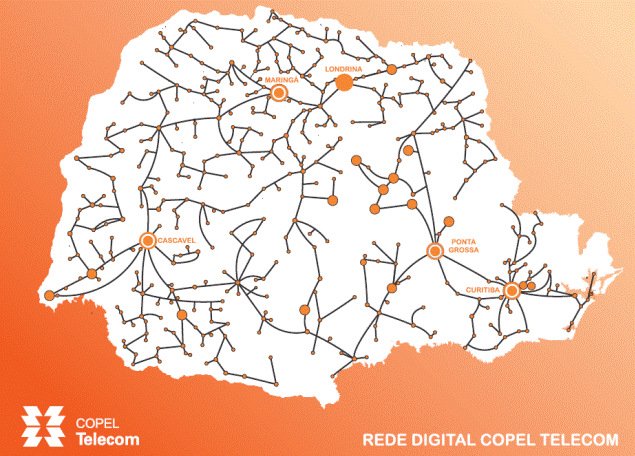
3.3.6. Ownership interests
Copel has ownership interests and associations with companies, consortiums and other institutions operating in various sectors in addition to energy sector. More information on NE 1.1, NE 2, NE 18 and NE 19.7 of the Financial Statements.
4. ECONOMIC-FINANCIAL PERFORMANCE
4.1.1. Net Operating Revenue
In 2016, the Net Operating Revenue had a decrease of R$1,844.1 million, representing a decrease of 12.3% when compared to 2015. This variation is mainly due to:
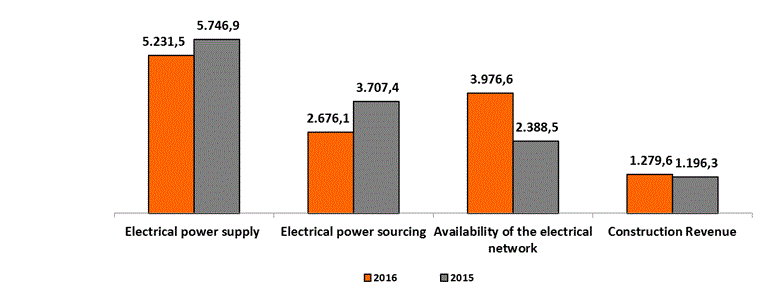
1) Decrease of R$515.4 million in theRevenue from Electric Energy Supply, mainly due to the:
· 7.1% drop in the captive market, basically due to the exit of captive consumers to the free market and the country's economic situation; and
· 12.87% average decrease in the tariff applied from June 2016.
2) Reduction of R$1,031.4 million in theElectric Energy Supply, mainly due to:
· lower amount of PLD in the period; and
· lower revenues in CCEE, due to the non-activation of UEG Araucária.
3) Increase of R$1,588.1 million in theRevenue with Electric Network Availability, mainly due to the:
· recognition of the effects of remuneration due to the remeasurement of the cash flow as a result of MME Decree 120, concerning RBSE assets;
· result of the 4th Tariff Review Cycle, in June 2016, which increased Installment B by 22%;
· partially offset by the drop in the energy market consumption; and
· the average tariff adjustment of -12.87% in the usage tariff.
4) An increase of R$83.3 million in theConstruction Revenue. The Company accounts revenues related to the construction or improvement of the infrastructure used in the provision of services of electricenergy distribution and transmission, which totaled R$1,279.6 million in 2016 and R$1,196.3 million in 2015. The respective expenses are recognized in the statement of income for the period, asConstruction cost, when incurred.
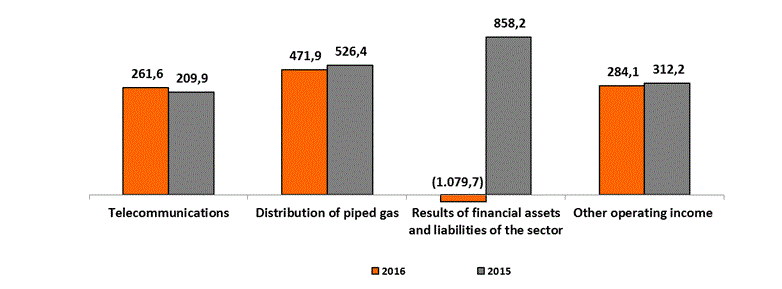
5) An increase of R$51.7 million in theTelecommunications Revenue, mainly due to the increase in the number of customers, especially in the retail market with the Copel Fibra product.
6) Decrease of R$54.5 million inRevenue from Piped Gas Distribution, due to the non-activation of the UEG Araucária and the retraction of the market when compared to the previous year.
7) Negative result of R$1,079.7 million in theResult of financial sector assets and liabilities in 2016, while in 2015 the result was positive in R$858.2 million.
8) Reduction of R$28.0 million inOther Operating Revenue reflecting the lower variation in the fair value of the indemnifying asset of the concession in the amount of approximately R$85.0 million, offset by the increase in services rendered revenues, in the revenues from leases and rent of equipment and facilities and fines applied to customers who migrated from the captive market to the free market.
4.2. Operating Costs and Expenses
· Not manageable
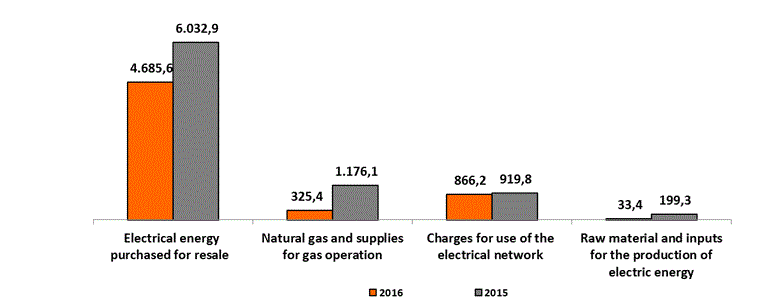
1) Decrease of R$1,347.3 million in theElectric Energy Purchased for Resale, mainly due to the smaller LDP in the period and the impact of the GSF -Generation Scaling Factor (hydrological risk).
2) Reduction R$850.7 million inNatural gas and inputs for the gas operationreflecting the non-activation of the UEG Araucária in 2016.
3) Decrease of R$53.5 million inCharges for the Use of the Electric Network, mainly due to the lower costs with System Service Charges - ESS, offset by the increase in the Charge of reserve electric energy (EER).
· Manageable
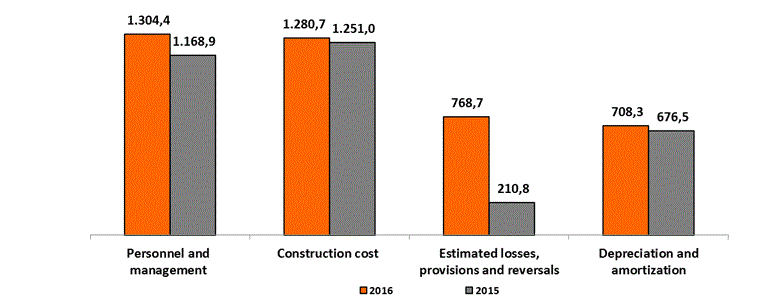
4) Increase of R$135.6 million of the Costs withPersonnel and Management, mainly reflecting the salary adjustment of 9.9% in October 2015 and of 9.15% in October 2016, pursuant to the collective agreement and to the variation of R$38.8 million of the Provision for indemnifications for voluntary resignations and retirements.
5) Increase in theCost of construction, from R$1,251.0 million in 2015 to R$1,280.7 million in 2016.
6) Increase of R$557.9 million inEstimated Losses, Provisions and Reversals, mainly due to the:
· Provision for estimated losses with doubtful accounts, in the amount of R$179.9 million; and
· Reversal of litigation in the amount of R$69.9 million - considered the reversal of R$193.4 million of the Cofins lawsuit.
· Estimated losses for the reduction of the recoverable amount of the asset in the amount of R$581.6 million, divided in the projects:

7) Increase of R$31.0 million inThird-party services, mainly due to the readjustment of agreements for inflation.
8) Increase of R$5.4 million inSocial security and assistance plans arising from the effects of the actuarial valuation, calculated by the actuary hired.
9) Reduction of R$11.3 million inOther operating costs and expenses, mainly due to the change in the method of valuation of Copel's investment in Sanepar, which is now evaluated at fair value while in 2015 it was by the equity method.
4.3. EBITDA

The Company's EBITDA in 2016 was of R$2,752.3 million, a decrease of R$50.5 million when compared to 2015, representing a reduction of 1.8%.
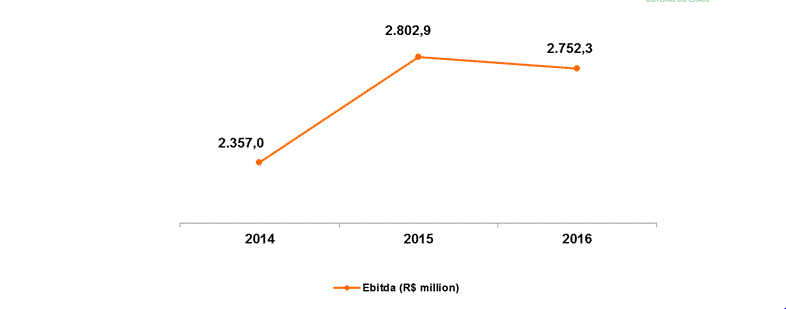
4.4. Financial Result
The financial result showed a decrease of R$237.1 million due to the:
1) 16.5% increase in financial revenues mainly arising from the fees on late payments of energy bills and the higher income from financial investments; and
2) 33.1% increase in financial expenses mainly arising from the higher monetary variation, foreign exchange and debt charges.
4.5. Added Value
In 2016, Copel recorded R$12,746.6 million in Added Value. Total 11.8% lower than the previous year. The variation is mainly due to the decrease in sector charges in 2016. The full statement is available in the Financial Statements.
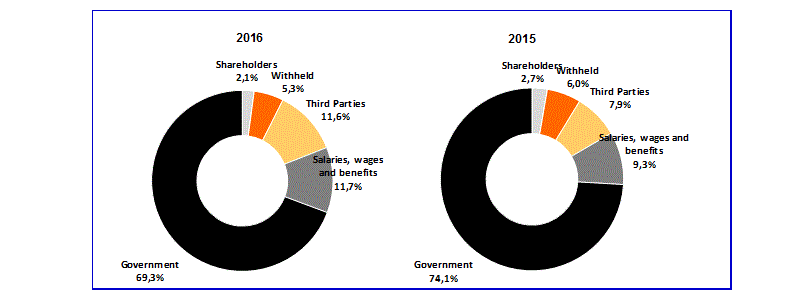

4.6. Debt 
| The Company meets its liquidity and capital requirements primarily with cash from operations and external financing used to expand and modernize business related to generation, transmission, trade and distribution, and telecommunications. An important point to note is that the Company aims to invest in ownership interest using both credit facilities available in the market that make sense for Copel's capital structure in terms of financial leverage compared to returns from projects. It is worth noting that prospects for financing as well as cash and cash equivalents will be sufficient to cover the fiscal year's investment plan. |
In 2016, there were the following outflows of funds: |

Payments made in the year totaled R$1,918.4 million, of which R$1,012.2 million principal and R$906.1 million charges.
The long-term debt repayment schedule, comprising loans, financing and debentures:

4.7. Net Income
In 2016, net income attributable to the parent company's shareholders was R$958.7 million, which was 19.6%, down by R$1,192.7 million against the previous year.
Distribution of dividends and interest on shareholder equity

Of the net income verified in 2016, calculated in accordance with the corporate law, the Company proposes the payment of Interest on Equity in place of the annual dividends, in the gross amount of R$282,947,149.72, distributed as follows: R$0.98539 per common share, R$2.89050 per class "A" preferred share and R$1.08410 per class "B" preferred share.
Payment will becarried out in the fiscal year, pursuant to Paragraph 3 of Article 205 of Law 6,404/1976.
· Shares.......
Volume traded in 2016:

Performance of the share price:

4.8. Non-Paying Consumers
Since 2003, Copel calculates the non-payment rate of the product "electric energy supply", whose calculation methodology considers a non-paying consumer as those overdue past 15 days up to 360 days, in accordance with the notice period (ANEEL Resolution 414/2010), and recognition of losses on past due debits was excluded.
In December 2016, Copel Distribuição's the amount overdue by consumers was of R$267.3 million, equivalent to 1.61% of its revenues, while in 2015 it reached R$272.8 million, 1.81% of revenues.
Although the amount of estimated losses for doubtful accounts - PECLD in the 2016 year is significant, the actions to prevent the non-payment included the short-term non-payment indicators presented by the non-payment indicators of Abradee1 and Corporate2, with a reduction of the non-payment for both when compared to 2015. According to the Abradee criterion, the non-payment rate decreased by 14.5% and the Corporate by 4.7%. The reduction of the non-payment indicators is due to the Company's action plan to prevent the PECLD, with measures that have resulted in the reduction of the non-payment indicators.

1Non-Payment Indicator Abradee Criterion:
I =ΣPending (1 to 90 days) / Revenues 12 months
2Non-Payment Indicator Corporate Criterion:
I =ΣPending energy (16 to 360 days) / Revenues 12 months
4.9. Investment Program
The investment program for 2017 was approved on December 14, 2016 by the 161st ordinary meeting of the BOD. Investments made and planned for 2017 are shown below:

4.10. Research & Development - R&D
Pursuant to Law 9,991/2000, concessionaires, permissionaires and authorized companies of the electric energy sector must annually apply a minimum percentage of their Net Operating Revenue - ROL in projects of Technological Research and Development of the Electric Energy Sector - R&D, according to regulations established by Aneel. R&D projects in the electric energy sector must be original and innovative. In addition to these amounts, is also made a collection to the FNDCT - National Fund for Scientific and Technological Development and the Ministry of Mines and Energy, which in 2016 was of R$40.0 million.
Generation and Transmission
In 2016, it invested R$15.3 million in the execution of 28 R&D projects, of which 4 are strategic, whose themes were established by Aneel through Call for Projects. In 9 projects, it participated cooperatively with other companies. It also applied R$436,000 in the management of R&D projects through the management project.
Distribution
In 2016, R$17.7 million were invested in 31 R&D projects, of which 4 were contracted and 4 were completed during the year, with 27 projects in execution, cooperating with other companies in the electric energy sector in 6 projects, among them three strategic projects whose themes were established by Aneel, through Calls for Projects.
4.11. Energy Efficiency Program - PEE
The Energy Efficiency Program promotes efficiency in the final use of electric energy, through the application of financial resources, establishing a minimum percentage of the Net Operating Revenue - ROL, according to Law 9,991/2000 and Aneel Normative Resolution 556/2013.
Through the PEE, Copel Distribuição carries out the project "A Copel na Comunidade" (Copel at the Community) with the purpose to develop actions for low income consumers, benefiting from the SocialElectric Energy Tariff (TSEE). In this project, lectures are ministered about the safe and efficient consumption of electric energy, energy diagnostics and replacement of equipment using electric energy for more efficient ones.
Based on the result of the energy diagnostics, the selection of the consumers is made to replace, for example, refrigerators and showers for others more efficient. In the latest edition of the Copel project in the Community, aimed at low-income consumers, 500 lectures were held, 39,000 energy diagnostics were made, 118,000 incandescent lamps were replaced for more efficient ones (compact fluorescent and LED), and, in 2017, 5,000 refrigerators will be replaced for new ones with Procel seal of energy saving. These actions aim at engaging the concession area community in actions to preserve natural resources, especially energy.
Copel Distribuição also annually makes public calls for energy efficiency projects, in which the Company's consumers can submit proposals for energy efficiency projects to be funded with the resources of the PEE. Consumers from all areas may participate in the call: industrial, residential (condominiums), commerce and services, public authorities, rural, public services and public lighting. In 2016, R$16.0 million were made available and 38 projects were received, which are being evaluated and selected.
5. HUMAN RESOURCES
5.1. People Management
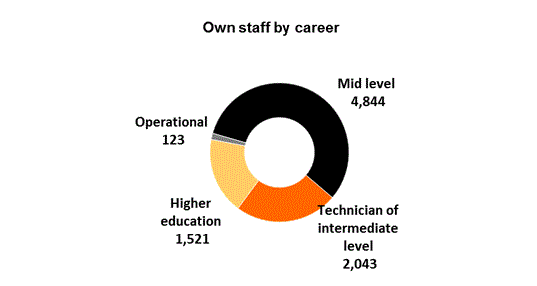 | Considering Copel Holding, Copel Distribuição, Copel Geração e Transmissão, Copel Telecomunicações, Copel Comercialização and Copel Renováveis, the Company has 8,531 employees in its own staff. 95 new employees were admitted in 2016 through a public tender. During the same period, 196 employees left the Company. The turnover rate was of 1.7% in 2016 and 2.4% in 2015. · People Development Copel encourages and promotes the education and development of its employees in order to always count on qualified and experienced professionals, allowing everyone to exercise their potential in an environment that foments the evolution of their career and their abilities. To this end, several educational actions are promoted, ranging from basic training for the exercise of duties up to graduate courses. These actions are organized into corporate programs, training (basic training for the exercise of the function), compulsory training (courses for a specific activities), training for professional improvement and events (seminars, lectures, workshops, congresses, etc.). Copel also offers training for outsourced employees, provided for in an agreement or due to the Company's interest, focused on integration and specific activities to be carried out by the professionals when rendering services to Copel. The Corporate Education model is based on the synergistic and cooperative performance of its Corporate University and the Training Areas of the Wholly-Owned Subsidiaries, focusing on the business competitiveness and profitability. |
In 2016, R$8.8 million were invested in personnel training and development. In all, 2,242 training events were held, with 34,488 participations, totaling 416,298 hours of training, with an average of 48,80 hours of training per employee and 302 participations in long-term events (Language courses and graduate courses).
Corporate education actions (Integrity, Sustainability, Foreign Language Training, Leadership, Preparation for the Future, Integration, among others) are coordinated by UniCopel and aim to build learning focused on areas of knowledge that are directly in line with the Company's skills and business.
The goal of the basic training courses is to empower the employee in a new activity, the same being differentiated only by position or function.
We highlight, in 2016, the implementation of the Distance Learning Platform of Copel, the implementation of the Anima Program, the Leadership Program, the Integrity Program and the Pre-Retirement Seminar.
Distance Learning Platform of Copel
In 2016, there was the unification of the distance learning platforms of Copel, once decentralized and used by the Subsidiaries. This unification's purpose was to optimize the Company's resources, guaranteeing quality and comprehensiveness. The use of the distance learning is already a reality within organizations and we currently have several resources that make learning in this modality effective and interesting.
Due to its coverage capacity, Copel's Distance Learning Platform enables serving a greater number of people, in different locations, as long as they have access to the Internet, without the need for the participant to travel, generating significant savings in out-of-place training of the employee.
Anima Program
In mid-2015, directors and superintendents met to discuss Copel's strategic reference, which resulted in the updating of our mission and vision. At the end of 2015, the same group started the projection movement ofCopel do Futuro (Future Copel): called the Anima Program.
The Anima Program began with an organizational culture diagnosis to collect suggestions that will help to build the movement of change which Copel will undergo. This program has eight projects, which count on the collaboration and participation of all employees.
Transformational Leadership Program
The Transformational Leadership program was structured in line with the Principles of Responsible Executive Education, an initiative of the United Nations Global Pact that stimulates the training of leaders responsible for the business management and the application of knowledge in the day-to-day management, focused on the alignment, integration, shared performance, co-responsibility and increased performance, by the management body.
The educational actions of the program range from in-person training and e-learning modules and address topics such as Leadership, Strategy, People and Team Management, and Management Skills. In addition to addressing deeper issues, the modules bring to the management body knowledge and practices focused onthe needs of the leaders of the 21st century, such as knowing how to live, notion of purpose and self-development.
Pre-Retirement Seminar
Copel, in partnership with Copel Foundation, held the Pre-Retirement Seminar in September 2016, at the Governador Bento Munhoz da Rocha Netto Plant. In order to provide information, guidelines and services to the employees in a position to retire, supporting them in making the decision on the post-career.
The event was held in three days and was attended by around 300 people, including Copelians and their spouses. Lectures on financial and social security education, consumption and savings behavior, entrepreneurship, quality of life and health, as well as leisure activities were held.
Integrity Program
Copel adopts integrity practices in line with the Company's commitment of transparency and fight against corruption. In this sense, in 2016, several trainings were developed to raise awareness about this issue at several levels of the Company.
Other programs
In addition to its own training and qualification programs, the Company encourages the training of its professionals through the following initiatives:
• Educational Aid: benefit that encourages the specialization of employees, reimburses 70% of school fees of employees up to the limit of R$840.46. In 2016, the program benefited 1,064 employees, totaling a reimbursement of R$4.5 million.
• Foreign Language Training Program: a program established in 2012 for employees performing activities in which another language is required. In 2016, 255 employees participated in the program, learning German, Spanish and English.
• Graduate courses: a program focused on the professional development in specific and strategic subjects focused on the production of researches, dissertations, theses, generating innovations and improvements for the Company and for the electric sector. In 2016, ten employees started a graduate course and altogether 47 employees are enrolled in graduate courses atLato sensu andStricto sensu levels.
• Exchanges and Courses abroad: employees participate in events and training abroad, providing constant updating on matters related to the Company's business, as well as exchanges of experiences and discussion of work and research.
· Benefits
In addition to legally required benefits, those directly available for all Copel employees include tuition grants; advances on vacation pay and additional payment of 1/3 of salary in addition to legally required amounts; advance payment of the first portion of the annual bonus (aka 13th salary) in January; profit sharing; quality of life incentives, such as our choir and company games; food and meal vouchers; subsidies for daycare anddisablement and employees with disabled dependents; extended parental leave; supplementary sickness pay; and other benefits provided under an agreement between Copel and Brazil`s Social Security (INSS). Additionally, Copel`s Pension and Social Security Foundation, for which Copel acts as sponsor, runs a private pension plan to supplement official social security as well as health and dental care plans. Copel Foundation also provides a portfolio of loans for participants under legal provisions governing the investment of its pension fund’s reserves.
· Compensation policy
Copel`s practices for compensation, recognition and incentives are based on two pillars: fixed pay (reflecting market levels and individual merit) and variable pay (profit sharing program [PLR]). Copel's employee profit sharing program complies with Federal Law 10,101/2000, State Decree 1,978/2007 and State Law 16,560/2010 and income is distributed equally to all employees. The lowest salary paid by the Company in December 2016 (R$1,736.48) was twice the national minimum wage on that date (R$880.00); in the same period, there was no material difference between men and women in terms of basic salaries paid.
· Labor relations
There are 19 trade unions representing the various classes of workers, and Copel holds meetings with them to discuss matters of mutual interest. In the collective bargaining month (October), this relationship intensifies when unions and Copel discuss demands for the official collective bargaining agreement (ACT), which mitigates any problems with unions or employees. Additionally, any 'just cause' dismissals are preceded by administrative proceedings regulated by internal administrative rules, which assure employee of the right to defense.
· Performance assessment
Copel's performance management program covers organizational competencies and results as well as different approaches in relation to careers, compensation and professional development, such as promotions, meritocracy, vocational aptitudes, lectures or talks, training programs, grants for postgraduate and language course. The program started in 2013 and developed specifically assertive improvements based on the experience of previous cycles and managers and employees’ views on Copel's performance management practices. From each cycle, we aim to learn lessons and make improvements to boost adherence to the company’s culture and reality.
6. SOCIAL AND ENVIRONMENTAL PERFORMANCE
6.1. Suppliers
Copel is a mixed-capital company, subject to Law 8,666/93 and to State Law 15,608/2007. Since the entire supplier selection process is restricted by these laws, the Company does not choose suppliers based on labor, human rights and environmental issues in this process, however, Copel demands compliance with labor and tax legislation in the bidding documents, contractual articles, supplier registration manuals, and standards and technical manuals that are permanently available online.
The social, environmental, human rights and labor issues are addressed by Copel during the integration process, carried out with each new supplier. They are also included in specific articles of agreements for the acquisition of construction works and services. The breach results in the suspension of the agreement and the impediment, for up to two years, of participating in new bids of the Company.
Copel classifies suppliers considered critical by the Company in order to minimize potential risks in the supply of products and services, as well as to better protect the business. The partners are classified based on the identification by Copel of significant risks, considering the following aspects: legal, financial, environmental, occupational health and safety, population safety, image of the company, customer and society perception, and processes.
In the methodology used by Copel, those that are part of the "core" role are understood as critical, even when assessed under the social, economic and environmental dimensions, as well as their scope in the business.
6.2. Customer.......
Copel believes that the sustainability of its business model depends on the ongoing dialogue with several stakeholders: shareholders, consumers, employees, suppliers, government and communities. The relationship with all these groups, with quality and in a transparent manner, is evaluated by the Company as a competitive advantage.
For this reason, Copel maintains a working group dedicated to executing a structured relationship policy, governed by constant planning and activities, with the purpose of guaranteeing levels of excellence of these groups’ satisfaction with the Company.
· Copel Distribuição
In 2016, Copel was recognized for the third consecutive time as the best distributor in the country according to the clients' evaluation. This recognition originates from Abradee's customer satisfaction survey and awards to the winning company the ISQP (Satisfaction with Perceived Quality Index) award. The survey is carried out with about 50 distributors from all over the country.
Abradee also awarded Copel the award of best distributor in the Southern Region, according to the clients' assessment. In addition to this award, the Company carries out a survey with rural clients every four yearsand with clients of the government in the first and last year of the mayors' term. The satisfaction indicator is also monitored by the annual survey carried out by Aneel, focusing on residential customers. Below is the result in 2016:

· Copel Telecomunicações
Copel Telecomunicações carried out periodic opinion surveys since 2008. From 2015 onwards, it adopted the same data collection instrument used by Anatel, which made it possible to compare the results of the Company's quality indicators with those of other companies in the sector.
In 2016, the level of overall customer satisfaction with the quality of multimedia communication services remained high (80.1%), although it oscillated in relation to the previous year (81.3%).
6.3. Community and Environment
The social and economic impacts of Copel's activities are presented in different magnitudes and according to the characteristics of each project and place. Therefore, the Company seeks to work in accordance with the Sustainability Policy and the Code of Conduct, which already incorporate the commitments undertaken with the sustainable development of the United Nations - UN Global Pact, in the principles of Corporate Governance. Having principles like these is important given the need to establish a solid infrastructure of services, such as energy and telecommunications, which hold high potential for the social and economic development of the regions.
This infrastructure favors the emergence or expansion of industrial and business centers and, consequently, increases the job offers and the collection of taxes, becoming benefits and services for the population.
With this driver, observing the need to dialogue with and support several stakeholders, that Copel ensures the efficient relationship with the communities in which this dynamic occurs. This helps the Company in the effort to improve the channels of dialogue in cities impacted by its performance.
The impact assessments on communities are carried out in studies developed during the environmental licensing of each enterprise. In these studies, the impacts are measured according to the characteristics of the place and the project. Through the implementation of the environmental programs, negative impacts are mitigated, leveraging the positive ones, built together with the impacted communities, city government and local leaderships.
The cases of displacement are evaluated through the Socioeconomic Register and, when a situation of social vulnerability is identified, Copel starts the process of family relocation and social compensation for thedamages of the installation of the project. There were no cases of physically displaced people in 2016. Regarding the economic displacement, there were 18 cases.
Colíder HPP
Colíder HPP, which is under the final phase of implementation in the state of Mato Grosso, has a websitehttp://www.copel.com/uhecolider/ for the community to have access to all the reports produced by the programs, with information related to the project, as well as providing a communication channel open to the community. The implementation of the Colíder Plant includes the development of 32 social and environmental programs, with the goal of avoiding, mitigating and compensating for the changes that may occur in the social and natural environments of the region affected by the work.
Program for the Promotion and Monitoring of Sustainable Local Productive Arrangements
Copel is developing a program to support the activities of family farmers residing in the cities around influence of the Colíder Hydroelectric Power Plant, under construction in the north of Mato Grosso. Through this initiative, around 100 properties in Colíder, Itaúba, Nova Canaã do Norte and Cláudia have been receiving monthly technical visits by agronomist engineers who provide guidance to residents on sustainable agriculture, primarily organic, seeking to ensure a qualified production of food and better conditions of life for families.
In addition to this rural technical assistance, training workshops on management, processing and marketing of family agriculture products are also being carried out to improve the conditions for farmers to enter the local productive chain.
· Transmission lines
The installation of transmission lines impacts local communities in the cities where Copel operates. The properties and inhabitants are affected with territorial and productive losses, established by the easement range, as well as with the alteration of aspects of the local natural landscape. The mitigation of the impacts occurs through compensations to the owners for their losses.
Copel has a series of programs and actions of a proactive nature such as meeting the conditions of environmental licensing. Among them, should be highlighted the programs of: Social Communication; Social Interaction or Relationship with Community; Environmental Education for Communities; Local Productive Arrangement, Non-Industrial Fishing Support, Tourism Enhancement, Elaboration of a Master Plan and Social Responsibility of the Colíder Hydroelectric Power Plant; Community Garden - Cultivating Energy; Free Edge, to meet social demands of the reservoir environment; Free Line, to meet demands in occupations for housing or economic purposes under the transmission lines.
· LT 500 kV Araraquara - Taubaté
Copel is currently working on the installation of a 356-km transmission line, impacting a total of 28 cities in the State of São Paulo. The measures to mitigate social and economic impacts include, among others, a Social Compensation Program that provides support for relocation and compensatory measures related toloss of economic activities for the non-owner population impacted by the LT bonding range. In this program, professionals from the company itself working in the social and land area are directly involved in this program, seeking to make possible an adequate and dignified relocation, in agreement with the affected ones. To this end, periodic visits are made to the affected communities and a transparent communication channel is established with the Company. Four more programs targeting local communities are under way.
· Distribution Networks
The most significant social and environmental impacts of the distribution networks (low voltage and 13.8 and 34.5 kV) are accidents with third parties, the management of vegetation under the networks and interference in the urban landscape. To mitigate these impacts, Copel adopts alternative technologies for nets such as the protected compact network, the isolated secondary network, the isolated network and the underground network, and the Urban Forest Program.
Distribution projects do not cause displacement of people. Particularly in the works of High Voltage Distribution Lines (LDAT), there is the compensation for the institution of the bonding range of the Line. This measure does not remove the domain of the area of its owners, but only establishes some restrictions of use and, for that reason, the indemnification. In 2016, 580 people were compensated.
In the processes for the implementation of new projects, Copel carries out the awareness program with the contractors (third parties) who will carry out the works and also the program of relationship with the surrounding community, where explanations are given about the work to be carried out, guidance regarding the attention points due to the construction works, benefits that the works will bring to the community.
· Indigenous community
PCH Apucaraninha was launched in 1949 by Empresa Elétrica de Londrina S.A. and was merged into Copel in 1974. The plant is located within the indigenous reserve of the same name. As a remedy to the damages caused to the Apucaraninha Indigenous Community, Copel signed two TAC Adjustment Terms. The first one, signed in 2002, established the annual payment of financial compensation to the residents of the community for the generation of the plant. The second, concluded in 2006, established the payment of compensation for environmental, cultural and moral damages caused to the community, part of which was distributed to the community and the remainder included in a Fund for the Implementation of the Social, Economic, Environmental and Cultural Sustainability Program for the Apucaraninha Indigenous Community, thus establishing gains for the present and future generations of the community. The latter is under way and is managed by a Management Committee with representatives of the indigenous community and employees of the Company.
In order to reach the indigenous communities located in the environmental conservation units or other areas where it is not feasible to implement the energy distribution network, Copel has developed projects that include new energy connections, promotion of efficient use of electricity, installation of photovoltaic panels in villages located on the coast of the State and new energy connections in communities on the countryside. In 2016, 819 indigenous consuming units were enrolled in the Social Tariff of Electric Energy - Low Income andthere were no cases of violation of the rights of indigenous peoples. For the beginning of 2017, a major operation is scheduled with the indigenous communities of Aldeia Apucaraninha, for inspections of the consumer unit connections, commercial registration and guidance on the safe and conscious use of energy and tariff benefits.
In the case of Copel Renováveis, which installs wind farms only on leased land, there is no interaction with indigenous communities.
· Fraternal Light Program (Luz Fraterna)
The Luz Fraterna Program, by the Government of the State of Paraná, pays the bills of consumers enrolled in the Social Electric Energy Tariff, provided that the consumption does not exceed 120 kWh - an action that represents a positive financial impact among low-income consumers, who are then exempt from electric energy expenses.
· Night Irrigation Tariff Program and Rural Night Tariff Program
Joint programs between Copel, the State Department of Agriculture and Supply - SEAB, Paraná's Institute for Technical Assistance and Rural Extension - Emater and State Department of Environment - Sema. The purpose is to encourage agricultural productivity through a discount of 60% to 70% in the electric energy tariff used for production in the period between 9:30 p.m. and 6:00 a.m., as well as subsidies in the construction/reinforcement of irrigation service networks. Lower values of the energy bill directly reflect the reduction of production costs and make it possible to increase the income of the rural producer. In 2016, around 3,026 farmers benefited from the Night Irrigation Tariff and 8,828 rural consumers from the Rural Night Program.
· Social Electric Energy Tariff
The Social Electric Energy Tariff - TSEE offers discounts on electricity consumption up to the limit of 220 kWh, to families enrolled in the Exclusive Register of Social Programs of the Federal Government, provided that the other criteria set forth in Aneel Resolution 414/2010 are met, resulting in savings for the consumer.
In 2016, 295,000 consumer units with regular benefits were served, representing 8.4% of the total households served by Copel Distribuição.
· Copel Sustainability Seminar
The purpose of the Copel Sustainability Seminar is to share knowledge and experiences on the subject with the internal and external stakeholders and suppliers. It is held annually since 2010 and has as its main goals:
• Contribute to the education and strengthening of the culture for sustainability, bringing to the business environment contents and matters treated systemically and transversally, focused on environmental, social and economic issues;
• Present good practices and contemporary issues of business sustainability;

• Give visibility to projects that have Copel employees and their relationship network in leading roles, focusing on their replicability.
In 2016, the Seminar was reformulated and extended also to the countryside, to the cities of Londrina, Cascavel and Segredo, under the name of "Sustainability Dialogues". The purpose of the Dialogues is to value employees working in the countryside, bringing information and raising awareness about several topics related to sustainability such as: Human Rights, Global Pact, Sustainable Development Goals, Moral Harassment, Sexual Harassment, Ethics, Values and Citizenship Business, Climate Change, Eco-efficiency, Solid Waste, Gender and Race Equity, Accessibility and the dissemination of the Susie Pontarolli Award. Suppliers from each region were also invited to attend and present a case in each region. This new format is also in line with Copel's Ânima Program, especially in the "culture of high engagement and protagonism" and "well-being and full satisfaction of all Copelians".
· Tax Incentives
Copel uses tax incentives to support various cultural (under the Roaunet Law, the Curitiba Patronage Law and the Paraná State Incentive and Cultural Incentive Program), sports (the Sports Incentive Law) or social projects relating to the statute of children and adolescents (Fund for Children and Adolescents [FIA]), the seniors statute (Seniors Fund) or healthcare projects (National Oncology Healthcare Support Program [PRONON] and National Healthcare Support Program for Persons with Disabilities [PRONAS]).
The highlight, in 2016, is the beginning of the term of Profice, encouraging the incentive of cultural projects through the tax exemption of ICMS. Copel has encouraged cultural projects in the areas of theater, music, dance, cultural heritage, among others.
· Corporate Volunteering (EletriCidadania)
The program allows employees to spend up to 4 hours per month of their company time on spontaneously voluntary work for community initiatives that go beyond mere welfare to address sustainable development of all aspects of society, be they cultural, educational or occupational. In 2016, a total of 2,020 volunteer-hours was carried out. | 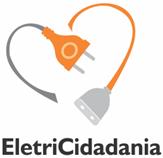 |
· State government housing program (Morar Bem Paraná)
In 2011, Paraná state government issued Decree 2,845/2011 to encourage production and acquisition of new housing units, as well as the upgrading, extension or refurbishing of urban and rural properties, official land title and urbanization for households whose incomes are up to six times the national minimum wage, as well social housing in the state.
Copel's key attribution under the program is to provide electricity distribution grids and utility gateways for consumer units in these housing projects. The initiative is managed by Paraná state's housing company, Companhia de Habitação do Paraná (Cohapar).
In 2016, 4,913 housing units were supported.
· Telemedição Grupo A
Invoicing data are obtained automatically without the need for meter readers, thus improving the quality of the process, eliminating errors and adding value with availability of data for internal processes and on the Internet for customers.
This type of distance measurement enables the automated collection of data in real time (on time), optimizing the process due to the accuracy in the collection, processing and availability of data, including for customers, via the Internet.
This system also can monitor use of electricity by emitting alarms when abnormal situations occur, helping to detect defects or irregular metering procedures (tampering) and reducing Copel's commercial losses.
· Paraná Smart Grid Project
The Smart Grid is a project of the Government of the State of Paraná, inaugurated in 2014, which joins Copel's efforts with the companies Lactec, Tecpar, Sanepar and Compagás, and has the goal of improving the telemetry system.
Telemetry is a system of automatic collection of billing data, without the need of moving a reader to the consumer unit. In the Paraná Smart Grid Project, telemetry points were installed in the urban and rural areas of Curitiba in order to test the technologies.
The main goals of the project are the application of elements of intelligent distribution networks in the concession area; the establishment of a pilot project around high density and visibility and the demonstration of the concept's tests to anticipate future applications.
During 2016, R$3.5 million was invested in the deployment of new equipment in the distribution networks, in reconfiguration systems in the city of Guaíra - PR, in the expansion of monitoring of distributed generation accessories, in the installation of 1,000 energy telemetry in the cities of Bocaiúva do Sul and Campina Grande do Sul, in the support to the installation and monitoring of the recharge electrolyte for electric buses in Curitiba.
· Illuminating Generations Program
The Illuminating Generations Project consists of lectures for students in the 4th year of elementary education in public schools, with an informative and preventive nature regarding the conscious and safe use of electric energy, use of natural resources (energy and water) and correct disposal of waste. To reinforce the information of the lectures given to students, teachers and school employees, a kit with a booklet entitled "The electric energy and you", addressing the points of attention with electric power and use of natural resources, and another, of directed entertainment, called the "Electrical Challenge".
In 2016, the Illuminating Generations Program brought guidelines on the efficient and safe use of energy and sustainability to more than 56,000 students in Paraná.
· + Clic Rural Program

Launched in 2015, it aims to improve the quality of the electricity supply in the rural area, focusing on integrated farming activities with productive processes that are sensitive to disruptions. The program will provide to rural producers the electricity equivalent to that of large urban centers. To do so, Copel will implement an intelligent network technology consisting of 3,000 km of new networks, around 30 substations and the installation of 3,500 automated reclosers, as well as investments in telecommunications. The works focus on two points: improving the infrastructure to increase the quality of the energy supply; and automation technologies to restore the system much faster in the event of an outage. |  |
Altogether, the Mais Clic Rural will directly benefit about 70,000 producers from Paraná. The main beneficiaries will be tobacco growers, aviaries, pig farmers and milk producers in the state, agro-industrial niches that are more sensitive to the quality of energy supply. However, the expectation is that the investments in the electricity network will indirectly benefit 2.4 million people from rural and urban areas.
In 2016, investments were made in the amount of R$43.0 million for new technologies in automation and communication systems, substations of 34.5/13.8 kV and improvement and reinforcement works in the network. In the pilot project carried out in the city of Salto do Lontra, where a Chaves station was implemented and investments in network automation systems were made, there was a reduction of 70% in the equivalent duration per consumer (DEC) of the city.
In the other places where the investments were made, there were 30 to 60% improvements in quality indicators.
In 2016, the Rural DEC assessed was of 5.00 Hours, reduction of approximately 23% when compared to 2015.
· More Than Energy Project
Created in 2014, it aims to implement, expand and consolidate the social investment projects and programs for the community. In the first project, the funds came from the BNDES Social Investments (ISE) line, in an amount of R$0.8 million and the goal was to support institutions and schools for deaf and/or deaf-blind people. In 2016, through a bidding process, the hiring of a specialized company was carried out for the execution of the architectural and complementary projects of the first two institutions selected by the project. For the beginning of 2017, the bidding process is planned to hire the companies who will carry out the works planned in the projects. |  |
· Solidarity Invoice Project
Project launched in 2015 in order to expand the number of consumers receiving their energy bills via emailand thus benefit the Associations of Parents and Friends of the Exceptional of the State of Paraná - APAEs. For every person who chooses to receive the bill by email, Copel donates R$1.00 to APAEs.
· Cultivar Program
| The goals are to implement community gardens in Copel's power lines, in partnership with the city's governments and communities. Through the social occupation of idle spaces, the purpose is to promote inclusion, food security and income generation. In addition, the program contributes to the community's safety as it has the potential to inhibit irregular and dangerous occupations under power lines. |
The first under-line community garden of Copel was inaugurated in 2013 as a pilot project in partnership with the City of Maringá. With the first positive results, other gardens were made possible and are currently benefiting around 140 families from three different communities of that city. In 2016, procedures and standards were established for the implementation of community gardens in properties under power lines, owned or in which Copel has established a bonding. By 2017, it is planned the expansion of community gardens to other cities in the state besides Maringá. · Collection of Third Party Amounts ??- CVT | 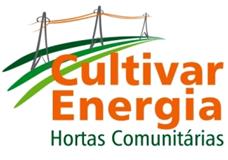 |
Includes the collection of donations through the energy bill for philanthropic-contractors with Copel Distribuição. The amounts to be included must have a written authorization, or through voice recording, of the holder of the energy bill or its spouse. The limits for donations are minimum R$1.00 and maximum R$1,500.00.
In 2016, there were 208,000 donors/month, with a monthly average collection of R$1.9 million, distributed among 120 philanthropic institutions.
· Reservoirs and water quality
In its reservoirs and environments, Copel monitors possible environmental interventions. The company works in accordance with specific actions to address irregularities identified, such as effluent discharge, slope stability, use and occupation of Permanent Protection Areas (APPs), hunting and illegal fishing, etc. To support this process of preservation and other areas of relevant environmental interest, the Company has an agreement with the Environmental Police of the State of Paraná. It actively participates in the Hydrographic Basin Committees and the National and State Council of Water Resources, carrying out a real-time monitoring of the water quality and of the hydrological situation of the rivers where it has reservoirs.
Copel's main impact on water resources is the alteration of its natural conditions and the vegetation of the flood basin of hydroelectric plants. Therefore, the Company acts in the management of the social andenvironmental impacts of its projects - from their construction to the operation phase. To this end, it carries out studies, mitigates impacts and risks, in accordance with relevant environmental legislation. The company collects and analyzes water samples quarterly to monitor their quality. 25 physical, chemical and biological parameters are monitored. Copel also monitors the water quality prior to the start of the construction of a new project. These monitoring include the analysis of sediment and agrochemicals.
· Ecosystem
The implementation and operation of projects have caused direct and indirect negative impacts on the fauna and flora located in the area affected. The environmental studies prepared before the installation evaluate and classify these impacts, in order to propose the social and environmental programs necessary to mitigate the negative impacts and leverage the positive ones.
Hydroelectric generation projects
For the construction of hydroelectric generation projects, the material direct and indirect impacts on biodiversity are:
- Reduction of important species to the local ecosystem, due to the suppression of vegetation in the basin of accumulation.
- Conversion of habitats, caused by the river barring for the creation of the reservoir.
- Changes in the ecological processes outside the natural range of variation: due to the river barring for the creation of the reservoir.
- The mitigation of the impacts is done with the implementation of vegetation suppression programs, monitoring and rescue of flora and fauna, recovery of Permanent Preservation Areas, forest restoration, monitoring and archaeological rescue, among others.
Wind farms projects
The direct and indirect impacts on biodiversity during the construction of wind farms, such as the reduction of flora species and the risk of bird accidents, are mitigated by the implementation of environmental programs. This is necessary because the projects can have positive, negative, direct and indirect impacts.
In wind farms, no significant impacts on biodiversity were identified that could not be mitigated, considering the magnitude of the works and their locations. For the projects under construction, the impacts related to the vegetation management, such as the fragmentation and edge effect generated by the suppression of the vegetation and loss of habitats, besides the increase of the risk of accidents with the fauna and risks of the increase of hunting activities. The most significant impacts on regional biodiversity are of a negative nature and come mainly from the suppression of local vegetation for the implementation of wind farms.
In order to mitigate the impacts identified during the licensing stages, Copel Renováveis asked the companies involved in the construction of the wind farms that, during the suppression activities, campaigns to remove and rescue the fauna were carried out, as well as a Rescue and Handling Program of Species Melocactus violaceus and Griffinia gardneriana. The purpose of these actions is to ensure that the impactson biodiversity, especially local species, are minimized.
Transmission and distribution projects
The reduction of flora species, caused by the suppression of vegetation in the bonding range, is the main negative aspect, directly and indirectly, on the biodiversity represented by the construction of transmission and distribution projects.
Copel's commitment to its sustainability matrix is to mitigate these impacts. This begins in the planning and licensing phase of the projects, through detailed and multidisciplinary studies of the alternatives with the smallest impacts, prioritizing the use of previously altered areas where the environmental and social fragility is lower.
In places where the project must necessarily go to certain areas more preserved, the Company places higher towers in the bonding range to minimize impacts.
Copel also implements environmental programs in the areas of forest replanting, preservation of slopes in areas with fragile soils and springs, removing and rescuing fauna and flora, among others.
Preventive and mitigatory measures in the energy distribution line projects, for example, observe the vegetation management, the fragmentation and the edge effect caused by suppression of vegetation in transit lanes, habitat losses, bird collision, interference in the use and occupation of the ground, the increase of the noise levels and the interference in the daily life of the affected population.
· Urban Forests Program
Copel has supported Cities in the planning of afforestation of public roads since 2007, contributing to the environmental improvement and reducing interruptions in the energy supply caused by the collision of trees to electrical systems.
The initiative focuses on the production of seedlings in the Company's forestry horticulture. With this, in addition to the support to interested cities, compensatory measures are taken care of. More than 40,000 seedlings have already been planted in the afforestation of streets.
After the reformulation of the program in 2015, with changes in the procedure for the supply of seedlings, the procedures were started with 20 cities to supply more than 6,000 seedlings. In 2016, 2,545 seedlings of arborization were delivered to seven cities of Paraná.
· Forest Compensation
Since 2012, Copel has an agreement with the Environmental Institute of Paraná through which it assigns outsourced workers to dedicate exclusively to the production of native forest seedlings. These seedlings are used in the restoration of Permanent Preservation Areas, Legal Forest Reserves and Forest Replenishment Areas of the State of Paraná.
The action helps the Company to plant thousands of trees to compensate for the environmental impact of its activities. In 2016, the reforestation was carried out through the donation of seedlings for third-partyplantations and plantations in urban areas, with 400 native forest seedlings and 2,434 urban afforestation seedlings. The initiative is part of the environmental compensation for cutting vegetation in power distribution lines in the State of Paraná.
During this same period, 23,000 native forest seedlings were planted in the Ibicatu State Park, totaling 6 hectares for the environmental compensation of the project LT 230 k: V LON - FRA. Over 1,455 seedlings were planted in urban afforestation as a mitigation of the project LT 230 k: V BTA - CTN. The Company also donated 1,615 seedlings to the City Hall of Campo Largo, as a compensation for these projects.
In the State of Mato Grosso, approximately 60,000 seedlings of native species were planted in the Permanent Preservation Area of the future reservoir of the Colíder HPP, totaling 59 hectares of reclaimed area in 2016.
In the State of São Paulo, where it implements transmission lines, the company offset the impact of the project by transferring 870 native seedlings to third parties and replanting 6,500 by Copel.
· Carbon Credit Project
Elejor started its carbon credit account in October 2000. Under the name of Fundão Santa Clara Energetic Complex Project (FSCECP), its Project Design Document Form (PDD) was approved by the United Nations Framework Convention on Climate Change (UNFCCC/ONU) in 2008.
Certified Emission Reductions (CER) are commoditizedand in most cases prices follow BlueNext (www.bluenext.eu), which records all purchase and sale transactions worldwide. Their prices fluctuate in the same way as shares on a conventional stock exchange. The project is valid for 21 years and is reviewed every seven years under current Kyoto Protocol rules.
7. SOCIAL BALANCE SHEET
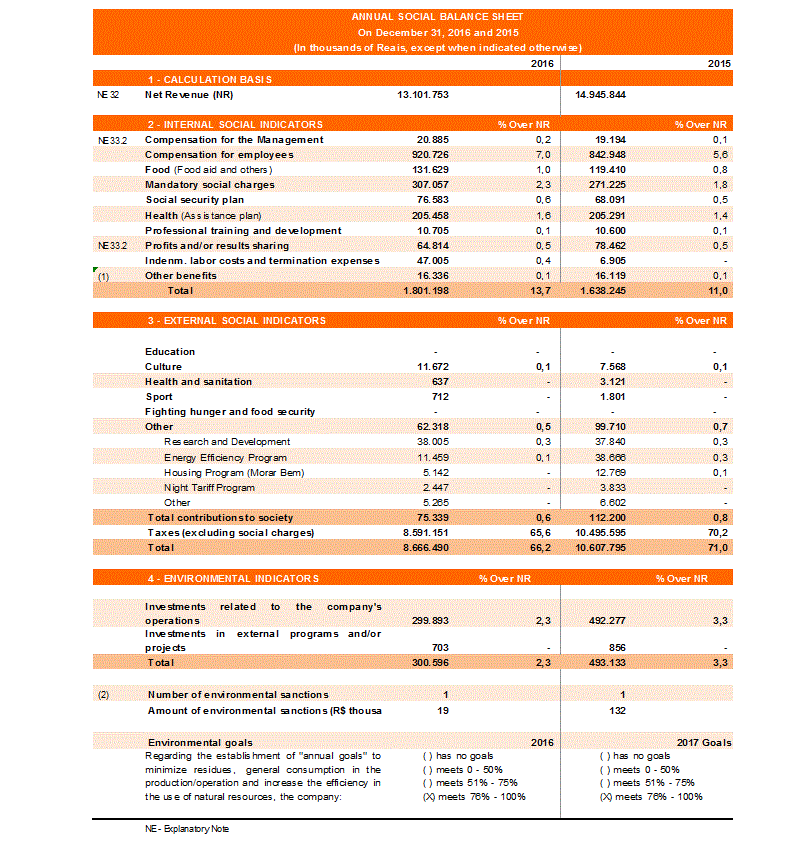

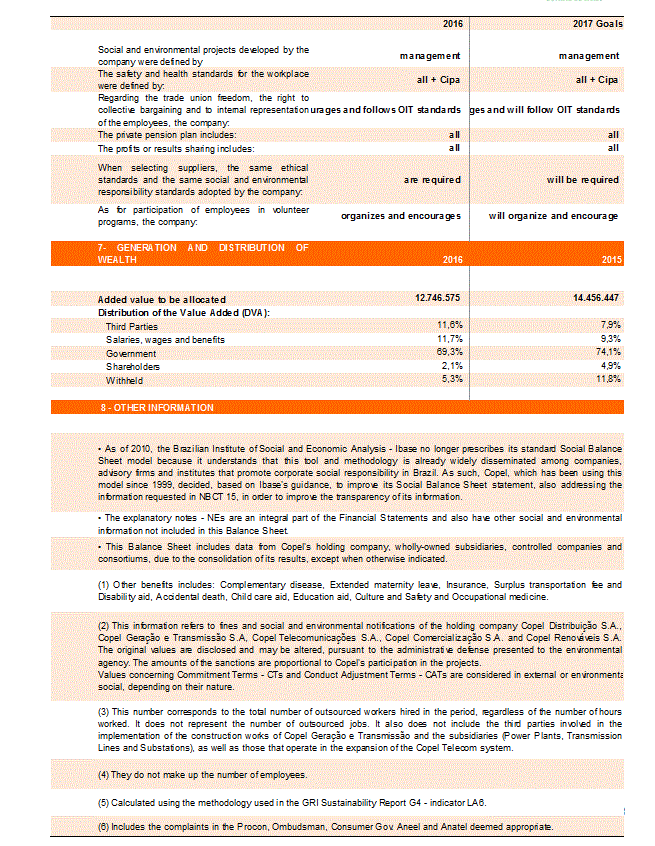
8.
COMPOSITION OF GROUPS RESPONSIBLE FOR GOVERNANCE
BOARD OF DIRECTORS | |
Chairman | Fernando Xavier Ferreira |
Members | ANTONIO SERGIO DE SOUZA GUETTER Mauro Ricardo Machado Costa José Richa Filho CARLOS HOMERO GIACOMINI SANDRA MARIA GUERRA DE AZEVEDO SERGIO EDUARDO WEGUELIN VIEIRA Marlos Gaio Hélio Marques da Silva |
AUDIT COMMITTEE | |
Chairman | CARLOS HOMERO GIACOMINI |
Members | JOSÉ RICHA FILHO Mauro Ricardo Machado Costa |
FISCAL COUNCIL | |
Chairman | VACANT POSITION |
Sitting Members | George Hermann Rodolfo Tormin Nelson Leal Junior Massao Fabio Oya João Carlos Flor Junior |
Alternate Members | Osni Ristow Roberto Brunner Gilmar Mendes Lourenço AURELIO BELARMINO BARBOSA Vinícius Flor |
EXECUTIVE BOARD | |
CEO | ANTONIO SERGIO DE SOUZA GUETTER |
Business Management Officer | Gilberto Mendes Fernandes |
Finance and Investor Relations Officer | Luiz Eduardo da Veiga Sebastiani |
Business Development Officer | jonel nazareno iurk |
Institutional Relations Officer | Cristiano Hotz |
Governance, Risk and Compliance Officer | FABIO MALINA LOSSO |
Deputy Officer | PAULO CESAR KRAUSS |
| |
ACCOUNTANT | |
CRC-PR-041655/O-6 | NANCY ATENALIA ALVES |
| |
More details on this report: | |
Investor Relations: | Phone: +55 (41) 3222-2027 ri@copel.com |

Companhia Paranaense de Energia
Corporate Taxpayer's ID (CNPJ/MF) 76.483.817/0001-20
State registration 10146326-50
Publicly-Held Company- CVM 1431-1
www.copel.com copel@copel.com
Rua Coronel Dulcídio, 800, Batel - Curitiba - PR
CEP 80420-170
FINANCIAL STATEMENTS
2016
(CONVENIENCE TRANSLATION INTO ENGLISH FROM THE ORIGINAL PREVIOUSLY ISSUED IN PORTUGUESE)

| SUMMARY |
| | | | | |
| FINANCIAL STATEMENTS | | 3 |
| Statements of Financial Position | 3 | |
| Statements of Income | 5 | |
| Statements of Comprehensive Income | 6 | |
| Statements of Changes in Equity | 7 | |
| Statements of Cash Flows | 8 | |
| Statements of Added Value | 10 | |
| NOTES TO THE FINANCIAL STATEMENTS | | 12 |
| 1 | | Operations | 12 | |
| 2 | | Concessions and Authorizations | 14 | |
| 3 | | Basis of Preparation | 17 | |
| 4 | | Significant Accounting Policies | 19 | |
| 5 | | Cash and Cash Equivalents | 39 | |
| 6 | | Bonds and Securities | 40 | |
| 7 | | Trade Accounts Receivable | 41 | |
| 8 | | CRC Transferred to the State Government of Paraná | 43 | |
| 9 | | Net Sectorial Financial Assets and Liabilities | 43 | |
| 10 | | Accounts Receivable Related to the Concession | 48 | |
| 11 | | Accounts Receivable Related to Concession Compensation | 51 | |
| 12 | | Other Receivables | 52 | |
| 13 | | Taxes | 53 | |
| 14 | | Prepaid Expenses | 58 | |
| 15 | | Receivables from Related Parties | 60 | |
| 16 | | Other Temporary Investments | 62 | |
| 17 | | Judicial Deposits | 63 | |
| 18 | | Investments | 63 | |
| 19 | | Property, plant and equipment | 68 | |
| 20 | | Intangible assets | 78 | |
| 21 | | Payroll, Social Charges and Accruals | 81 | |
| 22 | | Suppliers | 82 | |
| 23 | | Loans and Financing | 83 | |
| 24 | | Debentures | 88 | |
| 25 | | Post-employment benefits | 90 | |
| 26 | | Customer Charges Due | 96 | |
| 27 | | Research and Development and Energy Efficiency | 96 | |
| 28 | | Accounts Payable Related to Concession | 97 | |
| 29 | | Other Accounts Payable | 98 | |
| 30 | | Provisions for Legal Claims | 98 | |
| 31 | | Equity | 106 | |
| 32 | | Net Operating Revenue | 110 | |
| 33 | | Operating Costs and Expenses | 114 | |
| 34 | | Financial Results | 118 | |
| 35 | | Operating Segments | 118 | |
| 36 | | Financial Instruments | 122 | |
| 37 | | Related Party Transactions | 137 | |
| 38 | | Insurance | 140 | |
| INDEPENDENT AUDITOR S REPORT | | 142 |
| SUMMARY OF THE STATUTORY AUDIT COMMITTEE S ANNUAL REPORT | | 147 |
| SUPERVISORY BOARD S OPINION ON THE ANNUAL MANAGEMENT REPORT | | 149 |
| CAPITAL BUDGET PROPOSAL | | 150 |
| STATEMENT | | 151 |
(CONVENIENCE TRANSLATION INTO ENGLISH FROM THE ORIGINAL PREVIOUSLY ISSUED IN PORTUGUESE)

FINANCIAL STATEMENTS
Statements of Financial Position
as of December 31, 2016 and 2015
All amounts expressed in thousands of Brazilian reais
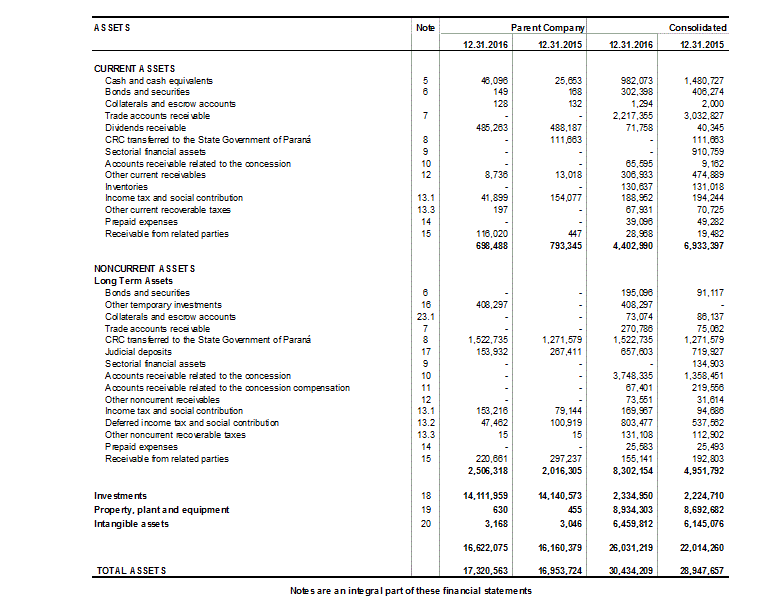
3
(CONVENIENCE TRANSLATION INTO ENGLISH FROM THE ORIGINAL PREVIOUSLY ISSUED IN PORTUGUESE)

Statements of Financial Position
as of December 31, 2016 and 2015 (continued)
All amounts expressed in thousands of Brazilian reais

4
(CONVENIENCE TRANSLATION INTO ENGLISH FROM THE ORIGINAL PREVIOUSLY ISSUED IN PORTUGUESE)

Statements of Income
For the years ended December 31, 2016 and 2015
All amounts expressed in thousands of Brazilian reais , unless otherwise stated

5
(CONVENIENCE TRANSLATION INTO ENGLISH FROM THE ORIGINAL PREVIOUSLY ISSUED IN PORTUGUESE)

Statements of Comprehensive Income
For the years ended December 31, 2016 and 2015
All amounts expressed in thousands of Brazilian reais
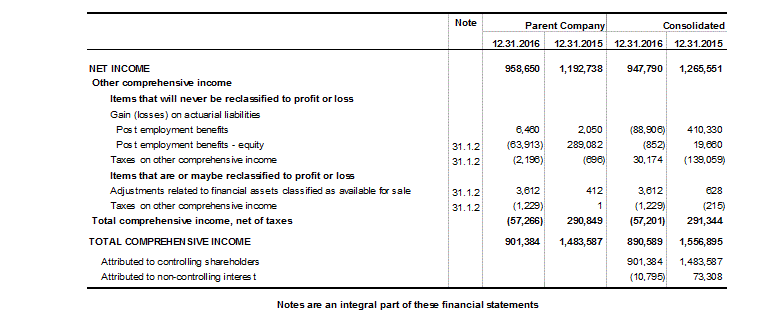
6
(CONVENIENCE TRANSLATION INTO ENGLISH FROM THE ORIGINAL PREVIOUSLY ISSUED IN PORTUGUESE)

Statements of Changes in Equity
For the years ended December 31, 2016 and 2015
All amounts expressed in thousands of Brazilian reais
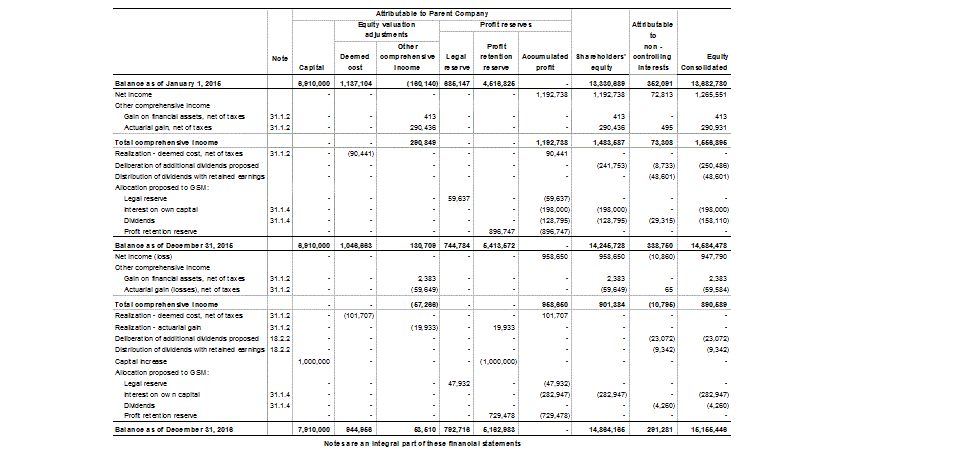
7
(CONVENIENCE TRANSLATION INTO ENGLISH FROM THE ORIGINAL PREVIOUSLY ISSUED IN PORTUGUESE)

Statements of Cash Flows
For the years ended December 31, 2016 and 2015
All amounts expressed in thousands of Brazilian reais
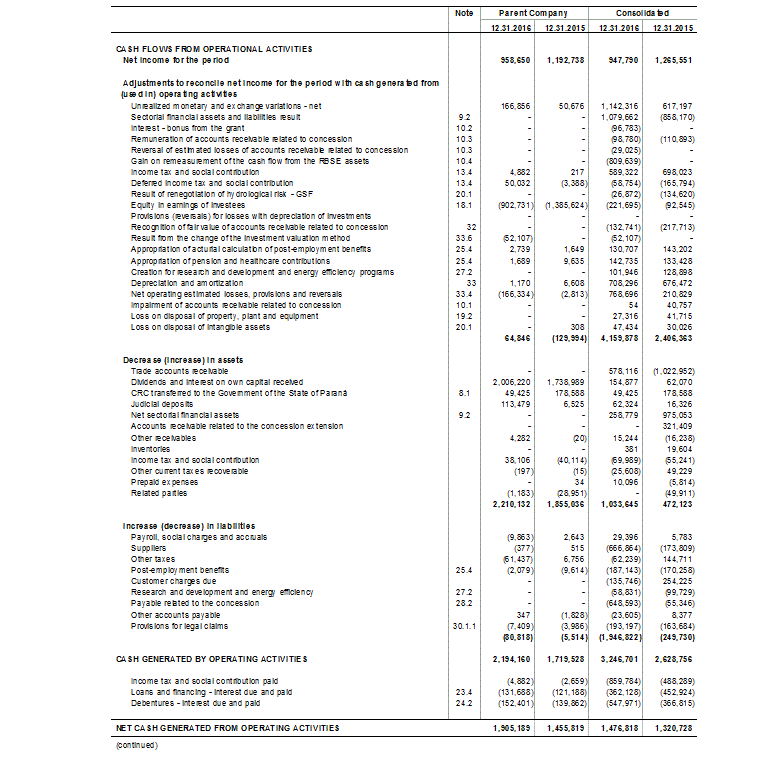
8
(CONVENIENCE TRANSLATION INTO ENGLISH FROM THE ORIGINAL PREVIOUSLY ISSUED IN PORTUGUESE)

Statements of Cash Flows
For the years ended December 31, 2016 and 2015 (continued)
All amounts expressed in thousands of Brazilian reais
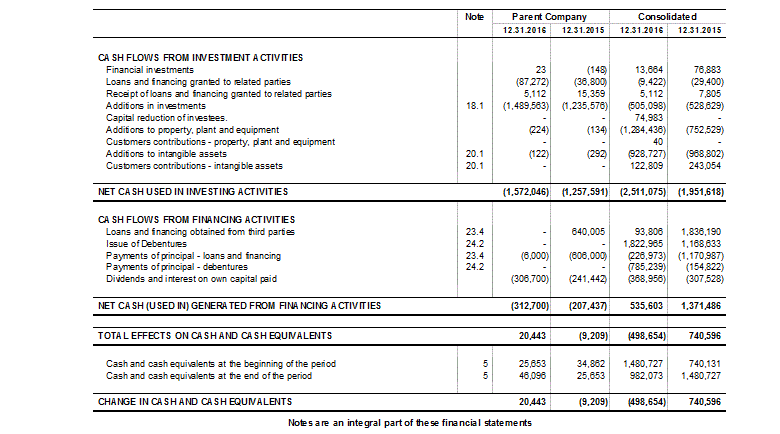
9
(CONVENIENCE TRANSLATION INTO ENGLISH FROM THE ORIGINAL PREVIOUSLY ISSUED IN PORTUGUESE)

Statements of Added Value
For the years ended December 31, 2016 and 2015
All amounts expressed in thousands of Brazilian reais

10
(CONVENIENCE TRANSLATION INTO ENGLISH FROM THE ORIGINAL PREVIOUSLY ISSUED IN PORTUGUESE)

Statements of Added Value
For the years ended December 31, 2016 and 2015 (continued)
All amounts expressed in thousands of Brazilian reais
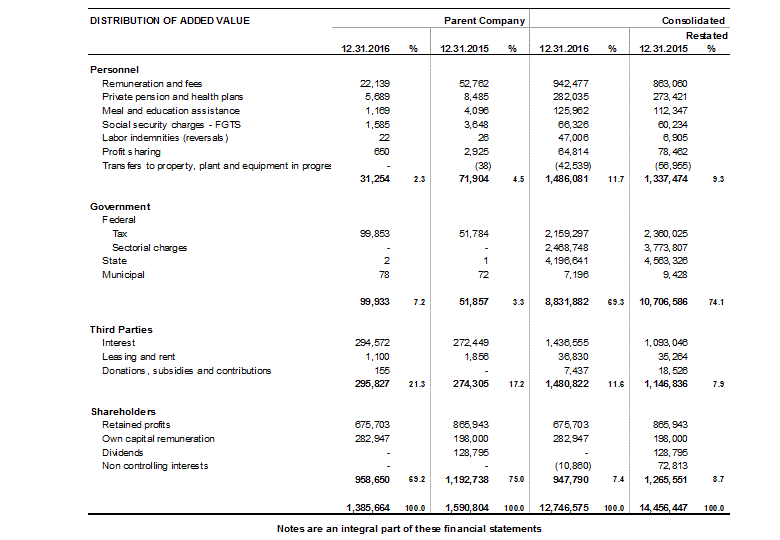
11
(CONVENIENCE TRANSLATION INTO ENGLISH FROM THE ORIGINAL PREVIOUSLY ISSUED IN PORTUGUESE)

NOTES TO THE FINANCIAL STATEMENTS
For the years ended December 31, 2016 and 2015
All amounts expressed in thousands of Brazilian reais, unless otherwise stated
1 Operations
Companhia Paranaense de Energia (Copel, Company or Parent Company), with its headquarters at Rua Coronel Dulcídio, 800, Curitiba - State of Paraná, is a publicly-held mixed capital company controlled by the State of Paraná and its shares are traded on Corporate Governance Level 1 of the Special Segments Listing of the BM&FBOVESPA – Securities, Commodities and Futures Exchange, on the New York Stock Exchange (NYSE) and on the Madrid Stock Exchange in the Latin American segment (Latibex).
The core activities of Copel and its subsidiaries, regulated by the Brazilian Electricity Regulatory Agency (Aneel), linked to the Ministry of Mines and Energy (MME), is to research, study, plan, build and explore the production, transformation, distribution and trading of energy in any of its forms, primarily electricity. Furthermore, Copel participates in consortiums and in private sector and mixed-capital companies for the purpose of engaging in activities, primarily in the fields of energy, telecommunications, and natural gas.
1.1 Copel’s Equity Interests
Copel has direct and indirect interests in subsidiaries (1.1.1), joint ventures (1.1.2), associates (1.1.3) and joint operations (1.1.4).
12
(CONVENIENCE TRANSLATION INTO ENGLISH FROM THE ORIGINAL PREVIOUSLY ISSUED IN PORTUGUESE)

1.1.1 Subsidiaries
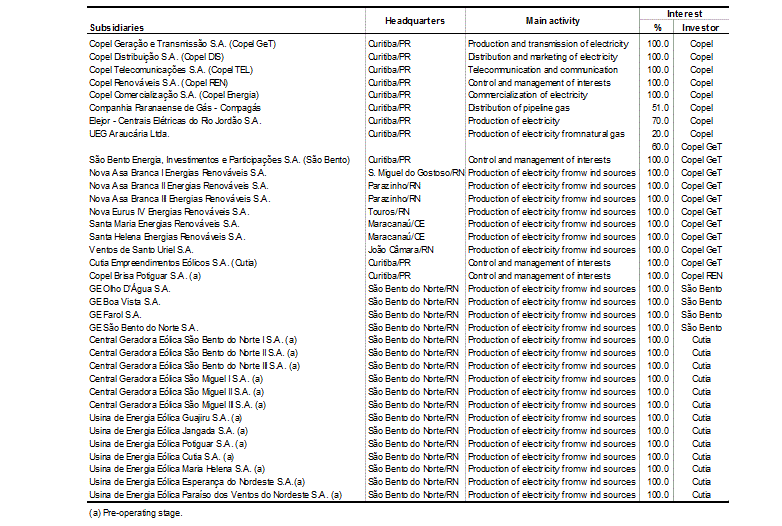
1.1.2 Joint ventures

13
(CONVENIENCE TRANSLATION INTO ENGLISH FROM THE ORIGINAL PREVIOUSLY ISSUED IN PORTUGUESE)

1.1.3 Associates

1.1.4 Joint operations (consortiums)

2 Concessions and Authorizations
2.1 Concessions contracts or authorizations obtained by Copel
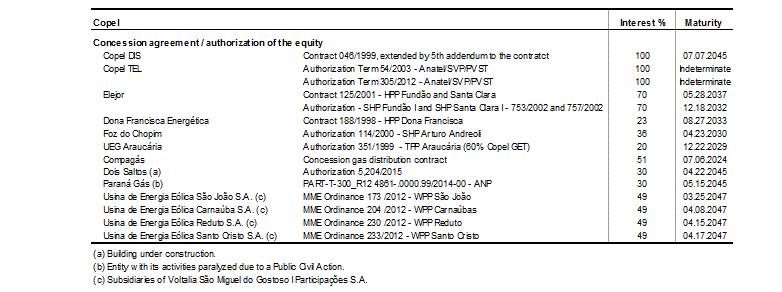
14
(CONVENIENCE TRANSLATION INTO ENGLISH FROM THE ORIGINAL PREVIOUSLY ISSUED IN PORTUGUESE)

2.2 Concessions contracts or authorizations obtained by subsidiary Copel Geração e Transmissão
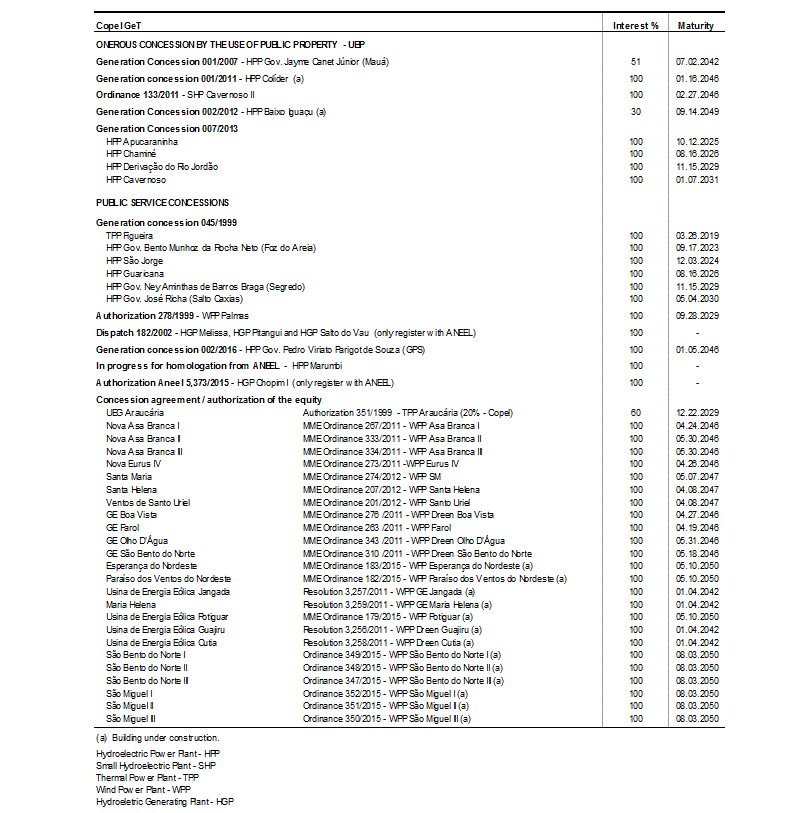
15
(CONVENIENCE TRANSLATION INTO ENGLISH FROM THE ORIGINAL PREVIOUSLY ISSUED IN PORTUGUESE)

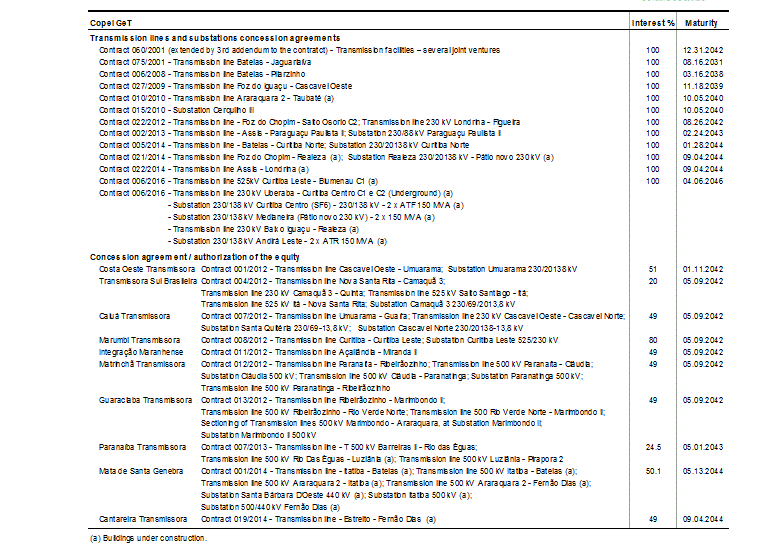
3 Basis of Preparation
3.1 Statement of compliance
The individual financial statements of the Parent Company and the consolidated financial statements have been prepared in accordance with International Financial Reporting Standards (IFRS) issued by the International Accounting Standards Board, IASB, as well as with accounting practices adopted in Brazil (BR GAAP), which comprise the standards, guidelines and interpretations issued by the Accounting Pronouncements Committee (Comitê de Pronunciamentos Contábeis or CPC) and approved by the Brazilian Securities and Exchange Commission (Comissão de Valores Mobiliários or CVM) and Federal Accounting Council (Conselho Federal de Contabilidade – CFC).
Company's management believes that all the relevant information used in its management is evidenced in the individual and consolidated financial statements.
16
(CONVENIENCE TRANSLATION INTO ENGLISH FROM THE ORIGINAL PREVIOUSLY ISSUED IN PORTUGUESE)

The issuance of the individual and consolidated financial statements was authorized by the Board of Directors on March 20, 2017.
3.2 Functional and presentation currency
The individual and consolidated financial statements are presented in Brazilian Reais, which is the functional currency of the Company. The financial information has been rounded to the nearest thousand, unless otherwise indicated.
3.3 Basis of measurement
The financial statements have been prepared based on the historical cost, except for certain financial instruments and investments, as described in the related accounting policies and explanatory notes.
3.4 Use of estimates and judgments
In the preparation of these individual and consolidated financial statements, Management used judgments, estimates and assumptions that affect the application of accounting policies and the reported amounts of assets, liabilities, income and expenses of the Company and its subsidiaries. Actual results may differ from those estimates.
Estimates and assumptions are reviewed on a continuous basis. Reviews of estimates are recognized in the period in which it is revised (prospective basis).
3.4.1 Judgments
Information about judgment referring to the adoption of accounting policies which impacts significantly the amounts recognized in the consolidated financial statements, except those involving estimates, is included in the following notes:
· Note 4.3 - Basis of consolidation;
· Note 4.4 - Financial instruments; and
· Note 4.13 - Leases.
3.4.2 Uncertainties on assumptions and estimates
Information on uncertainties related to assumptions and estimates that pose a significant risk of resulting in a material adjustment within the next financial year is included in the following notes:
· Notes 4.4.8 and 9 - Sectorial financial assets and liabilities;
· Notes 4.6 and 19 - Property, plant and equipment;
· Notes 4.7 and 20 - Intangible assets;
· Notes 4.8 and 19.9 - Impairment of assets;
· Notes 4.9 and 30 - Provisions for litigation and contingent liabilities;
· Note 4.10.1 - Unbilled revenues;
17
(CONVENIENCE TRANSLATION INTO ENGLISH FROM THE ORIGINAL PREVIOUSLY ISSUED IN PORTUGUESE)

· Note 4.10.2 – Interest;
· Note 4.12 - Power purchase and sales transactions in the Spot Market (Electric Energy Trading Chamber – CCEE);
· Note 7.3 - Estimated losses for doubtful accounts;
· Note 10.4 - Remeasurement of financial asset RBSE;
· Note 11 - Accounts receivable from the indemnity for the concession;
· Note 13.2 - Deferred income tax and social contribution; and
· Note 25 - Post-employment benefits.
3.5 Management's Judgment on Going Concern
Management has concluded that there are no material uncertainties that cast doubt on the Company’s ability to continue as a going concern. No events or conditions were identified that, individually or in the aggregate, may raise significant doubts on its ability to continue as a going concern.
The main bases of judgment used for such conclusion are: (i) main activities resulting from long-term concessions; (ii) robust shareholders equity; (iii) strong operating cash generation, including financial capacity to settle commitments entered into with financial institutions; (iv) historical series of profits in the last fiscal years; and (v) fulfillment of the objectives and targets set forth in the Company's Strategic Planning, which is approved by Management, monitored and reviewed periodically, seeking the continuity of its activities.
4 Significant accounting policies
4.1 Restatement of comparative balances
After reviewing its accounting practices, the Company and its electricity distribution subsidiary, aiming at the best presentation of its operational and financial performance, concluded that the changes in the expected cash flows of the indemnifiable financial asset of Copel DIS, wich was originally presented in the Financial Income, in Financial Results, would be better classified in the group of Operating Revenue, together with other revenues related to its activity. This allocation better reflects the electricity distribution business model and provides a better presentation on its performance. This conclusion is supported by the fact that:
i) Investing in infrastructure is the indispensable activity of the electricity distribution business, whose management model is supported in building, maintaining and operating this infrastructure;
ii) The return on infrastructure investment in the distribution business is determined by the fair value of that infrastructure, either the amortizable portion over the contract horizon (intangible asset), or the portion indemnifiable by the Granting Authority to its final (financial asset), plus regulatory Weighted Average Cost of Capital – WACC; and
18
(CONVENIENCE TRANSLATION INTO ENGLISH FROM THE ORIGINAL PREVIOUSLY ISSUED IN PORTUGUESE)

iii) Tariff revenues represent both the return on the intangible asset and a portion of the return on the financial asset, both of which are part of the regulatory remuneration base. Tariff revenues are fully recorded as part of the "Net Operating Revenue"
According to CPC 23/IAS 8 - Accounting Policies, Changes in Accounting Estimates and Errors, the Company and its subsidiary changed its accounting policy previously adopted by an accounting policy that best reflects the performance of its business (for the above mentioned arguments) and therefore reclassified retrospectively in the Statements of Income and the Statements of Added Value.
The reclassifications do not change the total assets, shareholders' equity and net income for the current and comparative year, nor the current and comparative Statements of Cash Flows.
The Statements of Income and the Statements of Added Value, for comparison purposes, are presented below:
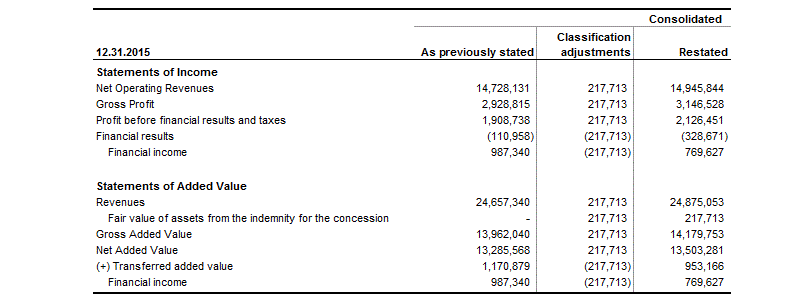
4.2 Out-of period adjustments
In the fourth quarter of 2016, the Company recorded out of period adjustments to correct prior year errors in judicial deposits, provision for legal claims, noncurrent other taxes, receivables from the Luz Fraterna program and from Infrastructure Use. The impact of these adjustments was to increase net other operating expenses by approximately R$30,679, increase finance income by approximately R$77,478, and increase finance expense by approximately R$56,315. The net impact of these adjustments was to decrease operating profit and net income by approximately R$9,516 and R$6,281, respectively. The Company has evaluated the effects of these errors and concluded that they were not material to any of the affected prior annual or interim financial statements, and that the impact of recording these adjustments were not material to the fourth quarter period income and either to the net income for the year.
19
(CONVENIENCE TRANSLATION INTO ENGLISH FROM THE ORIGINAL PREVIOUSLY ISSUED IN PORTUGUESE)

4.3 Basis of consolidation
4.3.1 Calculation of equity in earnings of investees
Investments in subsidiaries, joint ventures and associates are recognized in the investor’s individual financial statements using the equity accounting method. Under this method, investments are initially recorded at cost and their carrying value is increased or decreased through the recognition of the investor's interest in profit, loss and other comprehensive income generated by the investees subsequent to their acquisition. The use of this method should be discontinued as from the date on which the investment stops being qualified as subsidiary, joint venture or associate.
Payment of dividends decreases the carrying value of investments.
When required, for calculation of equity in earnings of investees, the investees' financial statements are adjusted to adapt their policies to the Parent Company's accounting policies.
4.3.2 Subsidiaries
The subsidiaries are entities to which the investor is exposed to, or has a right over the variable returns arising from its involvement with the entity and has the ability to affect those returns exerting its power over the entity.
The financial statements of the subsidiaries are included in the consolidated financial statements as from the date they start to be controlled by the Company until the date such control ceases.
The balances of the subsidiaries’ assets and liabilities, and profit or loss, are consolidated and transactions between consolidated companies are eliminated.
4.3.3 Interest of non-controlling shareholders
Non-controlling interest is presented in equity, separately from the equity attributable to the Parent Company's shareholders. Profits, losses and other comprehensive income are also allocated separately from the ones allocated to the Parent Company's shareholders, even if this results in non-controlling interest having a deficit balance.
4.3.4 Joint ventures and associates
Joint ventures are entities over which the Company, subject to an agreement, has the ability to affect returns exerting its power in conjunction with other parties, irrespective of the percentage of interest in the voting capital.
Associates are entities over which the Company exerts significant influence regarding financial and operational decisions, without control.
20
(CONVENIENCE TRANSLATION INTO ENGLISH FROM THE ORIGINAL PREVIOUSLY ISSUED IN PORTUGUESE)

When the share in losses of a joint venture or associate equals or exceeds the accounting balance of the investor’s equity interest in the investee, the investor should discontinue the recognition of its share in future losses. Additional losses will be considered, and a liability will be recognized, only if the investor incurs legal or constructive obligations, or performs payments on behalf of the investee. Should the investee subsequently determine profits, the investor should resume the recognition of its interest in these profits only subsequent to the point at which the portion to which it is entitled to in these subsequent profits equals its share in unrecognized losses.
4.3.5 Joint operations (consortiums)
Joint operation is a joint business according to which parties that jointly control the business have rights on assets and obligations regarding liabilities related to the business.
Joint operations are recorded in the Company holding the share, in proportion to the quotas of assets, liabilities and income (loss).
4.4 Financial instruments
The Company and its subsidiaries do not use derivative financial instruments.
Non-derivative financial instruments are recognized on the trading date, i.e. when the obligation or right arises. They are initially recognized at fair value plus any directly attributable transaction costs.
Fair values are determined based on the market quotation, for financial instruments traded in active markets, and for those with no quotations available on the market, fair values are determined by the present value of expected cash flows method.
After the initial recognition, the non-derivative financial instruments are measured as described below:
Financial assets
4.4.1 Financial instruments at fair value through profit or loss
Financial instruments designated as such upon initial recognition are classified as held for trading and if the Company and/or its subsidiaries manage these investments and make purchase or sale decisions based on their fair value in the context of an investment and risk management strategy. After initial recognition, transaction costs and attributable interests, when incurred, are recognized through profit and loss.
4.4.2 Loans and receivables
This category only comprises non-derivative assets with fixed or determinable payments which are not quoted in any active markets. They are measured using the amortized cost or effective interest rate methods.
21
(CONVENIENCE TRANSLATION INTO ENGLISH FROM THE ORIGINAL PREVIOUSLY ISSUED IN PORTUGUESE)

4.4.3 Financial instruments available-for-sale
The initial and subsequent measurement of financial instruments classified as “available for sale” is based on their fair value. The changes in the fair value resulting from the difference between the market interest rates and the effective interest rates are recognized in other comprehensive income, net of taxes. Interest set at the beginning of the agreement, calculated based on the effective interest rate method, as well as any changes in expected cash flows, are recognized directly in income for the period. At settlement of a financial instrument classified as available for sale, any gains or losses recognized in OCI are reclassified to income for the year.
4.4.4 Financial instruments held to maturity
If the Company and its subsidiaries are interested in and capable of holding any financial assets until maturity, they are classified as held to maturity. They are measured at amortized cost using the effective interest rate method, deducting any reductions in their recoverable value.
Financial liabilities and equity instruments
4.4.5 Financial liabilities measured at fair value through profit or loss
Financial liabilities designated as such upon initial recognition are classified as held for trading. They are stated at fair value and related gains or losses are recognized in income. The net losses or gains recognized in the income statement also include interest paid on the financial liability.
4.4.6 Other financial liabilities
Other financial liabilities are measured at amortized cost, using the effective interest method. This method is also used to allocate interest expense of these liabilities for the period. The effective interest rate is the rate that exactly discounts estimated future cash flows (including fees paid or received that form an integral part of the effective interest rate, transaction costs and other premiums or discounts) over the expected life of the financial liability or, when appropriate, over a shorter period, to the net carrying amount of the financial liability.
4.4.7 Derecognition of financial liabilities
The Company derecognizes financial liabilities only when its obligations are discharged, cancelled or settled. The difference between the book value of the derecognized financial liability and the corresponding disbursement made or to be made is recorded to income.
22
(CONVENIENCE TRANSLATION INTO ENGLISH FROM THE ORIGINAL PREVIOUSLY ISSUED IN PORTUGUESE)

Net sectorial financial assets and liabilities and related to the concession
4.4.8 Net sectorial financial assets and liabilities
An amendment to the concession agreement of distribution companies, approved by ANEEL Order No. 4,621/2014, provides that, in the event of termination of the concession for any reason, the residual values of Part A items and other financial components not recovered or returned through tariff are incorporated in the calculation of compensation or deducted from unamortized assets indemnity values, thus protecting rights or obligations of the distribution company to the Granting Authority.
Through CVM Resolution No. 732/2014, CPC approved the Technical Guidance OCPC 08 Recognition of Certain Assets and Liabilities in General-Purpose Accounting and Financial Reports of Power Distributors which required, upon signature of a contractual addendum, the recognition of certain assets and liabilities of distribution companies as from the year 2014.
Considering OCPC 08, item 12, the effects of amendments related to concession and permission contracts do not characterize a change in accounting policy but rather a new situation, therefore, their application were prospective to the event and the initial recognition adopted was based on the existing sectorial financial assets and liabilities values at the date of signature of the amendments of the concession contracts on December 10, 2014 by Copel Distribuição. Thus, the impact of the initial recognition was recorded as a component of net income.
Following guidance from ANEEL, the Company accounts for variations in sectoral financial assets and liabilities when there is a probable expectation that future revenue, equivalent to the costs incurred, will be billed and charged, resulting in the direct transfer of costs at an adjusted tariff according to the parametric formula defined in the concession agreement. The balance of these variations is retained and updated until the next tariff adjustment / review, when the Granting Authority authorizes the transfer in the Company’s tariff basis and consequently the transfer to the consumer in the next annual cycle, which occurs as from June 24 of each year.
4.4.9 Accounts receivable related to the concession
Power transmission concession
These refer to receivables in connection with the power transmission concession agreements and include the following amounts: (i) revenues from the construction of transmission infrastructure for use by system users; (ii) the financial return on these revenues guaranteed by the Granting Authority during the concession period.
23
(CONVENIENCE TRANSLATION INTO ENGLISH FROM THE ORIGINAL PREVIOUSLY ISSUED IN PORTUGUESE)

Revenues under power transmission concession agreements are collected by making infrastructure available to system users and are not subject to demand risk, and are thus considered guaranteed revenues, called Annual Permitted Revenues (Receita Anual Permitida or RAP, in Portuguese) to be received during the concession period. Amounts are billed monthly to the users of this infrastructure, pursuant to reports issued by the National System Operator (Operador Nacional do Sistema or ONS, in Portuguese). Upon expiration of the concession, any uncollected amounts related to the construction of infrastructure shall be received directly from the Granting Authority, as an unconditional right to cash reimbursement pursuant to the concession agreement, as compensation for investments made and not recovered through tariffs (RAP).
These financial assets do not have an active market, have fixed and determinable cash flows, and therefore are classified as “loans and receivables”. They are initially estimated based on their respective fair values and later measured according to the amortized cost calculated under the effective interest rate method.
Specifically to the Concession Agreement 060/2001, the subsequent additions, which represents expansion, improvement or enhancement of infrastructure, are recognized as a concession financial asset by virtue of representing the future generation of additional operating cash, according to specific rules from the Granting Authority.
Power distribution service concession
These refer to reimbursements set forth in the public power distribution service concession agreements, which the Company understands as an unconditional right to cash payments from the Granting Authority upon expiration of the concession. These reimbursements are designed to compensate Copel DIS for the investments made in infrastructure, which have not been recovered through the collection of tariffs at the end of the concession because of their useful lives being longer than the term of said concession.
Since these financial assets do not have determinable fixed cash flows – as the Company operates under the assumption that the value of the corresponding reimbursements will be based on the replacement cost of the concession assets and as they do not feature the necessary characteristics to be classified under any other category of financial assets – they are classified as “available for sale”. The cash flows related to these assets are determined taking into account the Regulatory Compensation Basis (Base de Remuneração Regulatória or BRR, in Portuguese), defined by the Granting Authority. The methodology of the BRR is based on the replacement cost of the assets that make up the power distribution infrastructure related to the concession. This tariff basis (BRR) is reviewed every four years taking into account several factors. Its goal is to reflect the variation in the prices of physical assets, including write-offs, depreciation, and additions of assets to the concession infrastructure (physical assets).
The return on these financial assets is based on the regulatory Weighted Average Cost of Capital or WACC approved by ANEEL in the periodic rate review process, whose amount is included in the tariffs charged to customers and collected monthly.
24
(CONVENIENCE TRANSLATION INTO ENGLISH FROM THE ORIGINAL PREVIOUSLY ISSUED IN PORTUGUESE)

1st, 2nd, 3rd and 4th Tariff Readjustment Cycles were conducted every four years and, beginning on the 5th cycle, which started in January 2016, they will be conducted every five years, considering a change introduced by the fifth amendment to the concession agreement.
Gas Concession
Gas concession agreement falls the bifurcated model, where part of the investments made by the concessionaire is paid by users of the public service and the other part is indemnified by the Granting Authority, the State of Paraná, at the end of the concession. This model contemplates the recognition of financial assets and intangible assets.
As a financial asset is recognized, the amount that will be indemnified by the Granting Authority corresponding to the investments made in the last ten years prior to the end of the concession as foreseen in the agreement and which the Company understands as an unconditional right to cash payments from the Granting Authority upon expiration of the concession.
Since these financial assets do not have determinable fixed cash flows – as the Company operates under the assumption that the value of the corresponding reimbursements will be based on the replacement cost of the concession assets and as they do not feature the necessary characteristics to be classified under any other category of financial assets – they are classified as “available for sale”.
4.4.10 Accounts receivable from concession indemnification
Arises from the residual balance of assets of the power transmission and generation infrastructure not yet depreciated and / or amortized existing at the end of the concession.
The amounts are transferred from Accounts Receivable Related to the Concession, Property, Plant and Equipment and Intangible Assets to the power transmission and generation activities, respectively, with the end of the concession.
At the end of each reporting period, Management evaluates the recoverability of the asset, remeasuring its cash flow based on its best estimate.
4.4.11 Accounts payable related to the concession
Refers to the amounts set forth in the concession agreement in connection with the right to explore hydraulic energy potential (onerous concession), whose agreement is signed as Use of Public Property (Uso do Bem Público or UBP, in Portuguese) agreements. The asset is recognized on the date of signature of the concession agreement, corresponding to the present value of future cash payments for the concession. The liability is then remeasured using the effective interest rate and reduced by contracted payments.
25
(CONVENIENCE TRANSLATION INTO ENGLISH FROM THE ORIGINAL PREVIOUSLY ISSUED IN PORTUGUESE)

4.5 Inventories (including property, plant and equipment and intangible assets - concession agreement)
Materials and supplies in inventory, classified under current assets and those assigned for investments, classified under property, plant and equipment, and intangible assets – concession agreements, have been recorded at their average acquisition cost. Recorded amounts do not exceed their net realizable value.
4.6 Property, plant and equipment
The assets related to the public service concession agreement are depreciated according to the straight-line method based on annual rates set forth and reviewed periodically by Aneel, which are used and accepted by the market as representative of the economic useful life of the assets related to concession's infrastructure. Assets related to contracts for the use of public property under the independent electricity producer scheme are depreciated based on annual rates established by Aneel limited to the concession period. All other fixed assets are depreciated using the straight-line method based on estimates of their useful lives.
Costs directly attributable to construction work as well as interest and financial charges on loans from third parties during construction are recorded under property, plant and equipment in progress, if it is probable that they will result in future economic benefits for the Company.
4.7 Intangible assets
Software acquired from third parties and those internally developed, are measured at acquisition cost and depreciated over five years. Intangibles from Concession Agreements are discussed below.
4.7.1 Onerous concession of electric power generation
Corresponds to acquisition of exploration rights on hydropower potential whose contract is signed as Use of Public Property - UBP.
During construction work, this asset is recognized at the present value of future cash disbursements during the Concession Agreement term. When commercial operation starts, the amount starts to be amortized during the concession period.
4.7.2 Hydrological risk renegotiation - GSF
Asset consisting of the renegotiation of the hydrological risk under the terms of Law No. 13,203, arising from the excess amount between the amounts recovered from the cost with the adjustment of the MRE (Generation Scaling Factor - GSF) subtracted from the total cost of the risk premium to be amortized over the energy supply period in the regulated environment. The amount was transformed by Aneel into an extension of the concession period, which is amortized on a straight-line basis as from January 1, 2016 until the end of the new concession period, according to note 14.1.
26
(CONVENIENCE TRANSLATION INTO ENGLISH FROM THE ORIGINAL PREVIOUSLY ISSUED IN PORTUGUESE)

4.7.3 Concession agreement – electricity distribution
These comprise the right to control infrastructure, built or acquired by the operator or provided to be used by the operator as part of the electric energy public service concession agreement (the right to charge fees to the users of the public service provided by the operator), in compliance with CPC 04 / IAS 38 – Intangible Assets, ICPC 01 (R1) and OCPC 05 / IFRIC 12 – Concession Agreements.
Intangible assets are recorded at their fair acquisition and construction value, less accumulated amortization and impairment losses, when applicable.
The amortization of intangible assets reflects the pattern in which it is expected that future economic benefits will flow to Copel DIS during to the concession period.
4.7.4 Concession agreement – gas distribution
Intangible assets from the construction of infrastructure and the purchase of assets required for the provision of gas distribution services correspond to the right to charge users for the gas supply.
This intangible asset was initially recognized at acquisition, formation or construction cost, plus interest and other capitalized finance charges. This asset is amortized using the straight-line basis over its estimated useful life, considering the economic benefits generated by intangible assets.
4.7.5 Intangible assets acquired separately
Intangible assets with a defined useful life, acquired separately, are recorded at cost, less accumulated amortization and accumulated impairment losses. Amortization is recognized using the straight-line method based on the estimated useful lives of the corresponding assets. The estimated useful lives and the amortization method are reviewed at the end of each reporting period, with the effect of any changes in estimate being accounted for on a prospective basis.
4.7.6 Derecognition of intangible assets
An intangible asset is derecognized when no future economic benefits are expected from use or disposal. Gains or losses arising from derecognition of an intangible asset, measured as the difference between net disposal proceeds and the carrying amount of the asset are recognized in profit or loss when the asset is derecognized.
4.8 Impairment of assets
Assets are assessed annually to detect evidence of impairment.
27
(CONVENIENCE TRANSLATION INTO ENGLISH FROM THE ORIGINAL PREVIOUSLY ISSUED IN PORTUGUESE)

4.8.1 Financial assets
A financial asset not measured at fair value through profit or loss is assessed at each reporting date to determine whether there is objective evidence that it might be impaired. A financial asset is considered to be impaired if objective evidence indicates that a loss event has occurred after the initial recognition of the asset and that the loss event had a negative effect on the estimated future cash flows that can be reliably estimated.
The Company considers evidence of impairment of receivables at both the individual and collective levels. All individually significant receivables are valued for the specific loss of value.
An impairment of a financial asset measured at amortized cost is calculated as the difference between the carrying amount and the present value of estimated future cash flows, discounted at the effective original interest rate of the financial asset. Losses and their reversals are recognized in profit or loss and reflected in an allowance account against receivables.
4.8.2 Non-financial assets
Assets under formation arising from onerous concession and concession rights and / or authorization to generate electricity, classified as intangible assets, are annually tested along with the other assets of that cash- generating unit.
Whenever there is a loss resulting from situations where an asset’s carrying value exceeds its recoverable value, defined as the greater between the asset’s value in use and its net selling price, this loss is recognized in profit or loss for the year.
For impairment assessment purposes, assets are grouped at the lowest levels for which there are separately identifiable cash flows (Cash Generating Units - CGU).
The amount of the impairment of non-financial assets is reviewed for the analysis of a possible reversal at the reporting date, in case of reversal of loss of prior years, this is recognized in current year's profit or loss.
4.9 Provisions
Provisions are recognized when, and only when: i) the Company has a present obligation (legal or constructive) resulting from a past event, ii) it is probable (i.e., more likely than not) that an outflow of resources embodying economic benefits will be required to settle the obligation, and iii) a reliable estimate can be made of the amount to settle the obligation.
The estimates of outcomes and financial impacts are determined by the Company's management judgment, supplemented by experience of similar transactions and, in some cases, by independent expert reports.
28
(CONVENIENCE TRANSLATION INTO ENGLISH FROM THE ORIGINAL PREVIOUSLY ISSUED IN PORTUGUESE)

Social-environmental liabilities are recognized as the Company assumes formal obligations before regulatory agencies or becomes aware of potential risks related to socio-environmental issues, which may lead to cash disbursements that are deemed probable and that may be estimated. During the project implementation phase, the accrued amounts are recorded against property, plant and equipment (generation), construction cost (transmission) or intangible assets in progress (distribution). At the start of operations, all costs included in the Operating License, whose programs will be executed during the concession and the respective disbursement has not yet occurred, are measured and adjusted to present value according to the estimated cash flow of disbursements and recorded as social-environmental provisions in contra-entry to the assets related to the project, being adjusted periodically. Once the project enters commercial operation, all costs or expenses incurred with socio-environmental programs related to the project’s operation and maintenance licenses are analyzed according to their nature and recorded directly to profit or loss for the period.
4.10 Revenue recognition
Operating revenues are recognized when: (i) the revenue amount can be reliably measured; (ii) the costs incurred or to be incurred in the transaction are reliably measurable; (iii) it is likely that the economic benefits will be received by the Company; and (iv) the risks and rewards have been fully transferred to the buyer.
Revenue is measured at the fair value of the consideration received or receivable, less discounts and/or bonuses granted and charges on sales.
4.10.1 Unbilled revenues
Refers to revenues from electricity sales to final customers, electricity sales to distributors, use of the main distribution and transmission grid and telecommunication services, from the period between the last billing and the end of each month, by estimate based on the last measurement taken.
4.10.2 Interest
Revenue from interest is recognized when it is probable that future economic benefits will flow to the Company and the revenue value can be reliably measured. Interest revenue is recognized at the straight-line basis and based on time and effective interest rate on outstanding principal amounts. The effective interest rate is the one that discounts exactly estimated future cash receipts during the estimated life of the financial asset in relation to initial net book value of that asset.
4.11 Construction revenues and costs
Revenue related to construction services for infrastructure in the power transmission and distribution services, and gas distribution, are recognized using the stage of completion method.
Related costs are recognized in the income statement as construction cost.
29
(CONVENIENCE TRANSLATION INTO ENGLISH FROM THE ORIGINAL PREVIOUSLY ISSUED IN PORTUGUESE)

Given that Copel DIS and Compagás outsource the construction of distribution infrastructure to unrelated parties and works are carried out over short periods, the construction margin to the power and gas distribution activities result in no significant amounts, resulting in the non-recognition of such margin.
The construction margin adopted for the transmission activity for the years 2016 and 2015 was 1.65%, and results from a calculation methodology which takes into account the respective business risk.
4.12 Power purchase and sales transactions in the Spot Market (Electric Energy Trading Chamber – CCEE)
Power purchase and sales transactions in CCEE are recorded on the accrual basis according to the information disclosed by this Trading Chamber or to estimates prepared by the Management of the subsidiaries when public information is not yet available.
4.13 Leases
Leases are classified as finance leases whenever the terms of the lease transfer substantially all the risks and rewards of ownership to the lessee. Other leases are classified as operating.
4.14 Statements of Value Added - DVA
The purpose of this statement is to disclose the wealth generated by companies and its distribution over a given period. It is presented as required by Brazilian Corporate Law, as part of the financial statements in accordance with accounting practices adopted in Brazil and as supplementary information to the IFRS financial statements, as this statement is not required by IFRS.
4.15 New standards that are not yet in effect
A number of new IFRS standards and amendments to the standards and interpretations were issued by the IASB and had not yet come into effect for the year ended December 31, 2016. Consequently, the Company and its subsidiaries has not adopted them in advance.
The new rules that may have an impact on the Company and its subsidiaries are mentioned below:
4.15.1 CPC 48/IFRS 9 - Financial Instruments
CPC 48 / IFRS 9 is effective for the financial statements of an entity prepared in accordance with IFRS for annual periods beginning on or after January 1, 2018 and earlier application is permitted.
This standard establishes new requirements for classification and measurement of financial assets and liabilities. Financial assets are classified into three categories: (i) measured at fair value through profit or loss; (ii) measured at amortized cost, based on the business model within which they are held and the characteristics of their contractual cash flows; and (iii) measured at fair value through other comprehensive income.
30
(CONVENIENCE TRANSLATION INTO ENGLISH FROM THE ORIGINAL PREVIOUSLY ISSUED IN PORTUGUESE)

With regard to financial liabilities, the main alteration in relation to the requirements already set by IAS 39 / CPC 38 requires any change in fair value of a financial liability designated at fair value through profit or loss attributable to changes in the liability's credit risk to be stated in other comprehensive income and not in the statement of profit or loss, unless such recognition results in a mismatching in the statement of profit or loss.
In relation to the impairment of financial assets, IFRS 9 / CPC 48 requires an expected credit loss model, as opposed to an incurred credit loss under IAS 39 / CPC 38. The expected credit loss model requires an entity to account for expected credit losses and changes in those expected credit losses at each reporting date to reflect changes in credit risk since initial recognition. In other words, it is no longer necessary for a credit event to have occurred before credit losses are recognized.
Regarding the modifications related to hedge accounting, IFRS 9 / CPC 48 retains three types of hedge accounting mechanisms currently available in IAS 39 / CPC 38. Under IFRS 9 / CPC 48, greater flexibility has been introduced to the types of transactions that are eligible for hedge accounting, more specifically regarding the types of instruments that qualify as hedging instruments and the types of risk components of nonfinancial items eligible for hedge accounting.
In addition, the effectiveness test has been overhauled and replaced with the principle of an “economic relationship”. Retrospective assessment of hedge effectiveness is also no longer required. Enhanced disclosure requirements about an entity’s risk management have also been introduced.
The Company’s subsidiaries have material assets classified as “available for sale”, in accordance with the current requirements of IAS 39 / CPC 38. These assets represent the right to indemnity at the end of the concession period of the subsidiaries. The designation of these instruments as “available for sale” occurs due to the nonclassification in the other three categories described in IAS 39 / CPC 38 (loans and receivables, fair value through profit or loss and heldtomaturity). Management’s preliminary opinion is that, should these assets be classified as measured at fair value through profit or loss according to the new standard, the effects of the subsequent remeasurement of this asset would be recognized in profit or loss for the year. Thus, there will not be material impacts on the Company’s consolidated financial statements.
Moreover, as the Company and its subsidiaries do not apply hedge accounting, Management concluded that there will not be material impact on the information disclosed or amounts recorded in its consolidated financial statements as a result of the amendments to standard. As regards the changes in the calculation of impairment of financial instruments, the Company is assessing any impacts of the adoption of this standard.
4.15.2 CPC 47/IFRS 15 - Clarifications to IFRS 15 Revenue from contracts with customers
CPC 47 / IFRS 15 provides a single, straightforward model for accounting for contracts with customers, and when it comes into effect, it will supersede the current guide for revenue recognition provided in IAS 18 / CPC 30 (R1) – Revenue and IAS 11 / CPC 17 (R1) Construction contracts and related interpretations.
31
(CONVENIENCE TRANSLATION INTO ENGLISH FROM THE ORIGINAL PREVIOUSLY ISSUED IN PORTUGUESE)

The standard establishes that an entity will recognize revenue to depict the transfer of promised goods or services to customers in an amount that reflects the consideration to which the entity expects to be entitled in exchange for those goods or services. The standard introduces a fivestep model for revenue recognition: (i) Identify the contract with the customer; (ii) Identify the performance obligations in the contract; (iii) Determine the transaction price; (iv) Allocate the transaction price to the performance obligations in the contract; and (v) Recognize revenue when (or as) the entity satisfies a performance obligation.
Under IFRS 15 / CPC 47, an entity recognizes revenue when (or as) the entity satisfies a performance obligation, i.e., when the "control" over the goods and services in a certain operation is transferred to the customer, and will establish a greater level of detail in the disclosures.
The standard will be applicable for annual reporting periods beginning on or after January 1, 2018, and its early adoption is permitted. The Company is assessing the potential impacts of the adoption of this new standard and preliminarily assess that they will not be material in its consolidated financial statements.
4.15.3 IFRS 16 - Leases
Issued on January 13, 2016, establishes, in the lessee’s view, a new form for accounting for leases currently classified as operating leases, which are now recognized similarly to leases classified as finance leases. As regards the lessors, it virtually retains the requirements of IAS 17, including only some additional disclosure aspects.
IFRS 16 is effective for annual periods beginning or on after January 1, 2019, and its early adoption is permitted as long as the entities also early adopt IFRS 15 Revenues from contracts with customers. The Company is assessing the potential impacts of the adoption of this new standard.
4.15.4 Amendments to IAS 12 / CPC 32 - Recognition of Deferred Tax Assets for Unrealized Losses
Issued on January 19, 2016, the amendments to IAS 12 / CPC 32 clarify the requirements of recognition of deferred tax assets for unrealized losses on debt instruments and the method for assessing the existence of probable future taxable profits for the realization of temporarily nondeductible differences, to address the diversity in practice.
The amendments to IAS 12 / CPC 32 will be applicable for annual periods beginning on or after January 1, 2017, and its early adoption is permitted. The Company estimates that the application of the amendments to IAS 12 / CPC 32 tends not to cause material impacts on its consolidated financial statements.
4.15.5 Amendments to IAS 7 / CPC 03 - Disclosure initiative
Issued on January 29, 2016, the objective of the amendments to IAS 7 / CPC 03 from the Disclosure Initiative is for the entities to provide disclosures that permit the users of the financial statements to assess the amendments as regards the responsibilities arising from financing activities.
32
(CONVENIENCE TRANSLATION INTO ENGLISH FROM THE ORIGINAL PREVIOUSLY ISSUED IN PORTUGUESE)

For this, IASB requires that the following changes in liabilities arising from financing activities be disclosed: (i) changes in cash flows from financing activities; (ii) changes arising from the obtainment or loss of control of subsidiaries or other businesses; (iii) effect of exchange rate changes; (iv) changes in fair values; and (v) other changes.
The IASB defines liabilities arising from financing activities as liabilities "for which their cash flows were or will be classified in the Statements of Cash Flows as cash flows from financing activities". It also highlights that the new disclosure requirements refer similarly to changes in financial assets, if they meet the same definition. Finally, the amendments indicate that the changes in liabilities arising from financing activities should be disclosed separately from the changes in other assets and liabilities.
The amendments to IAS 7 / CPC 03 are effective for annual periods beginning on or after January 1, 2017, and its early adoption is permitted. Since the amendments were disclosed in a period of time shorter than one year before the mandatory adoption period, entities are exempt from publishing comparative information on the early adoption of the amendments. The Company estimates that the application of the amendments to IAS 7 / CPC 03 will not result in changes in the classification of the amounts of the Company’s statements of cash flows for future periods with no other material impacts on its consolidated financial statements.
4.15.6 IFRIC 22 - Foreign Currency Transactions and Advance Consideration
Issued on December 8, 2016, IFRIC 22 deals with the exchange rate to be used in transactions that involve the consideration paid or received in advance in foreign exchange transactions.
The IFRIC is effective for annual periods beginning on or after January 1, 2018, and its early adoption is permitted.
The transactions in foreign currency of the Company and its subsidiaries are currently restricted to debt instruments with international financial institutions, measured at fair value, and to the acquisition of energy from Itaipu. Since assets and liabilities measured at fair value are not within the scope of the IFRIC and that there are no advance payments on transactions with Itaipu, the Company estimates that IFRIC 22 will not have material impacts on its consolidated financial statements.
4.15.7 Amendments to CPC 28 / IAS 40 - Investment Property
Issued on December 8, 2016, the amendments to IAS 40 / CPC 28 clarify the requirements relating to transfers from or to investment properties. The amendments are effective for annual periods beginning on or after January 1, 2018, and its early adoption is permitted.
The Company is assessing the potential impacts of the adoption of the amendments.
4.15.8 Annual Improvements to IFRSs 2014 - 2016 Cycle
Every year, IASB discusses and decides on the proposed improvements to IFRS as they arise during the period. Issued on December 8, 2016, the improvements deal with the following subjects:
33
(CONVENIENCE TRANSLATION INTO ENGLISH FROM THE ORIGINAL PREVIOUSLY ISSUED IN PORTUGUESE)

i) amendments to IFRS 1 - excludes from the standard some exceptions existing for application in the transition period of the entities that are new IFRS adopters.
ii) amendments to IFRS 12 - clarifies the scope of the pronouncement, in respect of interest of entities in other entities that are classified as available for sale or discontinued operations in accordance with IFRS 5.
iii) amendments to IAS 28 - clarifies if an entity has an option of "investment for investment" to measure the investees at fair value in accordance with IAS 28 for a risk capital organization.
Based on a preliminary assessment of the amendments, the Company's management believes that the application of these amendments should not have material impact on the disclosures or amounts recognized in its consolidated financial statements in future periods.
5 Cash and Cash Equivalents

It comprises liquid funds in cash, bank deposits and short-term high liquidity investments, which can be redeemed within 90 days for cash from the contract date. Temporary short-term investments are recorded at cost at the reporting date, plus earnings accrued. Cash and cash equivalents are subject to an insignificant risk of change in value.
Financial investments refer to Bank Deposit Certificates - CDBs and Repurchase Agreements, which are the sale of a security with the commitment of the seller (Bank) to repurchase it, and of the purchaser to resell it in the future. Investments are remunerated between 65% and 101% of the rate of change of the Interbank Deposit Certificate (Certificado de Depósito Interbancário - CDI).
34
(CONVENIENCE TRANSLATION INTO ENGLISH FROM THE ORIGINAL PREVIOUSLY ISSUED IN PORTUGUESE)

6 Bonds and Securities

Copel and its subsidiaries have securities that yield variable interest rates. The term of these securities ranges from 1 to 60 months from the end of the reporting period. None of these assets is overdue or impaired at year-end.
35
(CONVENIENCE TRANSLATION INTO ENGLISH FROM THE ORIGINAL PREVIOUSLY ISSUED IN PORTUGUESE)

7 Trade Accounts Receivable
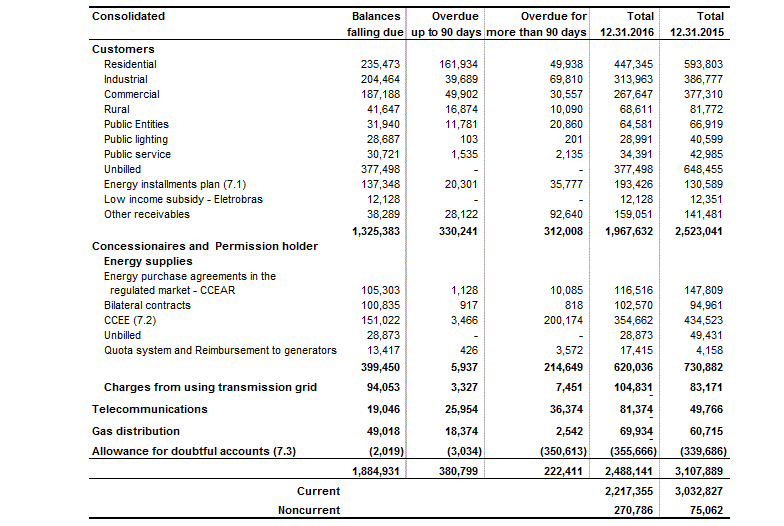
7.1 Energy installments plan
The trade accounts receivable renegotiated are discounted to present value, taking into consideration the future value, the maturity dates, the dates of settlement and the discount rate ranging from 0.16% to 3.00%.
x
36
(CONVENIENCE TRANSLATION INTO ENGLISH FROM THE ORIGINAL PREVIOUSLY ISSUED IN PORTUGUESE)

7.2 Electricity Trade Chamber – CCEE
Of the balance presented, the main amount of R$203,415 is related to Copel GeT. Of this total, the amounts of R$4,361, R$15,484 and R$2,010 were received on January 6, 2017, February 7, 2017 and March 10, 2017, respectively, and the remaining balance of R$181,560 derive from sale of energy to be reprocessed by CCEE for the period from January to May 2015 as a result of the request for exemption from responsibility of complying with trading contracts of Colíder Hydroelectric Power Plant for delivery of energy (Note 19.6), of which the contested portion there is a register of estimated losses for doubtful accounts. On March 14, 2010, ANEEL denied the Company's request for reconsideration of ANEEL Order No. 1,580, dated June 14, 2016, which had maintained unaltered the implementation schedule and the energy supply schedules related to the plant.
Considering that the plant's start-up schedule was impacted by acts of public authorities and unforeseeable or force majeure events occurred during the implementation of the project, the Company will refer the matter to the court with the conviction that the decision of the Agency will be reversed.
7.3 Allowance for doubtful accounts
The allowance for doubtful accounts is recorded in amounts deemed sufficient by Copel’s senior management to cover potential losses on the realization of customer receivables and others whose recovery is considered unlikely.
The allowance for doubtful accounts is recorded considering the parameters recommended by ANEEL, based on the expectation of receivables from the main debtors, on the analysis of large debts in judicial recovery / bankruptcy, on amounts receivable from residential class customers overdue for more than 90 days, from commercial class customers overdue for more than 180 days and from industrial and rural customers, public authorities, public lighting and public utilities overdue for more than 360 days in addition to previous experience of actual losses.
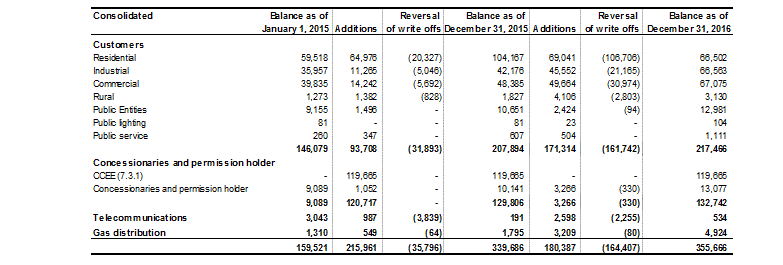
37
(CONVENIENCE TRANSLATION INTO ENGLISH FROM THE ORIGINAL PREVIOUSLY ISSUED IN PORTUGUESE)

7.3.1 Consumers’ allowance for doubtful accounts
In 2016, allowance for doubtful accounts was recognized in connection with companies undergoing judicial recovery, from Commercial and Industrial classes, in the amount of R$45,858.
7.3.2 CCEE
An allowance for doubtful accounts was recognized in 2015 in the amount of R$119,665 in respect of differences between the sales price of the energy traded under the Contracts for Purchasing and Selling Electricity in the Regulated Market (CCEARs) of the Colíder Hydroelectric Power Plant and the difference settlement price (PLD). The Company will await the decision on the request for a revision of the power plant’s operations start date to reverse that estimated losses.
8 CRC Transferred to the State Government of Paraná
By means of a fourth amendment dated January 21, 2005, the Company renegotiated with the State of Paraná the outstanding CRC (Account for Compensation of Income and Losses) balance as of December 31, 2004, in the amount of R$1,197,404, to be paid in 244 installments under the Price amortization system, adjusted according to the IGP-DI inflation index plus interest of 6.65% p.y., which are received monthly, with the first installment due on January 30, 2005 and the others due in subsequent and consecutive months.
At the request of the State of Paraná, approved by the Company's Board of Directors subject to the consent of the Department of the Treasury, the Adjustment Term Novation of the CRC is in progress, which contemplates no principal and interest payments in the period from April to December 2016 and payment of interest and no payment of principal from January to December 2017, and the maintenance of the current indexes of correction and interest and of the global net present value of referred agreement. The other clauses will be maintained.
As from 2017, the State of Paraná has been paying monthly the amount referring to the interest of the installment as established in the Adjustment Term Novation, still to be concluded.
Amortization is guaranteed by dividends payable to the State as a shareholder.
38
(CONVENIENCE TRANSLATION INTO ENGLISH FROM THE ORIGINAL PREVIOUSLY ISSUED IN PORTUGUESE)

8.1 Changes in CRC

8.2 Maturity of noncurrent installments

9 Net Sectorial Financial Assets and Liabilities
Net Sectorial Financial Assets and Liabilities refer to the Variance of Parcel “A” Costs (CVA) and other financial components relating to non-manageable costs incurred in the tariff cycle without adequate tariff coverage.
The CVA, comprised of the costs of power purchase, transmission costs and sector charges, and financial items, which correspond to overcontracting of energy, neutrality of charges, and other rights and obligations included in the tariff, are transferred entirely to the electricity tariff or covered in the manner defined by the Granting Authority, not affecting the distributor's annual result.
The asset or liability balances represent the positive and negative variances between the amounts projected in the tariff and actual amounts, adjusted using a monetary adjustment index. Annually, in the tariff adjustment/ review processes, they are ratified by Aneel and transferred as components of the power tariff. Monthly, the amounts approved in previous tariff adjustment / review processes are amortized.
39
(CONVENIENCE TRANSLATION INTO ENGLISH FROM THE ORIGINAL PREVIOUSLY ISSUED IN PORTUGUESE)

The balance as of 12.31.2016 is composed of the previous cycle (2016 tariff adjustment), under amortization, which represents the balance approved by Aneel already contemplated in the tariff and by the cycle under constitution (2017 tariff adjustment and 2021 periodic tariff review), which will be ratified by Aneel in the next tariff events.
40
(CONVENIENCE TRANSLATION INTO ENGLISH FROM THE ORIGINAL PREVIOUSLY ISSUED IN PORTUGUESE)

9.1 Composition of net sectorial financial assets and liabilities balances per tariff cycle
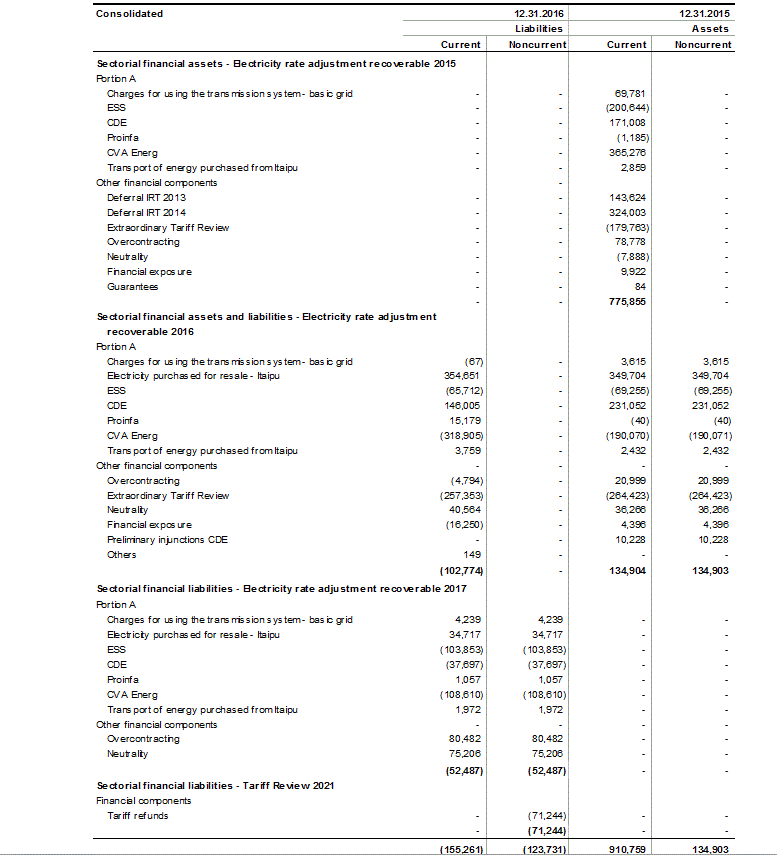
41
(CONVENIENCE TRANSLATION INTO ENGLISH FROM THE ORIGINAL PREVIOUSLY ISSUED IN PORTUGUESE)

9.2 Changes in net sectorial financial assets and liabilities
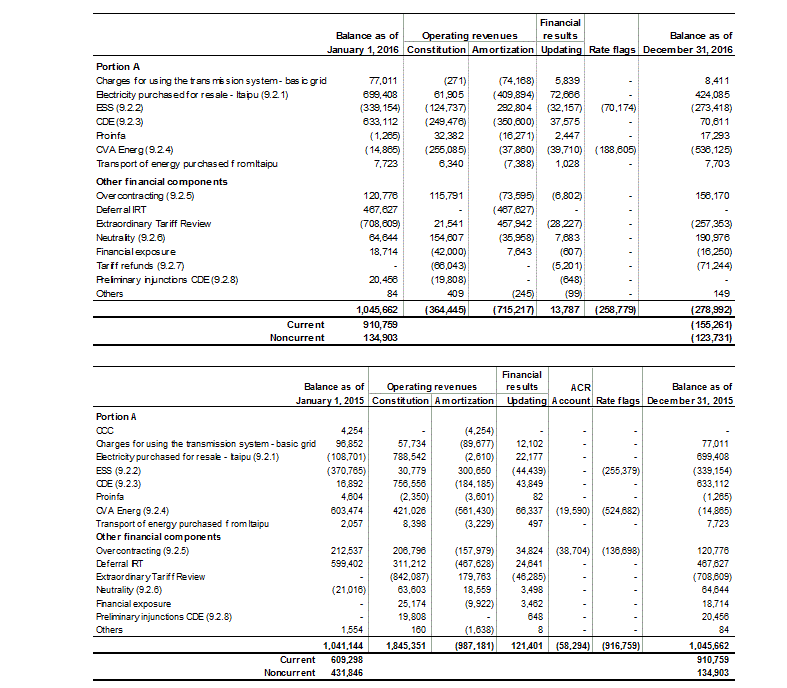
9.2.1 Electricity purchased for resale - Itaipu
Power output from the Itaipu hydropower station is sold as quotas to utilities companies in the South, Southeast and Midwest in proportion to their markets. The amount constituted in 2016 refers to the change in the power purchase cost and foreign exchange variance, in relation to that predicted in the last tariff adjustment.
42
(CONVENIENCE TRANSLATION INTO ENGLISH FROM THE ORIGINAL PREVIOUSLY ISSUED IN PORTUGUESE)

9.2.2 System Service Charges - ESS
Consist in the costs associated to thermal power dispatching for the maintenance of the system reliability and stability and whose pricing was not considered in the calculation of the allowance for doubtful accounts. This amount is paid by all agents with consumption measurement registered on the CCEE, in the proportion of the consumption subject to payment of this charge.
These charges include the refund to generation agents of the operation restriction costs, provision of ancillary services, and for reasons of energy security.
The ESS was offset by the resources received from the Rate Tier Pooling Account (CCRBT) or Tariff Flags Account.
In 2016 there was an improvement of the hydrological conditions and a decrease in dispatch of the thermopower plants, favoring the reduction of this charge.
9.2.3 Energy Development Account - CDE
The balance of CDE in 2016 is the result of the lower amount of monthly payment quotas, except in this case the CDE discounts resulting from preliminary injunctions, ratified by ANEEL (Note 32.5.1), in relation to the regulatory quota in the electricity tariff.
9.2.4 Electricity purchased for resale - CVA Energ
The balance reflects the difference between the average price of payment, related to the effects of contracting for availability (ECD), Angra and Cotas, and the average price of tariff coverage.
The CVA Energ account was offset by funds received from the Rate Tier Pooling Account (CCRBT) or Tariff Flags Account.
On January 26, 2016, Aneel approved Normative Resolution No. 700/2016, which deals with the methodology for cases of positive balances of the Tariff Flags Account, which provides that the surplus of flags is allocated in the distributor, to be allocated to customers in the subsequent tariff processes, and may be offset in future calculations of the Tariff Flags Account, until the next tariff adjustment.
9.2.5 Overcontracting
Corresponds to the cost of acquisition of the amount of energy overcontracting in relation to the annual supply charge, as well as the energy cost related to spot market exposure. The balance results from the sale of energy surpluses on the spot market at a price (PLD) lower than the mix of coverage.
9.2.6 Neutrality
Refers to the estimated recoverable portion of sector charges not covered by the current tariff (billed revenue) due to the decline in consumption during the period.
43
(CONVENIENCE TRANSLATION INTO ENGLISH FROM THE ORIGINAL PREVIOUSLY ISSUED IN PORTUGUESE)

9.2.7 Tariff refunds
Aneel, by means of Order No. 245 of January 28, 2016, in line with the Tariff Regulation Procedures - Proret, sub-module 2.1 - General Procedures, determined that the new amounts resulting from excess demand and surplus of reagents previously recorded as special obligations should be accounted for as of January 1, 2016 as sector financial liabilities, net of taxes levied, of the regulatory percentage of 3.5% of revenue, referring to the excess demand in the transmission grid, and of the unrecoverable revenues, applying the regulatory percentage associated with the industrial consumption class. These amounts, updated monthly based on the Selic rate, should be subtracted from the tariff in the next tariff review, generating effects from 2021.
9.2.8 Injunctions CDE
Under Resolution No. 1,986/2015, ANEEL established the rates applying to members of the Brazilian Association of Large Industrial Consumers and Free Consumers (ABRACE) following a judicial award suspending payment of part of the Economic Development Account (CDE) charge, resulting in a decrease in revenues. The amount unpaid by members will be apportioned to other consumers in the following tariff cycle.
Copel DIS, in compliance with ANEEL Order No. 1,576/2016 of 06.14.2016, which changed the methodology for the application of the injunctions, including in view of the increase in proceedings challenging this charge, made a disallowance in the payment of the CDE and reversed the financial component.
10 Accounts Receivable Related to the Concession

44
(CONVENIENCE TRANSLATION INTO ENGLISH FROM THE ORIGINAL PREVIOUSLY ISSUED IN PORTUGUESE)

10.1 Distribution concession agreement

On December 9, 2015, the Company signed the Fifth Amendment to Concession Agreement No. 46/1999, extending the concession period to July 7, 2045, in accordance with the Decision of the Ministry of Mines and Energy of November 9, 2015, based on Law No. 12,783/2013, Decree No. 7,805/2012 and Decree No. 8,461/2015.
Accounts Receivable Related to the Concession are measured at fair value and their collection is assured by the Granting Authority through an indemnity upon the reversal of these assets at the end of the concession period.
As a result of the term extension, the amount of R$4,056,355 was reclassified from Accounts Receivable Related to the Concession to Intangible Assets in 2015, remaining a balance of R$424,140 at the end of the year. As a result of the positive result of the tariff review, the amount of R$104,239 was recognized, which, in addition to the application of the IPCA on the armored base, during 2016 allowed the recognition of fair value of R$131,738. The final balance, plus new capitalizations in 2016, is R$614,806.
10.2 Bonus from the grant of concession agreements under the quota system

On January 5, 2016, Copel GeT entered into a 30-year concession agreement of HPP GPS, in accordance with Law No. 12,783/2013, with payment of the Bonus from the Grant - BO to the Granting Authority, amounting to R$574,827, asper ANEEL Invitation to Bid 12/2015.
x
45
(CONVENIENCE TRANSLATION INTO ENGLISH FROM THE ORIGINAL PREVIOUSLY ISSUED IN PORTUGUESE)

The signing of the agreement permits to operate the concession for the next 30 years and the energy will be sold within the Regulated Contracting Environment - ACR under the Assured Power Quota System - CGF or “quota regime” in 2016 and, as from 2017, in the proportion of 70% of the power on the ACR and 30% on the free environment - ACL.
The amount of the bonus for the grant was recognized as a financial asset due to the Company’s unconditional right to receive the amount paid with inflation adjustment based on IPCA and interest during the concession period.
10.3 Transmission concession agreement
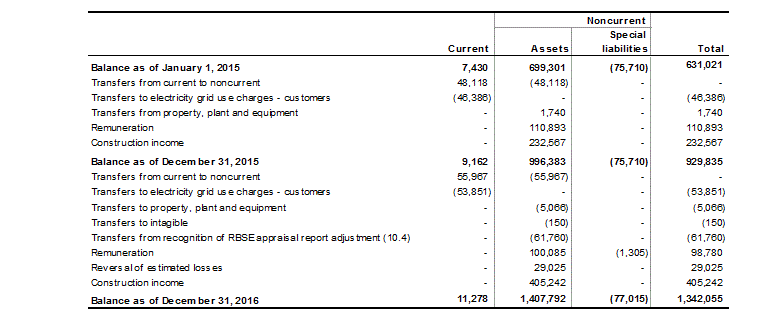
10.4 Remeasurement of RBSE financial assets

Copel GeT extended concession agreement 060/2001, pursuant to Law No. 12,783/2013.
Regarding the amounts receivable for part of the electricity transmission assets of the Existing Basic Network System (RBSE) and for the connecting facilities and Other Transmission Facilities (RPC) prior to May 2000, on March 31, 2015, Copel GeT filed an appraisal report for these assets with Aneel in the amount of R$ 882,300 on December 31, 2012, which is pending approval.
x
46
(CONVENIENCE TRANSLATION INTO ENGLISH FROM THE ORIGINAL PREVIOUSLY ISSUED IN PORTUGUESE)

On April 20, 2016, MME Ordinance No. 120 was published, determining that the amounts of assets arising from electricity transmission infrastructure construction exclusively related to these not yet depreciated and/or amortized, shall comprise the Regulatory Remuneration Base (BRR) for electricity transmission concessionaires as of the 2017 tariff review process, in order to define the new Annual Permitted Revenue (APR). The Ordinance addressed issues related to updating, remunerating and period for receiving the amounts, which are regulated by Aneel Normative Resolution No. 726/2017, by means of Public Hearing 068/2016.
After the instruction from the Granting Authority described above, the Company has, in each reporting period, remeasured its cash flow from these assets based on its best estimate, which represents an Asset balance of R$1,186,985 as of 12.31.2016. The variation in the remeasurement of the asset has a corresponding entry in operating income and was reflected in the income for 2016 in the amount of R$809,639.
In addition, in October 2016 Aneel submitted new notes to the appraisal report, which, in their interpretation, reduces the amount receivable. The Company is already considering in its estimate the adjustments of the new manifestation of Aneel. However, exercising its right to the contradictory, Copel GeT timely filed an appeal with its manifestation which awaits analysis of that agency.
10.5 Concession agreement – gas distribution

10.6 Commitments regarding transmission
Commitments with suppliers of equipment and services are related to the following projects:

47
(CONVENIENCE TRANSLATION INTO ENGLISH FROM THE ORIGINAL PREVIOUSLY ISSUED IN PORTUGUESE)

11 Accounts Receivable Related to Concession Compensation
The balance recorded as of December 31, 2016 refers to generation assets and as a result of the expiry of the Rio dos Patos SPP, GPS and Mourão I HPP concessions. Copel GeT depreciated the plants up to the expiry dates of the concessions, and reclassified them to Accounts Receivable Related to Concession Indemnity at the residual book value from Property, Plant and Equipment. Copel GeT assessed these assets and, although the Granting Authority has not yet disclosed the means of remunerating these assets and there are uncertainties as to the approval of the investments made, Management believes that compensation for these assets indicates the recoverability of the recorded balance.
The variation in the remeasurement of the cash flow from these assets has a corresponding entry in other operating income, and was reflected in the income for 2016 in the amount of R$8,137.
Copel GeT submitted to Aneel, in a timely manner, its interest in receiving the indemnifiable amount. Proof of the investments made was formalized with the regulatory agency on December 17, 2015. The new replacement value methodology was used to prepare the information, as defined in ANEEL Normative Resolution No. 596/2013.
Of the balances recorded as of December 31, 2015, the amounts receivable from energy transmission assets of the RBSE and connection facilities and other transmission facilities (RPC) were reclassified to Accounts Receivable Related to the Concession, as a result of the recognition of the effects of MME Ordinance No. 120, as described in Note 10.4.
11.1 Changes in accounts receivable related to concession compensation

48
(CONVENIENCE TRANSLATION INTO ENGLISH FROM THE ORIGINAL PREVIOUSLY ISSUED IN PORTUGUESE)

12 Other Receivables

12.1 CDE Transfer
One of the main purpose of the CDE is to provide funds to subsidize discounts applied to tariffs for use of power distribution systems (Note 32.5.1).
The amount transferred to Copel DIS between June 2015 and May 2016, ratified by ANEEL resolutions 1,858/2015 and 1,897/2015, was amended by resolution 2,094 of June 21, 2016, which ratified the result of Copel DIS’s Fourth Periodic Tariff Review.
12.2 Advances to suppliers
This balance includes the advance to suppliers of Compagás regarding the gas acquisition contract with Petrobras, the acquisition of contracted and guaranteed volumes and transportation capacities, higher than those actually withdrawn and used, and contains a future compensation clause. Compagás has the right to withdraw the gas in subsequent months, and can compensate the volume contracted and not consumed within a period of up to 10 years. This balance is adjusted monthly, updating the recovery amount. In accordance with contractual provisions and consumption estimates, resulting from the review of projects and scenarios for the coming years, Compagás adjusted the recoverable value of theship or pay credit to be offset. The effect of R$87,479 on income for the year was recorded under operating costs - estimated losses, provisions and reversals.
49
(CONVENIENCE TRANSLATION INTO ENGLISH FROM THE ORIGINAL PREVIOUSLY ISSUED IN PORTUGUESE)

13 Taxes
13.1 Income tax and social contribution

The taxation on profit comprises the income tax and social contribution calculated based on the taxable profits (adjusted profit) of each taxable entity at the applicable rates according to prevailing legislation, 15%, plus 10% on the amount exceeding R$240 per year, for income tax and 9% for social contribution.
Income tax and social contribution losses can be offset against future taxable profits, considering the limit of 30% of the taxable profit for the period, and can be carried forward indefinitely.
13.2 Deferred income tax and social contribution
The deferred income tax and social contribution are recognized on temporary differences between the carrying amounts of assets and liabilities in the financial statements and the corresponding tax bases used for tax calculation purposes to the extent that it is probable that there will be sufficient taxable profits against which the temporary differences can be utilized and the tax losses can be offset.
Deferred tax assets and liabilities may be netted if there is a legal right to offset the current tax assets and liabilities and they relate to the same taxing authority.
50
(CONVENIENCE TRANSLATION INTO ENGLISH FROM THE ORIGINAL PREVIOUSLY ISSUED IN PORTUGUESE)

13.2.1 Changes in deferred income tax and social contribution
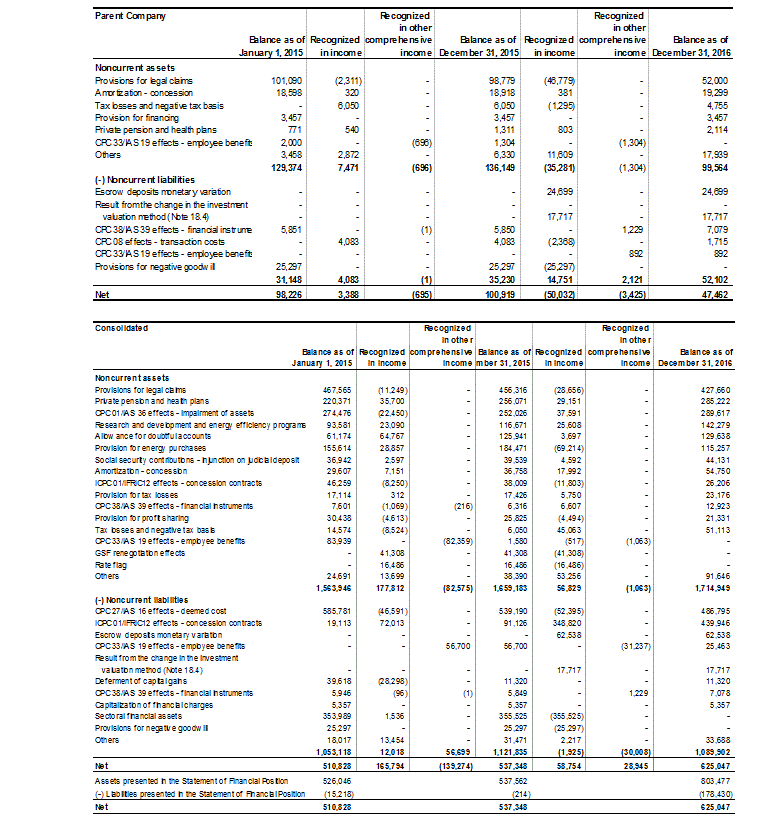
51
(CONVENIENCE TRANSLATION INTO ENGLISH FROM THE ORIGINAL PREVIOUSLY ISSUED IN PORTUGUESE)

13.2.2 Realization of deferred tax credits
Tax credits related to the pension and healthcare plans are realized according the movement of the related accrual based on the actuarial valuation conducted annually by an independent actuary. Deferred taxes on all other provisions will be realized as judicial rulings are issued and regulatory assets are realized.
The Company’s Board of Directors and Fiscal Council have approved and examined, respectively, the technical study prepared by the Chief Finance and Investor Relations, which points out to the realization of deferred taxes:

13.2.3 Unrecognized tax credits
As of December 31, 2016, UEG Araucária did not recognize income tax and social contribution credits on tax loss carryforwards and negative bases in the amount of R$16,925 because there is at present no reasonable assurance of generation of future taxable profits sufficient to absorb this assets.
52
(CONVENIENCE TRANSLATION INTO ENGLISH FROM THE ORIGINAL PREVIOUSLY ISSUED IN PORTUGUESE)

13.3 Other recoverable taxes and other taxes due
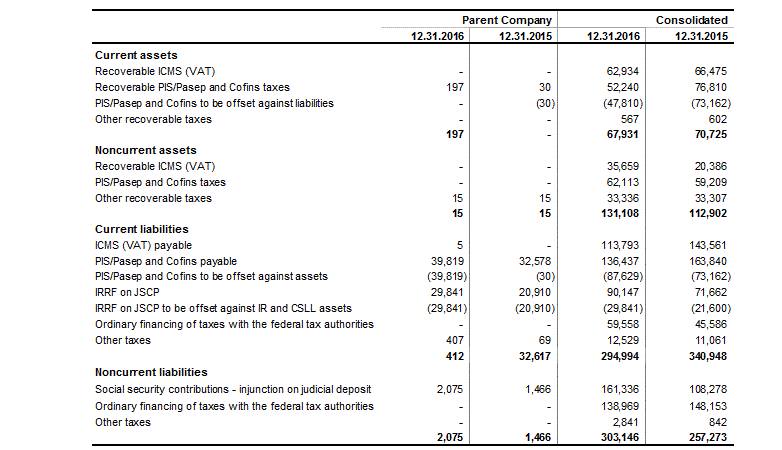
Sales and services revenues are subject to value-added tax (Imposto sobre Circulação de Mercadorias e Serviços or ICMS, in Portuguese) and service tax (Imposto sobre Serviços or ISS, in Portuguese), at the applicable rates, and to the PIS (Social Integration Program) and COFINS (Contribution for Social Security Funding).
Credits resulting from non-cumulative PIS and COFINS charges are accounted for deducting the operating costs in the statement of income.
Credits arising from non-cumulative ICMS, PIS and COFINS related to the purchase of assets are presented deducting the acquisition cost of these assets.
Prepayments or amounts that can be offset are presented in current and non-current assets, according to their expected realization.
53
(CONVENIENCE TRANSLATION INTO ENGLISH FROM THE ORIGINAL PREVIOUSLY ISSUED IN PORTUGUESE)

13.4 Reconciliation of provision for income tax (IRPJ) and social contribution (CSLL)
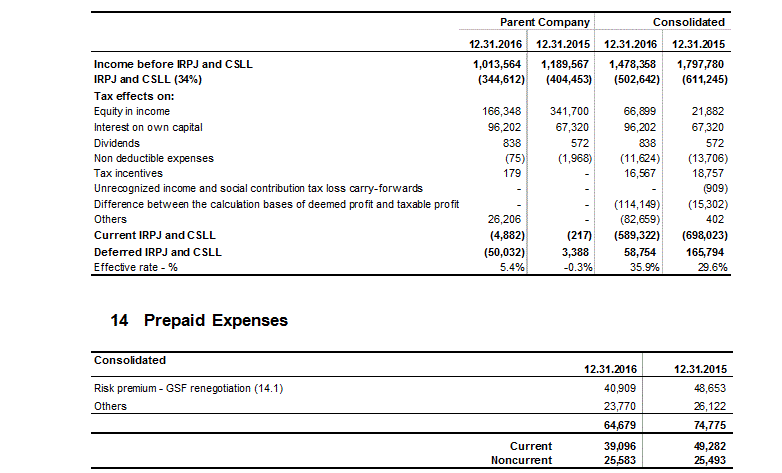
14.1 Risk premium – GSF (Generation Scaling Factor) renegotiation
During 2015, hydropower generation utilities were strongly impacted by the power generation below their physical guarantee due to the low level of the reservoirs affected by the rainfall shortage of the last years, and resulting in the need for liquidation with the CCEE, at the price of the PLD, of the deficit between the generated power and the sold power.
Hydropower generation utilities significantly affected by the low reservoir levels in recent years were benefited by the enactment of Law No. 13,203 by the Concession Authority on 12.08.2015, which allows hydropower generation companies subscribing to the Electricity Reallocation Mechanism (MRE) to reallocate their hydrological risk as from January 1, 2015.
ANEEL Regulatory Resolution No. 684 of 12.11.2015 establishes the criteria and other conditions for reallocation of hydrological risk by MRE members. In the Regulated Contracting Environment (ACR), hydrological risk was transferred to consumers against payment by the generation company of a risk premium into the Rate Tier Pooling Account (CCRBT). In the Free Contracting Environment (ACL), hydrological risk was reallocated through Reserve Capacity contracts.
54
(CONVENIENCE TRANSLATION INTO ENGLISH FROM THE ORIGINAL PREVIOUSLY ISSUED IN PORTUGUESE)

On December 23, 2015, following analysis of reallocation conditions in the ACR and ACL, Copel GeT and Elejor filed a request for renegotiation of hydrological risk in ACR of HPPs Mauá, Foz do Areia, Santa Clara and Fundão, which was consented through Decisions No. 84/2016 and 43/2016, respectively.
In accordance with Hydrological Risk Renegotiation Term and previously mentioned regulations, subsidiaries acquired the right to partially recover cost with GSF in 2015, in the amount of R$33.55 per average MW for SP100 product class, based on the risk premium contracted by them.
As of December 31, 2015, the Copel GeT and the Elejor recognized the amount of R$ 134,620 as Recovery of Power Purchase Cost through Renegotiation of GSF in income for the year, as follows:

Also as of December 31, 2015, R$48,653 was recorded under Prepaid Expenses and R$30,807 under Intangible Assets and charged to profit or loss, and R$55,160 was charged to CCEE liabilities.
A breakdown of these items as at 12.31.2016 is presented below:

55
(CONVENIENCE TRANSLATION INTO ENGLISH FROM THE ORIGINAL PREVIOUSLY ISSUED IN PORTUGUESE)

15 Receivable from related parties
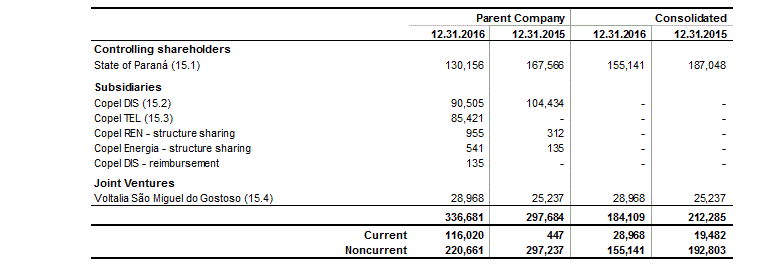
15.1 State of Paraná
15.1.1 Credit related to Luz Fraterna Program, R$115,890 (R$153,300 as of 12.31.2015)
The transfer of the receivables from the Luz Fraterna account of Copel DIS to Copel was suspended from the second half of 2015, considering Decree No. 2,789/2015, which created the possibility of using presumed ICMS (VAT tax) credits for the settlement of invoices referring to this program.In addition, State Law No. 18,875, dated 09.27.2016 authorized the State of Paraná to pay in installments the debts due and unpaid to Copel relating to services rendered up to the date of publication of said Law.
The settlement of the remaining balances is in the final stage of negotiation, through the use of presumed ICMS credits, according toDecree No. 2,789/2015. However, during the negotiations, the amount of R$37.410 was identified as controversial, due to the calculation method adopted by the Company to estimate the monetary variation.. Considering that the negotiations did not end until the date of issuance of these financial statements the Management recognized the reversal of such amount.
15.1.2 Credit referring to 2014 World Cup construction work, R$14,266 (R$14,266 as of 12.31.2015)
Copel’s executive board, through 2,119th Meeting, of July 28, 2014, approved the transfer of credit rights on costs related to mobility projects for FIFA 2014 World Soccer Cup made by Copel DIS and under the responsibility of the Paraná State government.
ANEEL agreed to the transaction through order No. 3,483/2015 and a Credit Assignment Agreement that transfers Copel DIS rights to Copel was executed.
In addition, State Law No. 18,875, dated 09.27.2016 authorized the State of Paraná to pay debts due and unpaid to Copel relating to services rendered up to the date of publication of said Law. Considering this legal forecast, the Administration is in the negotiation phase to define the terms of the settlement of this balance.
56
(CONVENIENCE TRANSLATION INTO ENGLISH FROM THE ORIGINAL PREVIOUSLY ISSUED IN PORTUGUESE)

15.1.3 Credit referring toPrograma Morar Bem, R$24,984 (R$19,482 as of 12.31.2015)
Programa Morar Bem Paraná, established by Decree No. 2,845/2011, is an agreement between Paraná State, Companhia de Habitação do Paraná (Cohapar) and Copel DIS, and is managed by Cohapar. Copel main attributions in this agreement are comprised of the construction of electric power distribution networks and housing projects consumer units service connections.
In addition, State Law No. 18,875, dated 09.27.2016 authorized the State of Paraná to pay debts due and unpaid to Copel relating to services rendered up to the date of publication of said Law. Considering this legal forecast, the Administration is in the negotiation phase to define the terms of the settlement of this balance.
15.2 Copel DIS - Financing transferred - STN
The Company transferred loans and financing to its wholly owned subsidiaries at the time of constitution in 2001. However, since the contracts for the transfers to the respective subsidiaries were not formalized with the financial institutions, they remain recognized in the Parent Company.
The balance with Copel DIS refers to STN financing transferred with the same levy of charges borne by the Company and shown as obligations for loans and financing at Copel DIS (Note 23).
15.3 Copel TEL - Loan
A loan agreement was signed on June 12, 2015 between Copel (lender) and Copel TEL (borrower), within the limit of R$ 20,000, changed to R$ 60,000 and R$120,000 pursuant to the first and second amendments to the agreements signed on October 14, 2016 and December 12, 2016, effective until December 29, 2017 and remuneration at 111.5% of the CDI rate, for the purpose of raising funds to comply with the borrower’s investment program. Of the limit approved, the borrower invested R$ 83,882. In 2016, the Company recorded financial income of R$ 1,539.
15.4 Voltalia São Miguel do Gostoso Participações S.A. - Loan
On May 14, 2015, a loan agreement was signed between Copel (lender) and Voltalia São Miguel do Gostoso Participações S.A. (borrower), with retroactive effects as from February 6, 2015, in the amount of R$29,400, plus IOF (tax on financial transactions) and with a two year term and a remuneration at 111.5% of the Interbank Deposit Certificate (CDI), aiming at providing working capital for financing the borrower’s activities and business. Of the limit approved, the borrower invested R$23,672. In 2016, the Company recorded financial income of R$3,509 (R$3,260 in 2015).
57
(CONVENIENCE TRANSLATION INTO ENGLISH FROM THE ORIGINAL PREVIOUSLY ISSUED IN PORTUGUESE)

16 Other Temporary Investments

16.1 Loans of preferred shares of Sanepar
As a result of the conversion of the common shares issued by Sanepar into preferred shares (Note 18.4), Copel entered into a Service Agreement for the Price Stabilization of Preferred Shares Issued by Companhia de Saneamento do Paraná - Sanepar on 12.19.2016. Under this agreement, 23,101,329 shares owned by Copel were lent, with fixed term of return of the securities to Copel of 45 days counted from the date of loan of the shares, with possibility of advance repayment. On January 20, 2017, all the shares returned to Copel’s ownership.
The Company has evaluated this operation in accordance with applicable accounting practices and concluded that this asset remains with its accounting classification as a long-term financial asset, even during the rental period.
17 Judicial Deposits

58
(CONVENIENCE TRANSLATION INTO ENGLISH FROM THE ORIGINAL PREVIOUSLY ISSUED IN PORTUGUESE)

18 Investments
18.1 Changes in investments
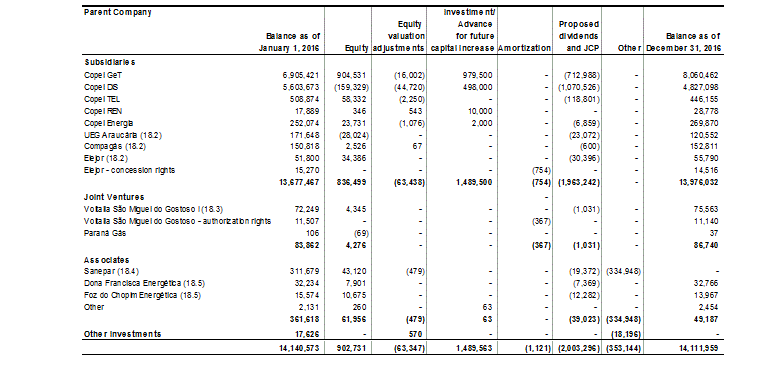
59
(CONVENIENCE TRANSLATION INTO ENGLISH FROM THE ORIGINAL PREVIOUSLY ISSUED IN PORTUGUESE)

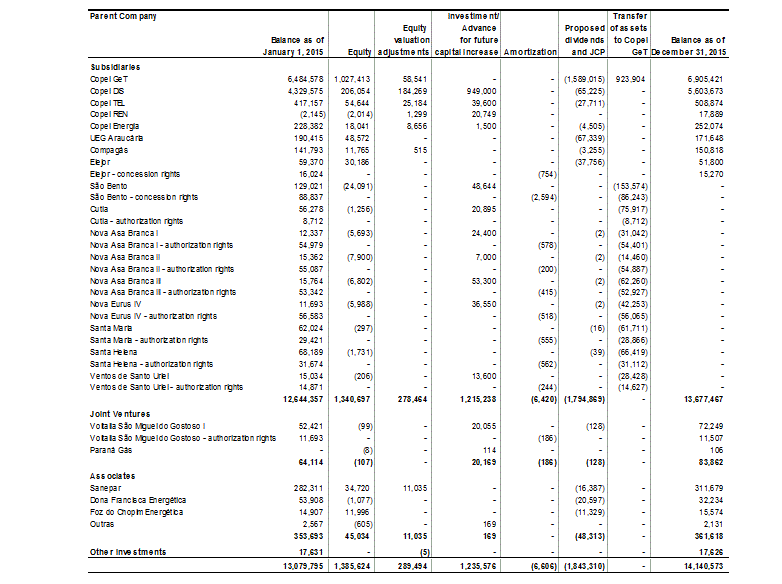
60
(CONVENIENCE TRANSLATION INTO ENGLISH FROM THE ORIGINAL PREVIOUSLY ISSUED IN PORTUGUESE)

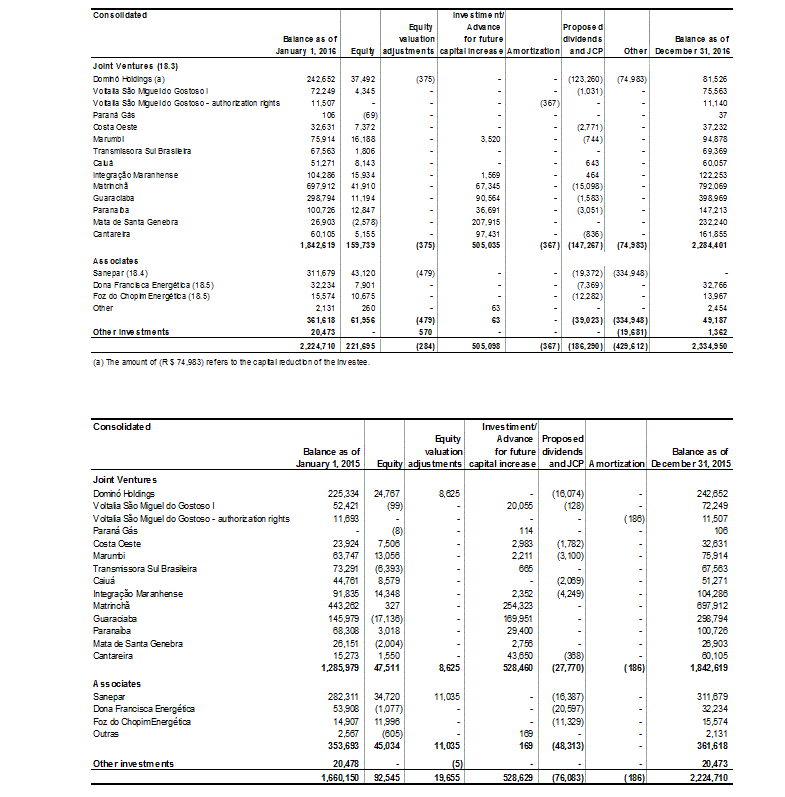
61
(CONVENIENCE TRANSLATION INTO ENGLISH FROM THE ORIGINAL PREVIOUSLY ISSUED IN PORTUGUESE)

18.2 Subsidiaries with non-controlling interest
18.2.1 Summarized financial information

18.2.2 Changes in equity attributable to non-controlling shareholders
62
(CONVENIENCE TRANSLATION INTO ENGLISH FROM THE ORIGINAL PREVIOUSLY ISSUED IN PORTUGUESE)

18.3 Total balances of the groups of assets, liabilities and profit or loss of the main joint ventures
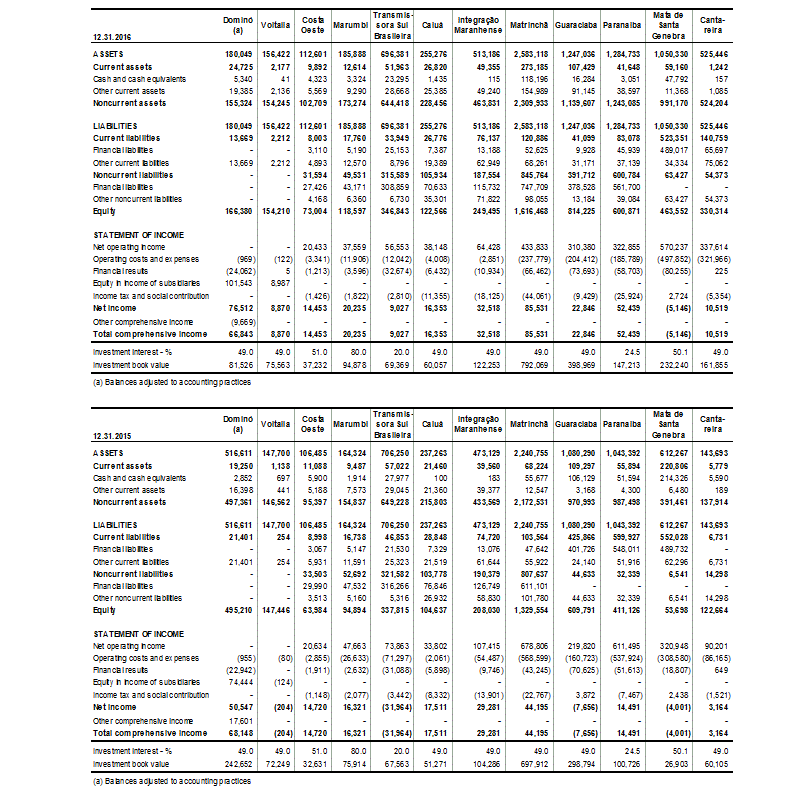
63
(CONVENIENCE TRANSLATION INTO ENGLISH FROM THE ORIGINAL PREVIOUSLY ISSUED IN PORTUGUESE)

Copel's interest in the commitments assumed from its joint ventures is equivalent to R$503,546 and in contingent liabilities is equivalent to R$834.
18.4 Companhia de Saneamento do Paraná - Sanepar
Dominó Holdings, joint venture of Copel Comercialização, requested from Sanepar the conversion of 41,000,000 common shares issued by Sanepar and owned by Dominó Holdings into an equal number of preferred shares.
On November 24, 2016, the share conversion was made and Dominó Holdings, which held 24.6747%, currently holds 9.6702% of the common shares issued by Sanepar. As a result of this event, the Shareholders’ Agreement, entered into between the State of Paraná and Dominó Holdings, was automatically terminated, withdrawing from Dominó Holdings the significant influence on its investment in Sanepar, which is no longer classified as an associate and is now considered an available-for-sale financial asset.
Copel held 7.6252% of its direct interest in Sanepar, but it had a significant influence in this investee through Dominó Holdings, due to the existence of the Shareholders' Agreement. With the termination of this agreement, Copel also failed to classify its investment in Sanepar as an associate and classified it as an available-for-sale financial asset in the Long-Term Assets under Other Temporary Investments. Accordingly, its recognition is no longer recorded under the equity method, but rather at fair value.
As a result of the change in the method to account for Copel's investment in Sanepar, from equity method to fair value, a gain of R$52,107 was recognized (Note 33.6). The balance of R$11,189 recognized in Other Comprehensive Income in Copel’s Equity related to this investment was reclassified to Profit Retention Reserve. The initial recognition as a financial asset totaled R$387,055.
64
(CONVENIENCE TRANSLATION INTO ENGLISH FROM THE ORIGINAL PREVIOUSLY ISSUED IN PORTUGUESE)

18.5 Total balances of the groups of assets, liabilities and profit or loss of the main associates
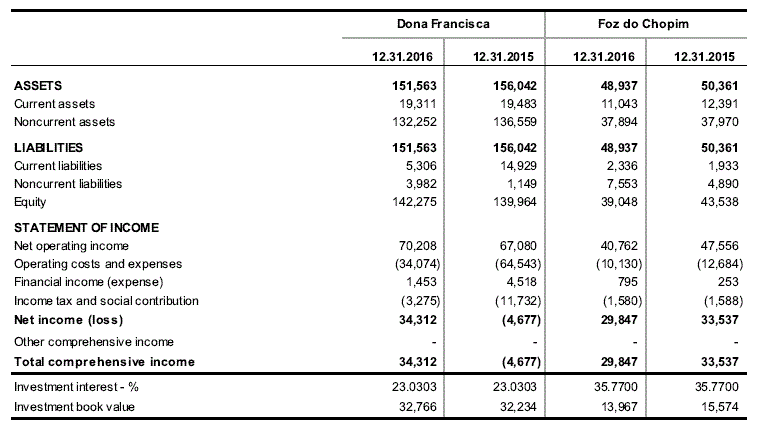
Copel's interest in the contingent liabilities of its associates is equivalent to R$55,565.
19 Property, Plant and Equipment
The Company and its subsidiaries record assets used in administrative and commercial facilities for generation of electric power and telecommunication services in property, plant and equipment. Investments in electric power transmission and distribution and in piped gas distribution are recorded in financial assets and/or intangible assets as CPC 04 / IAS 38, ICPC 01 and OCPC 05 / IFRIC 12 (Notes 4.3.9 and 4.6).
On initial adoption of IFRS, property, plant and equipment were measured at fair value with recognition of their deemed cost.
Under Articles 63 and 64 of Decree No. 41,019/1957 and Article 19 of Decree No. 2,003/1996, the assets and facilities used mostly in the generation of power are attached to these services and cannot be withdrawn, sold, assigned, or mortgaged without the prior written consent of the regulatory agency. ANEEL Resolution No. 691/2015, however, regulates the release of assets from the concessions of the Public Electric Power Service, granting prior authorization to release the property and other fixed assets not usable by the concession when they are destined for sale, and also determining that the sales proceeds less respective charges be deposited in a restricted bank account to be invested in the concession.
65
(CONVENIENCE TRANSLATION INTO ENGLISH FROM THE ORIGINAL PREVIOUSLY ISSUED IN PORTUGUESE)

19.1 Property, plant and equipment by asset class
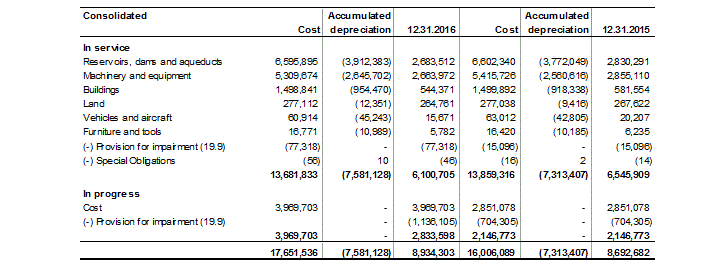
19.2 Changes in property, plant and equipment
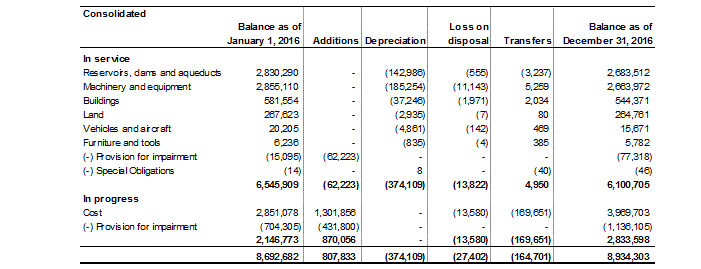
66
(CONVENIENCE TRANSLATION INTO ENGLISH FROM THE ORIGINAL PREVIOUSLY ISSUED IN PORTUGUESE)

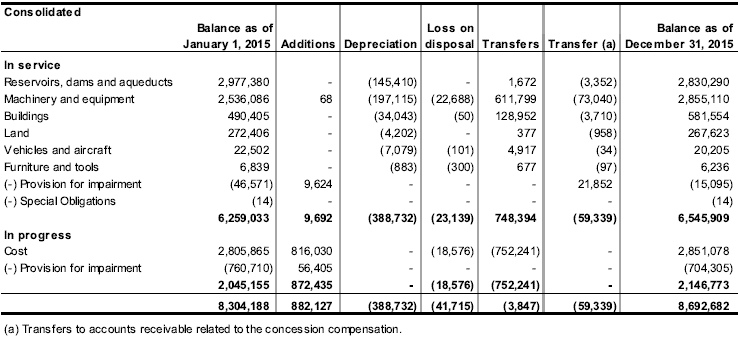
19.3 Effects on property, plant and equipment of the end date and the extension of the electric power generation concessions and the quota regime
Since September 12, 2012, with issuance of Provisional Measure No. 579, enacted into Law No. 12,783/2013, hydroelectric and thermoelectric power generation concessions may be extended, only once, at the discretion of the Granting Authority for a period of up to 30 and 20 years, respectively.
Extension of concessions for hydroelectric power generation is subject to acceptance of certain conditions established by the Granting Authority, such as: (i) change in remuneration to tariff calculated by ANEEL for each plant; (ii) allocation of the plant’s physical power and capacity guarantee shares to concessionaires and licensees of distribution utilities; (iii) submission to service quality standards determined by ANEEL; and (iv) agreement with amounts established as indemnity of assets related to the concession.
With the expiration of HPP Rio dos Patos, HPP GPS and HPP Mourão concessions, investments subject to indemnity were transferred to account “Accounts receivable related to the concession extension”, considering the right to indemnity (Note 11).
Also in relation to current regulation, a concessionaire has a period to request the extension of the concession of up to 60 months before the term end of hydroelectric power generation plants, and of up to 24 months for thermoelectric plants.
Current regulatory framework also determines that, if the concessionaire opts to extend the concession, the Granting Authority may advance the effects of the extension by up to 60 months from the final agreement term or the concession term, defining the initial tariff.
67
(CONVENIENCE TRANSLATION INTO ENGLISH FROM THE ORIGINAL PREVIOUSLY ISSUED IN PORTUGUESE)

If the concession period is not extended, the Granting Authority will open an auction or bid for a concession period of up to 30 years, considering as bid winner, the lowest tariff value and the highest offer to pay onerous grant.
Both in cases of early extension as new bid for a new concession term, Management understands it has an assured contractual right to receive an indemnity of the assets related to the public service concessions, based on the new replacement value (VNR), that will consider accumulated depreciation and amortization as of the date of initial operation of the facility.
19.4 Average depreciation rates
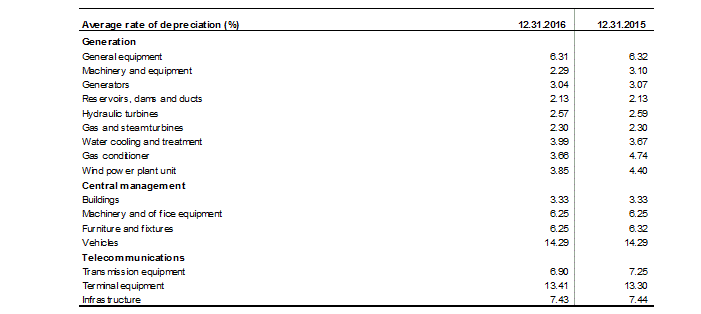
Depreciation of the assets which are part of the original project of Mauá, Colíder, Cavernoso II, Santa Clara and Fundão HPPs
Copel GeT has assets from the original project of Mauá, Colíder and Cavernoso II Hydroelectric Power Plants, and Elejor of Santa Clara and Fundão Hydroelectric Power Plant, for which the Company does not expect to receive full guarantee from the Granting Authority that it will indemnify the Company by the end ofthe concession period for the residual value of the assets which are part of the original project. This interpretation is based on Law No. 8,987/95 and Decree No. 2,003/96, which regulates the production of electricity by independent producers.
Accordingly, from the date these assets start operations they are depreciated at the rates set by ANEEL (Brazilian Electricity Regulatory Agency), limited to the concession period.
As established on concession agreements, subsequent investments not forecast in the original project, provided that they are approved by the Granting Authority and have not yet been amortized, will be indemnified by the end of concessions. Therefore, these assets will be depreciated at the rates set by ANEEL, from the operating start.
68
(CONVENIENCE TRANSLATION INTO ENGLISH FROM THE ORIGINAL PREVIOUSLY ISSUED IN PORTUGUESE)

19.5 Costs of loans, financing and debentures capitalized
The costs of loans, financing and debentures capitalized during the year of 2016 amounted to R$7,142, at an average rate of 0.26% p.y. (R$28,948, at an average rate of 6.43% p.y., in 2015).
19.6 HPP Colíder
On July 30, 2010, at the ANEEL Auction of Power from New Projects 003/10, Copel GeT won the rights to the concession of the Colíder Hydroelectric Power Plant, valid for 35 years from the date of signature of Concession Agreement No. 001/11-MME-HPP Colíder, which took place on January 17, 2011.
This project is included in the Federal Government’s Growth Acceleration Program (PAC) and will comprise a main powerhouse of 300 MW, which is enough to supply approximately one million people. The facility will take advantage of the hydroelectric potential discovered on the Teles Pires River, between the towns of Nova Canaã do Norte and Itaúba, in the northern region of the State of Mato Grosso.
The National Bank for Economic and Social Development (BNDES) approved the classification of the HPP Colíder project for financial support feasibility analysis and the signed financing agreement, amounted to R$1,041,155 (Note 23). Until December 31, 2016 the financing amount of R$907,608 was released.
Due to unforeseeable events or force majeure and acts of public authorities, such as difficulties related to environmental licensing, supplier delays in meeting the equipment delivery schedule, electromechanical assembly services and the construction of the transmission line associated to the plant, the project suffered impacts on its schedule, and the commercial operation forecast was revised, with the first generating unit scheduled for December 2017, while the third and final generating unit is scheduled to come on line in April 2018. Due to a delay in the construction work's schedule, an impairment is still recorded for the assets in the amount of R$490,701 as of December 31, 2016 (R$642,551 as of December 31, 2015), as per Note 19.9.
The Colíder Hydroelectric Power Plant’s power output was sold at an ANEEL auction at a final price of R$103.40/MWh, as of July 1, 2010, adjusted according to the variation of IPCA inflation index to R$158.74 as of December 31, 2016. 125 averages MW were sold, for supply starting on January 2015, for 30 years. Copel GeT submitted an application to ANEEL to exclude its responsibility, so that the obligation to supply energy could be postponed. In a first judgement, the request was not accepted, Copel GeT filed an application for reconsideration of the decision, which was also denied on March 14, 2017. The Company will refer the matter to the court with the conviction that the Agency's decision will be reversed.
The Company has complied with its commitments of energy supply as follows:
· From January 2015 to September 2016: with energy surpluses not contracted in its other plants;
69
(CONVENIENCE TRANSLATION INTO ENGLISH FROM THE ORIGINAL PREVIOUSLY ISSUED IN PORTUGUESE)

· From October 2016 to December 2017: with reduction of all supply contracts due to the offer made to the New Energy and Decrease Clearing Facility (“Mecanismo de Compensação de Sobras e Déficits - MCSD de Energia Nova”).
On December 31, 2016, the assured power of the project was revised by MME Ordinance No. 258, going from 179.6 average MW to 177.9 average MW, once the machinery has been fully installed.
As of December 31, 2016, the expenditures on this project totaled R$2,053,700.
Total commitments already assumed with suppliers of equipment and services in connection with the Colíder Hydroelectric Power Plant amounted to R$65,061, as of December 31, 2016.
19.7 Joint operations - consortiums
The amounts recorded under property, plant and equipment referring to the participations of Copel GeT in consortiums are shown below:

19.7.1 Consórcio Empreendedor Baixo Iguaçu – Cebi
The purpose of the consortium is to build and operate the project known as Baixo Iguaçu Hydroelectric Plant, with minimum installed capacity of 350.20 MW, located on the Iguaçu River between the municipalities of Capanema and Capitão Leônidas Marques, and between the Governador José Richa Hydroelectric Plant and the Iguaçu National Park, in the State of Paraná.
The start of commercial operation of Unit 1 is scheduled for 11.27.2018 and Units 2 and 3 for December 2018 and January 2019, respectively. The previous schedule has been changed due to the suspension of the Installation License, as per the decision of the Federal Court of the 4th Region (TRF-RS), held on June 16, 2014, that stopped the construction work as of July of that year. In March 2015, a decision authorizing the Company to resume construction work was published. However, ICMBio imposed additional conditions for granting an environmental license to the Company, which prevented it from resuming construction work. Cebi sent IAP – Environmental Institute of Paraná the information necessary for those conditions to be met and in August 2015 the license was issue. Having obtained the IAP license, and after technical and contractual adjustments required due to the long downtime, the works were resumed as of 02.01.2016.
70
(CONVENIENCE TRANSLATION INTO ENGLISH FROM THE ORIGINAL PREVIOUSLY ISSUED IN PORTUGUESE)

On August 23, 2016, the Company signed the 2nd Amendment to the Concession Agreement with the purpose of formalizing the redefinition of the work schedule, acknowledging in favor of Cebi the exclusion of responsibility for the delay in implementing the project for a period of 756 days, which was considered as an extension of the concession period, which originally was until 08.19.2047 and became 09.14.2049.
On 01.18.2017 the assured power of the project was revised by MME Ordinance No. 11, going from 172.8 average MW to 171.3 average MW, once the machinery has been fully installed.
Total commitments already assumed with suppliers of equipment and services in connection with the consortium amounted to R$193,085, as of December 31, 2016.
19.7.2 Consórcio Tapajós
On August 10, 2016, the Management decided on the withdrawal of Copel GeT from the consortium with eight other companies to carry out studies on the Tapajós and Jamanxim rivers in the northern region of Brazil, covering feasibility and environmental studies of five hydroelectric plants with a total installed capacity of 10,682 MW.
Due to legal and environmental restrictions and uncertainties about the auction date, on September 30, 2016, the Company recorded a provision for impairment in the total amount of the investments in the statement of income, in other operating expenses, under Provisions and reversals (Note 33.4).
19.8 Cutia wind farm project
The largest Copel wind farm called Cutia is under construction, and is divided into two large complexes:
· Cutia Complex: composed of seven wind farms (Guajiru, Jangada, Potiguar, Cutia, Maria Helena, Esperança do Nordeste and Paraíso do Ventos do Nordeste) with 180.6 MW of total installed capacity, 71.4 average MW of assured power, all located in Rio Grande do Norte. The power that will be generated by the farms was sold on the 6th Reserve Auction that was held on October 31, 2014, at an average historical price of R$144.00/MWh, and the initial forecast for commercial generation of these farms is September 2017; and
· Bento Miguel Complex:Composed of six wind farms (São Bento do Norte I, São Bento do Norte II, São Bento do Norte III, São Miguel I, São Miguel II and São Miguel III) with a total installed capacity of 132.3 MW, 54.8 average MW assured power, all also located in Rio Grande do Norte. The power that will be generated by the farms was sold on the 20th New Energy Auction that was held on 11.28.2014, at anaverage historical price of R$136.97/MWh, and the initial forecast for commercial generation of these farms is January 2019.
71
(CONVENIENCE TRANSLATION INTO ENGLISH FROM THE ORIGINAL PREVIOUSLY ISSUED IN PORTUGUESE)

The following are the relevant milestones for the execution of the works from January 2016 to January 2017. In January 2016, the environmental licenses were obtained, beginning the access road runs, bases and assembly platform of the generator set. In April 2016, construction of the Cutia Substation was started, with installed capacity of three 120 MVA transformers and twenty six 34 kV circuits, two circuits for each wind farm. In October 2016, with the advanced stage of construction services in some farms, the first generator sets began to be delivered, and Torres Productive Center began operating, a structure in which precast elements that will constitute the towers of support of the wind turbines will be produced. In January 2017, the process of assembling the towers of the wind turbines began and the planned deadlines are within the forecast.
As of December 31, 2016, the total commitments entered into with suppliers of equipment and services for the wind farms under construction totaled R$2,211,450. The amount refers primarily to supply of wind turbines.
19.9 Asset impairment from generation segment
The main principles underpinning the conclusions of Copel’s impairment tests are listed below:
· Lower CGU level: generation concessions and authorizations, analyzed individually;
· measurement of value in use: based on future cash flows, derived from the continuous use of the asset until the end of its useful life, in constant currency, discounted to present value at an actual discount rate; and
· fair value measurement: a market approach was used considering the Multiples of Comparable Companies Valuation Method - CCA (“Método de Múltiplos de Empresas Comparáveis - MEC”).
The respective cash flows are estimated based on the operating results achieved in the Company's annual corporate budget, approved at a regular meeting of the Board of Directors, with a consequent multi-annual budget, and future trends in the electric sector.
As for the period for the analysis, the Company takes into account the expiration date of each concession.
As for market growth, Copel’s projections are consistent with historical data and the Brazilian economy’s growth prospects.
The respective cash flows are discounted at average rates that range between 5.7% (post taxes) and 12.13% (before taxes), obtained through a methodology commonly employed by the market, supported by the regulator and approved by the Management.
The Company classified into level 3 the calculation of the recoverable value when measured at its fair value, according to the technique presented in the previous paragraphs.
72
(CONVENIENCE TRANSLATION INTO ENGLISH FROM THE ORIGINAL PREVIOUSLY ISSUED IN PORTUGUESE)

The Company’s management understands it has an assured contractual right with respect to compensation of the assets related to the end of the public service concessions, using in the calculation of recovery the new replacement value (VNR). Thus, the residual value of the assets upon expiration of concession has been considered.
In 2015 and 2016, the Company tested the recoverable value of its assets. As a result of these analyses, the balance of the impairment suffered the following changes in the period:

The main balance of impairment and their respective impacts on income for the year are as follows:
· R$595,489 refers to the assets of the Colíder HPP, under construction, located in the State of Mato Grosso. The calculation of the value in use considered: premises and budgets of the Company and discount rate post tax in constant currency of 5.70% p.y. (5.11% p.y. post tax in 2015), which derives from the WACC methodology for the electricity generation segment. This loss was mainly recognized as a result of: (i) increase in the discount rate; (Ii) delays in implementation, resulting from unforeseeable events or force majeure and acts of public authorities, such as difficulties related to environmental licensing, supplier delays in meeting the equipment delivery schedule, electromechanical assembly services and the construction of the transmission line associated to the plant. The effect on the result of this year was a reversal of estimated losses in R$47,062.
· R$314,464 refers to assets of wind generation under construction in the State of Rio Grande do Norte. The calculation of the value in use considered: the Company's assumptions and budgets and discount rate before tax in constant currency of 8.06% (7.74% in 2015), which derives from the WACC methodology for the energy generation segment, adjusted to the specific condition of taxation of those undertakings. This loss was mainly recognized as a result of: (i) increase in the discount rate and (ii) increase in the investment originally planned, with effect on results for this year.
· R$108,238 refers to the thermal generation assets located in the State of Paraná. For the TPP Araucária, which operates in the Merchant mode, the calculation of value in use considered: premises and budgets of the Company, discount rate before tax in constant currency of 12.13% (7.74% in 2015), which is derived from the WACC methodology for the electric power generation segment, plus additional risk associated with revenue variation. For the TPP Figueira, the calculation of the value in use considered the flow horizon associated with the term of the coal subsidy, and the discount rate before tax in constant currency of 8.63% (7.74% in 2015), which derives from the WACC methodology for the electric power generation segment. These losses were recognized mainly due to: (i) increase in thediscount rate, (ii) Company's projections regarding the dispatch expectation, in the case of UEGA, and the volume of future investments, in the case of Figueira, with effect in this year.
73
(CONVENIENCE TRANSLATION INTO ENGLISH FROM THE ORIGINAL PREVIOUSLY ISSUED IN PORTUGUESE)

· R$195,232 refers to other hydraulic generation assets in the State of Paraná. The calculation of value in use considered: the Company's assumptions and budgets and discount rate before tax in constant currency of 8.63% (7.74% in 2015), which derives from the WACC methodology for the energy generation segment. This loss was recognized, mainly, due to expected delays in entering into commercial operations, increase in planned investments and increase in the discount rate observed in the period. The effect on the result of this year was a complement of estimated losses in the amount of R$118,383.
The Company recorded the the effects on income for the period in operating costs, under Estimated losses, provisions and reversals (Note 33.4).
20 Intangible Assets
20.1 Changes in intangible assets
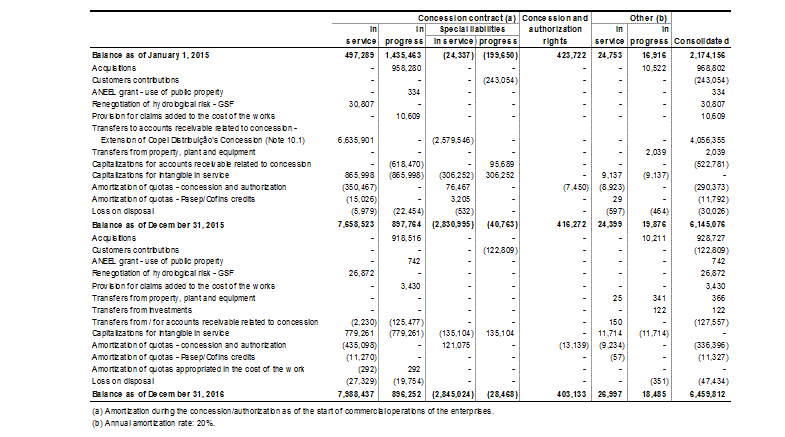
74
(CONVENIENCE TRANSLATION INTO ENGLISH FROM THE ORIGINAL PREVIOUSLY ISSUED IN PORTUGUESE)

20.2 Copel DIS
In accordance with Technical Interpretation ICPC 01 (R1) / IFRIC 12, accounting concessions, the share of infrastructure that will be used during concession was recorded in Intangible Assets, composed of the assets of the electricity distribution, net of interests of consumers (special obligations).
Special liabilities comprise customers’ contributions, Federal Government grants, federal, state, and municipal funds, and special credits assigned to the investments in facilities related to a concession.
The amortization of the special liabilities is calculated using the average rate of depreciation of assets that comprises the infrastructure, and the balance of special liabilities contained in intangible assets will be amortized over the concession period.
Special obligations are not financial liabilities or shareholder’s credits.
20.3 Costs of loans, financing and debentures capitalized
The costs of loans, financing and debentures capitalized during 2016 amounted to R$7,608, at an average rate of 0.41% p.y. (R$32,579, at an average rate of 1.78% p.y., in 2015).
21 Payroll, social charges and accruals

75
(CONVENIENCE TRANSLATION INTO ENGLISH FROM THE ORIGINAL PREVIOUSLY ISSUED IN PORTUGUESE)

22 Suppliers

22.1 Electricity - CCEE
In September 2016, Copel GeT settled the liabilities owned to CCEE, due to the renegotiation of hydrological risk (Note 14.1), amounting to R$321,640, which was paid as of April 18, 2016 in six installments with interest and inflation adjustment and after deducting the credit determined in the month of settlement.
76
(CONVENIENCE TRANSLATION INTO ENGLISH FROM THE ORIGINAL PREVIOUSLY ISSUED IN PORTUGUESE)

22.2 Main power purchase agreements
The power purchase agreements signed in the regulated power trading environment, shown at original value and adjusted annually according to the IPCA index:
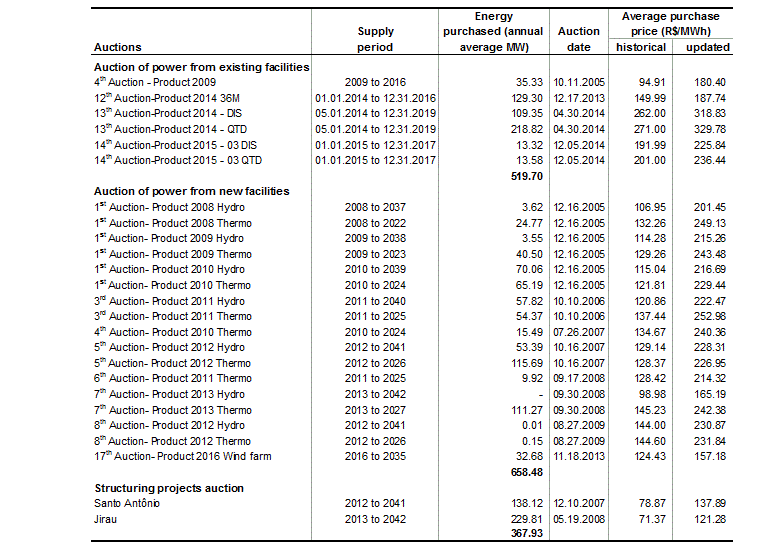
77
(CONVENIENCE TRANSLATION INTO ENGLISH FROM THE ORIGINAL PREVIOUSLY ISSUED IN PORTUGUESE)

23 Loans and Financing

78
(CONVENIENCE TRANSLATION INTO ENGLISH FROM THE ORIGINAL PREVIOUSLY ISSUED IN PORTUGUESE)

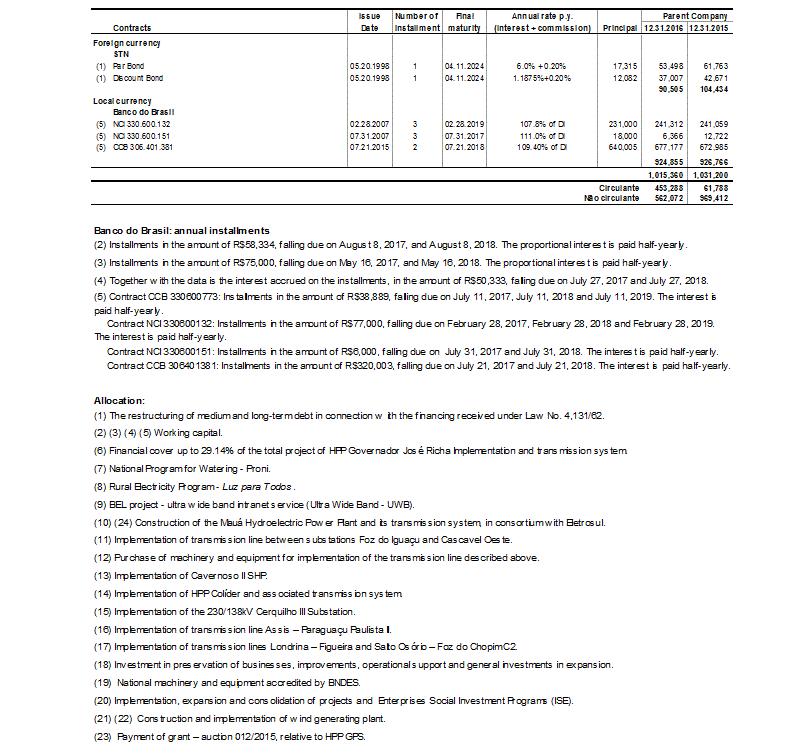
79
(CONVENIENCE TRANSLATION INTO ENGLISH FROM THE ORIGINAL PREVIOUSLY ISSUED IN PORTUGUESE)

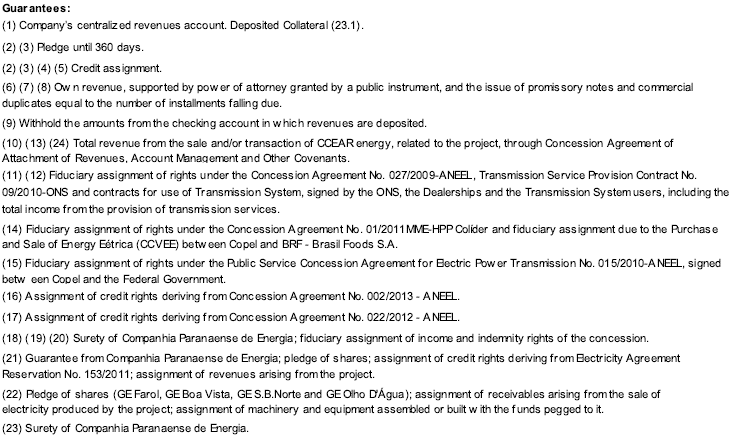
23.1 Collateral and escrow deposits - STN
Guarantees provided in the form of Par Bonds for R$42,988 (R$50,689 at December 31, 2015), and Discount Bonds in the amount of R$30,086 (R$35,448 at December 31, 2015), to be used to repay amounts of principal corresponding to STN contracts, when these payments are due on April 11, 2024. The amounts are updated by applying the weighted average percentage changes of United States Treasury Zero Coupon bond prices, by the share of each series of the instrument in the portfolio of collateral for principal, provided in the context of the Brazilian Financing Plan - 1992.
80
(CONVENIENCE TRANSLATION INTO ENGLISH FROM THE ORIGINAL PREVIOUSLY ISSUED IN PORTUGUESE)

23.2 Breakdown of loans and financing by currency and index
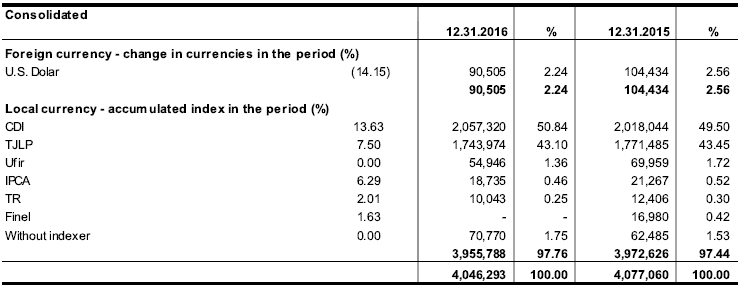
23.3 Maturity of noncurrent installments

23.4 Changes in loans and financing
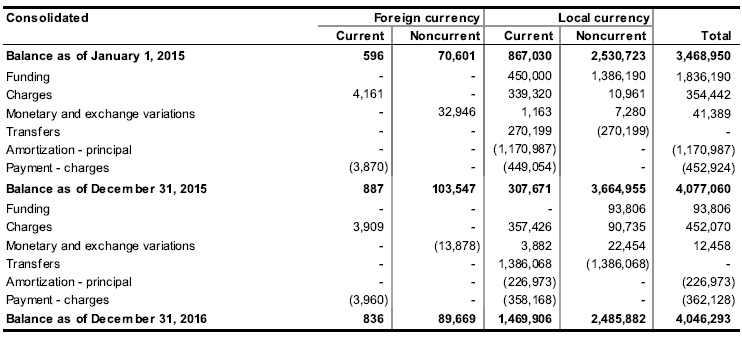
81
(CONVENIENCE TRANSLATION INTO ENGLISH FROM THE ORIGINAL PREVIOUSLY ISSUED IN PORTUGUESE)

23.5 Covenants
The Company and its subsidiaries signed loan and financing agreements containing covenants that require economic and financial ratios to remain within pre-determined parameters, requiring annual fulfillment and other conditions to be observed, such as not making any alteration to the Company’s shareholdings in the capital stock of subsidiaries that would alter control without prior consent. Failing to fulfill these conditions may lead to accelerated debt repayment and/or fines.
As of December 31, 2016, all the agreed conditions had been fulfilled.
Below we highlight the financial covenants present in the loan and financing agreements:
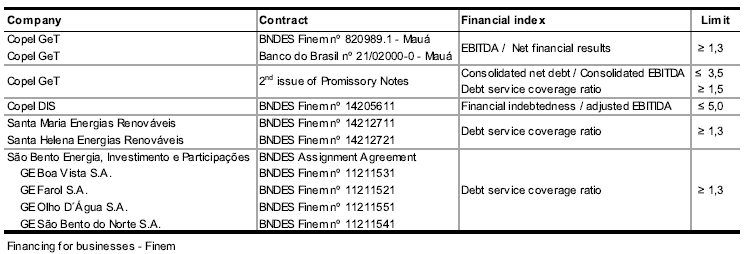
82
(CONVENIENCE TRANSLATION INTO ENGLISH FROM THE ORIGINAL PREVIOUSLY ISSUED IN PORTUGUESE)

24 Debentures
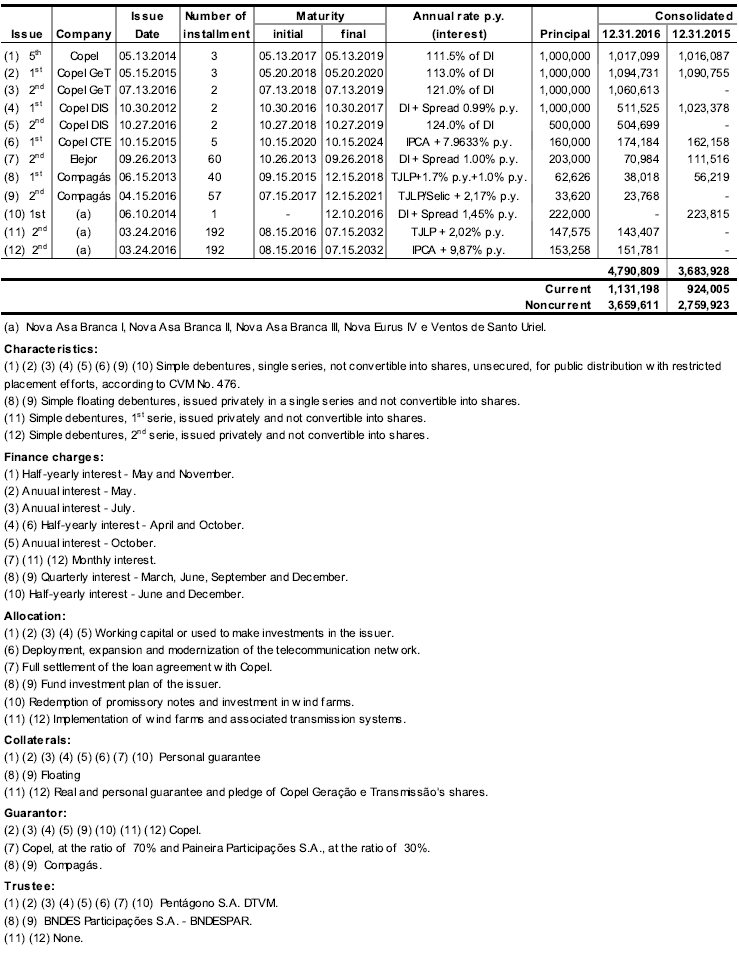
83
(CONVENIENCE TRANSLATION INTO ENGLISH FROM THE ORIGINAL PREVIOUSLY ISSUED IN PORTUGUESE)

24.1 Maturity of noncurrent installments

24.2 Changes in debentures
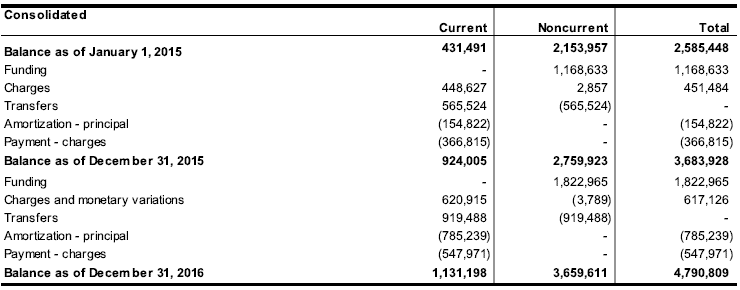
24.3 Covenants
Copel and its subsidiaries issued debentures containing covenants that require certain economic and financial ratios to be kept within pre-determined parameters, requiring annual fulfillment and other conditions to be observed, such as not making any alteration to the Company’s shareholdings in capital stock that would alter control without prior consent from the debenture holders; not paying out dividends or interest on capital if it is in arrears in relation to honoring any of its financial obligations or not keeping the financial ratios as determined without prior written consent of the debenture holders. Failing to fulfill these conditions may lead to accelerated redemption of debentures and regulatory penalties.
On December 31, 2016, all the agreed conditions had been fulfilled.
84
(CONVENIENCE TRANSLATION INTO ENGLISH FROM THE ORIGINAL PREVIOUSLY ISSUED IN PORTUGUESE)

Below we highlight the financial covenants present in the loan and financing agreements:
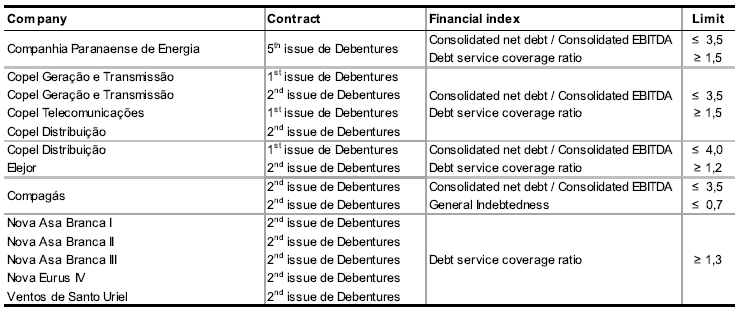
25 Post-employment benefits
The Company and its subsidiaries sponsor private retirement and pension plans (Unified Pension Plan and Pension Plan III) and medical and dental care (“ProSaúde II” and “ProSaúde III” plans’ regulations ) for their active employees and their dependents.
The lifetime sponsorship of the healthcare plan for retirees, pensioners and legal dependents is only applied to “Prosaúde II” plan participants.The amounts of these actuarial obligations (contributions, costs, liabilities, and/or assets) are calculated annually by an independent actuary at year end.
The benefits plan assets are valued at market values (mark-to-market).
The amount of the net assistance liability is recognized at the present value of the actuarial liability, less the fair value of the plan assets.
The adoption of the projected credit unit method adds each year of service as the source of an additional benefit unit, adding up to the calculation of the final liability.
Other actuarial assumptions are used which take into account biometric and economic tables in addition to historical data from the benefits plans, obtained from the manager of these plans, Fundação Copel de Previdência e Assistência Social.
Actuarial gains or losses caused by changes in assumptions and/or actuarial adjustments are recognized in other comprehensive income.
85
(CONVENIENCE TRANSLATION INTO ENGLISH FROM THE ORIGINAL PREVIOUSLY ISSUED IN PORTUGUESE)

25.1 Benefit Pension Plan
The unified pension plan is a Defined Benefit Plan - BD in which the income is predetermined, according to each individual’s salary, and pension plan III is a Variable Contribution Plan - CV.
The Defined Benefit plan - BD is a closed plan for new participants since 1998 and has only 39 active participants out of a total of 4,502 as of December 31, 2016. The Variable Contribution plan - CV is the only plan available for new participants.
The costs assumed by the sponsors for these plans are recognized according to the actuarial evaluation prepared annually by independent actuaries in accordance with CPC 33 (R1) and correlated to IAS 19 (R1) and IFRIC 14. The economic and financial assumptions for purposes of the actuarial evaluation are discussed with the independent actuaries and approved by the sponsor’s management.
25.2 Healthcare Plan
The Company and its subsidiaries allocate resources for the coverage of healthcare expenses incurred by their employees and their dependents, within rules, limits, and conditions set in “ProSaúde II” and “ProSaúde III” plans’ regulations. Coverage includes periodic medical exams in both plans and is only extended to all retirees and pensioners for life in the “ProSaúde II” plan.
25.3 Statement of financial position and statement of income
Amounts recognized in liabilities, under Post-employment Benefits, are summarized below:

The consolidated amounts recognized in the statement of income are shown below:

86
(CONVENIENCE TRANSLATION INTO ENGLISH FROM THE ORIGINAL PREVIOUSLY ISSUED IN PORTUGUESE)

25.4 Changes in post-employment benefits
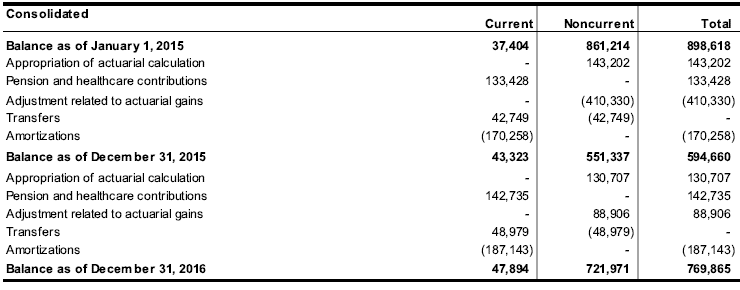
25.5 Actuarial valuation in accordance with CPC 33 (R1) / IAS 19
25.5.1 Actuarial assumptions
The actuarial assumptions used to determine the amounts of liabilities and costs for 2016 and 2015 are shown below:
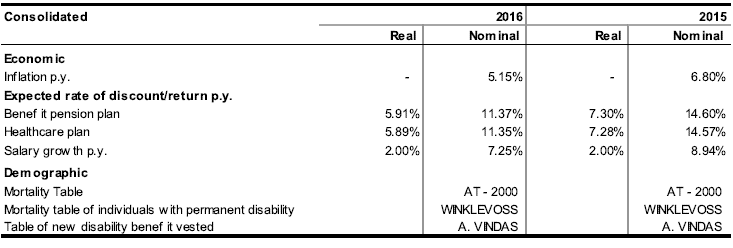
25.5.2 Number of participants and beneficiaries

87
(CONVENIENCE TRANSLATION INTO ENGLISH FROM THE ORIGINAL PREVIOUSLY ISSUED IN PORTUGUESE)

25.5.3 Life expectancy from the average age - Annuity Table AT-2000 (in years)

The average age of inactive participants of the healthcare and pension plans of the Company and its subsidiaries is 66.2 years.
25.5.4 Actuarial evaluation
Based on the review of the assumptions, the values of the pension plan as of December 31, 2016 amounted to a plan surplus of R$527,699, while the position at December 31, 2015, was R$312,586. The current applicable legislation does not permit any significant reduction in contributions or reimbursements to the Company based on the current surplus in this plan. For this reason, the Company did not record an asset on its December 31, 2016 balance sheet reflecting any such right to reduce contributions or refund surplus or other amounts.

The Company and its subsidiaries made adjustments to their assistance liabilities through the actuarial report issued on December 31, 2016, when an actuarial gain of R$89,107 was recorded in other comprehensive income.
88
(CONVENIENCE TRANSLATION INTO ENGLISH FROM THE ORIGINAL PREVIOUSLY ISSUED IN PORTUGUESE)

25.5.5 Changes in actuarial liabilities
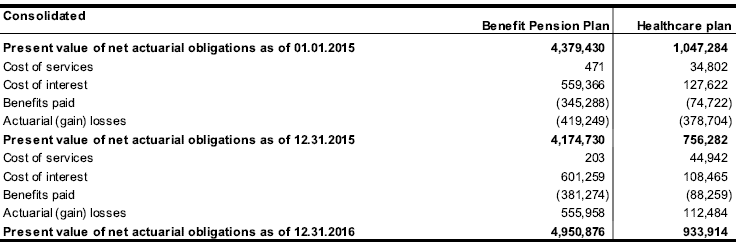
25.5.6 Changes in actuarial assets
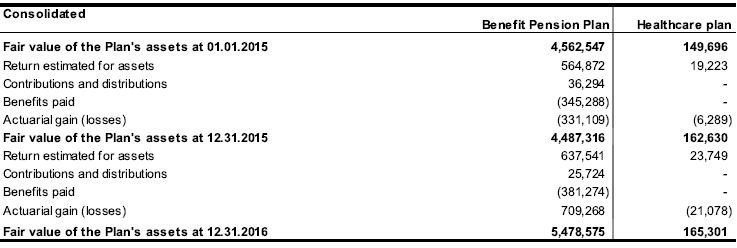
25.5.7 Estimated costs
The estimated net periodic plan costs (gains) for 2017 for each plan are shown below:

89
(CONVENIENCE TRANSLATION INTO ENGLISH FROM THE ORIGINAL PREVIOUSLY ISSUED IN PORTUGUESE)

25.5.8 Sensitivity analysis
The following tables feature a sensitivity analysis, which shows the effect of a one percent increase or decrease in the assumed rates of change in care costs, in the aggregate of the cost of service and cost of interest components of the net care costs and the accumulated post-employment benefit obligation.

25.5.9 Benefits payable
The estimated benefits to be paid by the Company and its subsidiaries in the next five years and the total benefits for the following fiscal years are shown below:

25.5.10 Asset allocation and investment strategy
The asset allocation for the Company and its subsidiaries pension and healthcare plans at the end of 2016 and the allocation goal for 2017, by asset category, are shown below:

Below are the limits set by the Fund management:
90
(CONVENIENCE TRANSLATION INTO ENGLISH FROM THE ORIGINAL PREVIOUSLY ISSUED IN PORTUGUESE)


As of December 31, 2016 and 2015, the pension plan assets included the following securities issued by Copel:

25.5.11 Additional information
The Company and its subsidiaries also sponsor a variable contribution plan for all its employees.
The contributions made in the years ended on December 31, 2016 and 2015 were R$75,679, and R$68,939,respectively.
26 Customer Charges Due

27 Research and Development and Energy Efficiency
In accordance with Law No. 9,991/2000, concessionaires and licensees of electric power generation and transmission are required to allocate annually the percentage of 1% of their net operating regulatory revenue to research and development of the electricity sector, and the electric power distribution concessionaires must segregate this same percentage into the research and development and energy efficiency programs of the electricity sector, according to ANEEL Normative Resolutions No. 504/2012 and 556/2013, and updated by Sub-module 5.6 - Research and Development - R&D and Energy Efficiency - EE Approved by RN ANEEL No. 737/2016.
91
(CONVENIENCE TRANSLATION INTO ENGLISH FROM THE ORIGINAL PREVIOUSLY ISSUED IN PORTUGUESE)

27.1 Balances recognized for investment in Research and Development (R&D) and the Energy Efficiency Program (EEP)
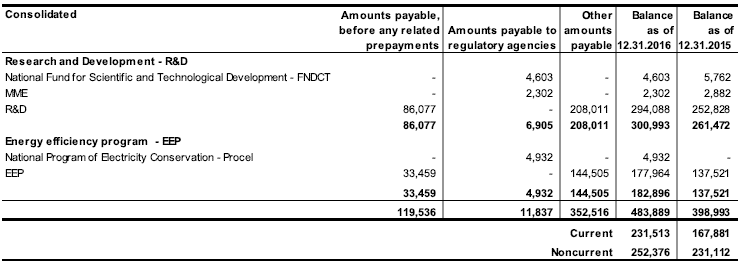
27.2 Changes in R&D and EEP balances
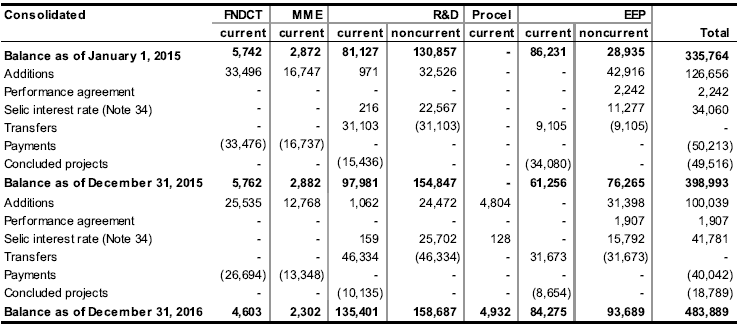
92
(CONVENIENCE TRANSLATION INTO ENGLISH FROM THE ORIGINAL PREVIOUSLY ISSUED IN PORTUGUESE)

28 Accounts payable related to concession
These refer to concession charges for use of public property (UPP).
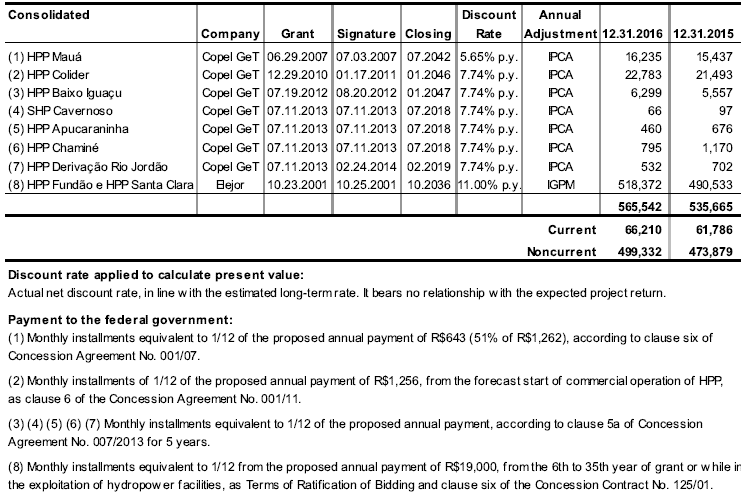
93
(CONVENIENCE TRANSLATION INTO ENGLISH FROM THE ORIGINAL PREVIOUSLY ISSUED IN PORTUGUESE)

28.1 Nominal value and present value of accounts payable related to concession

28.2 Changes in accounts payable related to concession
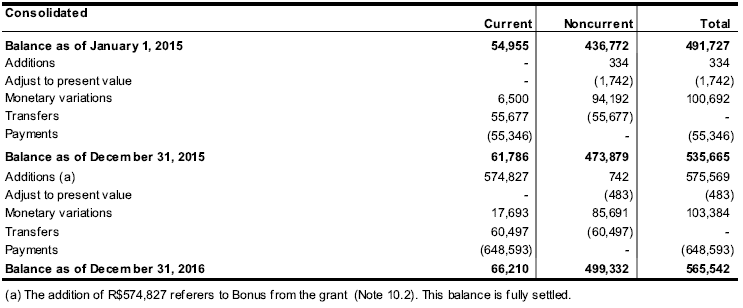
29 Other accounts payables

30 Provisions for legal claims
The Company and its subsidiaries are defendants in various judicial and administrative proceedings before different courts. Based on assessments made by the Company’s legal counsel, Management makes provisions for actions in which losses are rated probable, thus meeting the criteria for recognition of provisioning described in Note 4.9.
The Company’s management believes that, , at the time of preparation of financial statements, it is not practicable to provide information regarding the expected timing of any cash outflows resulting from these legal actions in which the Company and its subsidiaries are involved, due to the slow pace and unpredictability of Brazilian legal, tax and regulatory systems, and since final resolution of the proceedings for which a provision has been registered depends on the conclusions of court proceedings. Therefore, this information is not being provided.
94
(CONVENIENCE TRANSLATION INTO ENGLISH FROM THE ORIGINAL PREVIOUSLY ISSUED IN PORTUGUESE)

30.1 Provisions for litigation
30.1.1 Changes in provisions for litigation in actions rated as probable losses
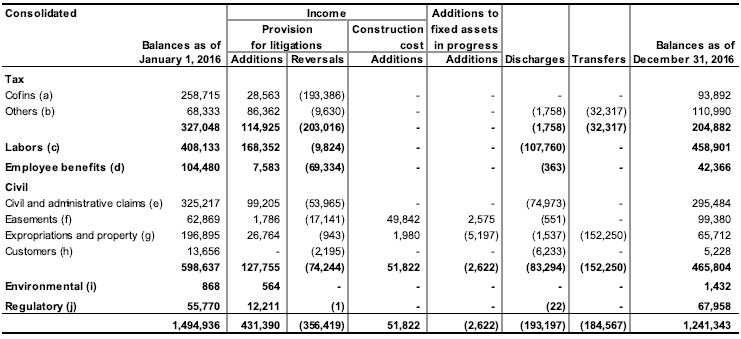
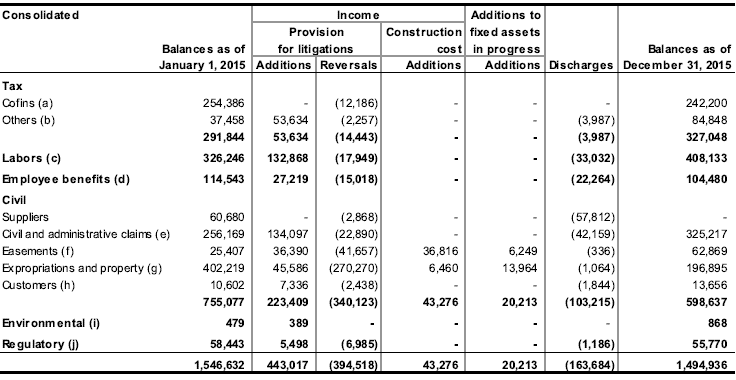
95
(CONVENIENCE TRANSLATION INTO ENGLISH FROM THE ORIGINAL PREVIOUSLY ISSUED IN PORTUGUESE)

30.1.2 Description of nature and/or details of the principal actions
a) Contribution for Social Security Funding (COFINS)
Plaintiff:Federal Tax Authority
Cofins payables and respective interest and fines from August 1995 to December 1996 due to the termination of a judicial decision that had recognized the Company’s exemption from Cofins.
Current status: awaiting judgment.
In the second quarter of 2016, Copel recorded a provision reversal of R$ 193,386, given that a final and unappealable decision was issued in favor of the Company on case 10980-720.458/2011-15, related to the period between October 1998 and June 2001, thus canceling the tax claim.
b) Other tax provisions
Actions relating to federal, state and municipal taxes, taxes, fees and other charges in which the Company challenges their applicability, calculation bases and amounts due to be collected. The principal action is described below:
96
(CONVENIENCE TRANSLATION INTO ENGLISH FROM THE ORIGINAL PREVIOUSLY ISSUED IN PORTUGUESE)

Defendant: Federal Tax Authority
By thecase5037809-14.2015.4.04.7000, Copel GeT required payment in installments of the balance owed on the annual adjustment of corporate income tax (IRPJ) and social contribution (CSLL) for the fiscal year 2014. The Federal Tax Authority consolidated the amount and applied the maximum fine. An injunction was filed in order to prevent the Tax Authority taking action that failed to obey the limit established in legislation, in Management’s opinion.
Current status:
A judgment rendered by the Federal Judge of the 4th Region dismissed the action and the Company filed an appeal against the decision.
On December 31, 2016, the amount of R$32,318 was transferred to Other Tax Liabilities.
c) Labor
Labor claims comprise claims filed by former employees in connection with the payment of overtime, hazardous working conditions, transfer bonuses, salary equality/reclassification, and other matters, and also claims by former employees of contractors and third parties (secondary responsibility) involving indemnity and other matters.
d) Employee benefits
Labor claims comprise claims filed by retired former employees of the Company and its subsidiaries against the Copel Foundation, which will have consequential impact on the Company and its wholly owned subsidiaries, since additional contributions will be required.
e) Civil and administrative claims
Lawsuits that discuss billings, irregular procedure, administrative contracts and contract fines, damages to compensate for electric grid and car accidents. The main lawsuits are as follows:
Plaintiff: Tradener Ltda. Estimated amount: R$105,010
Class actions and civil public actions were filed in which illegalities and annulments relating to the execution of the electric power purchase agreement entered into between the Company and Tradener are pointed out. Class action No. 588/2006 has already been rendered final and unappeasable, and the ruling recognized as valid commissions payable by the Company to Tradener. In the civil public action No. 0000219-78.2003.8.16.0004, filed by the Prosecution Office, a decision has also been rendered ruling on the absenceof irregularities in the electric power purchase agreement. Therefore, Tradener brought recovery lawsuits, seeking to receive its commissions.
97
(CONVENIENCE TRANSLATION INTO ENGLISH FROM THE ORIGINAL PREVIOUSLY ISSUED IN PORTUGUESE)

Current status:- case record 0005550-26.2012.8.16.0004 - The Company was ordered to pay the commission fees due to Tradener in a final and unappelable decision rendered on June 28, 2016. In compliance with judgment, on November 7, 2016, the Company settled the obligation, in the amount of R$57,116, resulting in the extinction of the proceeding.
- case record 0005990.22.2012.8.16.0004 - in the judgment rendered on January 27, 2014 the Company was ordered to pay the amount of R$105,010, which is the value updated by the (INPC/IBGE) from the maturity of the commissions payable to Tradener under the purchase agreement entered into with Celesc, plus default interest of 1% per month, as of the date of notification (October 31, 2012), as well as attorneys’ fees. The Company filed an appeal against this decision,however, on 11.08.2016, by majority votes, the Court dismissed the appeal. From this decision, Copel filed an appeal which is pending judgment.
f) Easements
Lawsuits are filed when there is a difference between the amount determined by Copel for payment and the amount claimed by the owner and/or when the owner's paper title may not be registered (probate proceedings are underway, properties have no registry number, etc.).
They may also involve third-party interventions for adverse possession, whether from owners or occupants of contiguous properties or even in cases of properties where right of way easements are required to preserve limits and boundaries of these areas.
g) Expropriations and property
Lawsuits are filed challenging expropriation when there is a difference between the amount determined by Copel for payment and the amount claimed by the owner and/or when the owner's paper title may not be registered (probate proceedings are underway, properties have no registry number etc).
Possessory cases actions include those for repossession of property owned by the concessionaire. Litigation arises when there is a need to repossess properties invaded or occupied by third parties in areas owned by the Company. Cases may also arise from intervention in third-party adverse possession, or owners or occupants of contiguous properties or even in cases of properties to preserve limits and boundaries of expropriated areas. The principal action is described below:
Plaintiff: Ivaí Engenharia de Obras S.A.
Declaratory action brought by the plaintiff in order to recognize the right to economic and financial rebalancing of the contract signed with Copel GeT, followed by an action for relief from judgment filed by Copel to vacate the final and unappealable decision in the declaratory judgment action, followed by a collection suit filed by the plaintiff to collect the amounts arising from the economic and financial rebalance of the agreement and followed by compliance with the provisional decision proposed by the plaintiff.
98
(CONVENIENCE TRANSLATION INTO ENGLISH FROM THE ORIGINAL PREVIOUSLY ISSUED IN PORTUGUESE)

Current status: A final and unappealable decision has been issued on the declaratory action and on the action for relief from judgment, sentencing Copel to pay attorneys’ fees and court costs. The amounts deriving from the right to the economic and financial rebalancing of the contract involved in the unappealable decision issued on the declaratory action are the object of a collection lawsuit under appeal in the Superior Court of Justice (STJ), which are also object of compliance of provisional sentence started by the opposing party, pending at the trial court. On October 21, 2016, Copel signed an agreement, previously approved by the Board of Directors, whereby it undertook to pay to Ivaí Engenharia R$152,250, in 15 monthly and consecutive installments of R$10,150 - the first installment maturing by the fifth business day after signature of the transaction agreement and the 14 remaining installments on the 15th of each immediately subsequent months, considering that the base amount of the second installment, as well as the subsequent ones, will be adjusted for inflation, as of the signature of the agreement, at 50% of the last IPCA index disclosed until the maturity date of each installment. The agreement comprises the discussions between the parties on the economic and financial balance of the agreement and suspends the ongoing collection suits, under appeal in the STJ, and compliance with provisional sentence, until the payment of all the installments of the agreement, when the abovementioned lawsuits will be dismissed. On September 30, 2016, R$152,250 was transferred to Other accounts payable (Note 29).
h) Consumers
Lawsuits seeking compensation for damages caused by household appliances, lawsuits claiming damages for pain and suffering caused by service interruption and lawsuits filed by industrial consumers challenging the lawfulness of the increase in electricity prices while Plano Cruzado (anti-inflation plan) was in effect and claiming reimbursement for the amounts paid by the Company.
i) Environmental
Class actions whose purpose is to obstruct the progress of environmental licensing for new projects or to recover permanent preservation areas located around the hydroelectric power plant dams unlawfully used by private individuals. If the outcome of the lawsuits is unfavorable to the Company, management estimates only the cost to prepare new environmental studies and to recover the areas owned by Copel GeT.
They also contemplate the “Termos de Ajuste de Conduta –TAC”, which refers to the commitments agreed upon and approved between the Company and the competent bodies for noncompliance with any condition contained in the Installation and Operation Licenses. As they are considered liabilities, these amounts are recorded as "obligations" in current and non-current liabilities and the counterparts in property, plant and equipment (construction cost).
j) Regulatory
The Company is challenging, both at the administrative and judicial levels, notifications issued by the Regulatory Agency of alleged violations against regulations.The mainlawsuitare as follows:
99
(CONVENIENCE TRANSLATION INTO ENGLISH FROM THE ORIGINAL PREVIOUSLY ISSUED IN PORTUGUESE)

Plaintiffs: Companhia Estadual de Energia Elétrica - CEEE and Dona Francisca Energética S.A.
Estimated amount: R$49,655
Copel, Copel Geração e Transmissão and Copel Distribuição are challenging lawsuits filed against ANEEL's decision No. 288/2002 involving the companies that have been mentioned.
Current status: awaiting judgment.
30.2 Contingent liabilities
30.2.1 Classification of actions rated as possible losses
Contingent liabilities are present obligations arising from past events for which no provisions are recognized because it is probable that an outflow of resources embodying economic benefits will be required to settle the obligation. The following information concerns the nature of the Company’s contingent liabilities and potential losses arising thereof.

30.2.2 Description of nature and/or details of the principal actions
a) Tax
Actions relating to federal, state and municipal taxes, taxes, fees and other charges in which the Company challenges their applicability, calculation bases and amounts due to be collected. The principal actions are described below:
Plaintiff: Federal Tax Authority
In the second quarter, Copel reduced the estimated of this item by R$635,797, given the final and unappealable decision issued in favor of the Company on case 10980-720.458/2011-15 (relating to the Cofins from October 1998 to June 2001), canceling this tax claim.
In the fourth quarter, a final and unapeallable decision favorable to the Compnay was rendered on case 11453.720.001/2011-23 (referring to most of the interest charged for Cofins from August 1995 to December 1996), allowing the cancelation of this tax requirement, estimated at that time at approximately R$153,000.
Current status:case closed.
Plaintiff: Social Security National Institute (INSS) Estimated amount: R$307,450
100
(CONVENIENCE TRANSLATION INTO ENGLISH FROM THE ORIGINAL PREVIOUSLY ISSUED IN PORTUGUESE)

Tax claims against Copel related to social security contribution on assignment of manpower (NFLD 35.273.870-7); it is worth emphasizing that the case has already been judged favorably to the Company at two court levels.
Current status: awaiting judgment.
Plaintiff: Social Security National Institute (INSS) Estimated amount: R$27,044
Tax collections against Copel consisting of social security contribution imposed on the assignment of labor (NFLD - 35.273.876-6). The case has been at Carf (Brazilian Administrative Tax Court) for judgment since 2010. The assessment of risk as possible is due to the existence of several legal arguments to defend the Company, particularly (a) the fact that no services were provided and no labor was assigned and (b) the fact that service providers classified into the Simples (lower taxation) category are not required to withhold that contribution.
Current status: awaiting judgment.
Plaintiff: State Tax Authority (SEFA) Estimated amount: R$62,139
Copel DIS received tax deficiency notice 6587156-4 from the State of Paraná for allegedly failing to pay ICMS (VAT) tax on the ‘metered demand’ line in the electricity bills issued to a major consumer between May 2011 and December 2013.
Copel DIS claims lack of standing in regard to this tax deficiency notice, given that it derives from Declaratory Action No. 33,036, currently pending judgement by the 3rd Public Treasury Court of Curitiba, filed by a major consumer in the State of Paraná, which was held valid and considered that ICMS tax should be levied on metered demand only. Note that this sentence was subsequently overturned by the Paraná State Court of Justice (TJ/PR), through Civil Appeal 822.670-2, given the major consumer’s lack of standing to question the levy of ICMS on contracted demand.
The Company believes that, since it was not involved in the lawsuit, it is not subject to the effects from the respective court ruling, which would imply its lack of standing in tax deficiency notice 6.587.156-4.
b) Labor
Labor claims comprise claims filed by Copel employees and former employees in connection with the payment of overtime, hazardous working conditions, transfer bonuses, salary equality/reclassification, and other matters, and also claims by former employees of contractors and third-parties (secondary responsibility) involving indemnity and other matters.
c) Employee benefits
Labor claims comprise claims filed by retired former employees of the Company and its wholly owned subsidiaries against the Copel Foundation, which will have consequential impact on the Company and its wholly owned subsidiaries, since additional contributions will be required.
101
(CONVENIENCE TRANSLATION INTO ENGLISH FROM THE ORIGINAL PREVIOUSLY ISSUED IN PORTUGUESE)

d) Civil
Actions involving billing, irregular procedure, administrative contracts and contractual penalties, compensation for accidents involving electric power grid or vehicles. The principal actions are described below:
Plaintiff: Mineradora Tibagiana Ltda. Estimated amount: R$143,354
Action claiming compensation for alleged losses when this mining company was involved in the construction of the Mauá plant by the Energético Cruzeiro do Sul consortium in which Copel GeT has a 51% stake. The action challenges the validity of the mining permit granted Tibagiana for the Mauá job site and the indemnifying effects arising thereof.
Current status: Action suspended in lower court until the conclusion of action No 5013943-50.2010.04.7000 pending before the 6th Federal Court of Curitiba.
Plaintiff: Ivaí Engenharia de Obras S.A.
Action for collection brought by the plaintiff in order to collect amounts arising from economic and financial rebalancing of the contract signed with Copel GeT, recognized in the declaratory action.
Current status: the judgment of the 2nd motion for clarification filed by Copel GeT before the Superior Court of Justice (STJ) was published on December 18, 2015, challenging the difference in amounts due arising from cumulative updating of the amount of plaintiff’s credit at the SELIC interest rate as against other interest rates in the period preceding the court’s expert report (October 2005). The judgment prescribes the case’s return to the State of Paraná Court of Justice (TJ-PR) for the latter to render a new judgment on the motion for clarification brought by Copel GeT, thus righting the omission of the previous trial. Ivaí has filed a motion for clarification on February 5, 2016, which is now pending judgment by the Superior Court of Justice (STJ). Therefore the amount to be assessed as probable loss is the amount of the plaintiff’s receivable adjusted on a monthly basis using the TJ-PR’s official price index, which is the average of the IGP-DI/INPC indices, as sought by Copel GeT in court, plus late payment penalties at 1% per month, plus burden of defeat. However, it is still considered as a possible loss, with reversal of the TJ-PR’s previous judgment, that is, the amount of debt will be adjusted according to the SELIC interest rate cumulative with other interest rates in the period preceding the court’s expert report. At the same time, a provisional execution of the total credit amount sought by Ivaí is currently taking place. As described in Note 30.1.2, the parties entered into an agreement, that comprises the discussions between the parties on the economic and financial balance of the agreement and suspends the ongoing collection suits, under appeal in the STJ, and compliance with provisional sentence, until the payment of all the installments of the agreement, when the abovementioned lawsuits will be dismissed.
Plaintiffs:franchises of the Agency / Copel store Estimated amount: R$48,924
102
(CONVENIENCE TRANSLATION INTO ENGLISH FROM THE ORIGINAL PREVIOUSLY ISSUED IN PORTUGUESE)

Filing of two individual claims against Copel Distribuição of the franchise contracts for Copel branches/stores, with the main petition claiming an extension of the term of the contract and secondary petition to recognize the existence of a sub concession, with transfer of the services provided and full pass-through of the fees, amongst other amounts,currently have appeals awaiting trial.
Current status: awaiting judgment.
e) Regulatory
The Company is challenging, both at the administrative and judicial levels, notifications issued by the Regulatory Agency of alleged violations against regulations.The mainlawsuitsare as follows:
Plaintiff: ANEEL Estimated amount: R$17,007
Copel DIS filed an appeal against a decision by ANEEL's Director-General under Resolution No. 3,959 from 12.08.2015 imposing an inefficiency penalty on Copel Distribuição due to over-contracting for use of the distribution system (MUSD) with the National Power Network Operator (ONS).
Current status: awaiting judgment.
Plaintiff: Energia Sustentável do Brasil S.A. - ESBR Estimated amount: R$721,060
The primary matter at issue is the exclusion of distribution utilities from liability for damages resulting from schedule overruns in the construction of the Jirau hydropower station. ESBR brought Ordinary Action No. 10426-71.2013.4.01.4100 against Aneel in the federal courts of Rondônia, the decision on which: (i) excludes liability for the 535-day schedule overrun in the construction of the Jirau Hydropower Station; (ii) declares any obligations, penalties and costs imposed on ESBR as a result of the schedule overrun to be unenforceable, and (iii) annuls ANEEL Resolution No. 1,732/2013, which recognized a schedule overrun of only 52 days. An appeal has been brought by ANEEL, n progress at the TRF of the 1st Region.
The practical outcome of the decision is that, by exempting ESBR, it exposed the distribution utilities with which it had concluded regulated power trading contracts (CCEARs) – including Copel Distribuição – to the spot market and spot prices during the period. The reason is that electricity trading rules require that all electricity consumed be covered by a contract.
One of the measures adopted was the filing for writ of mandamus 1001675-88.2015.4.01.0000 submitted to the Regional Federal Court of the 1st Region by the Brazilian Association of Electricity Distributors (Abradee), of which Copel DIS is a member, seeking to annul the case brought by ESBR against ANEEL since service of process. Although a favorable preliminary injunction was obtained, there was an unfavorable judgment of the writ of mandamus, stating that it was not applicable in this case. After the publication of the judgement, Abradee filed an ordinary appeal, currently being judged by the Regional Federal Court of the 1st Region.
103
(CONVENIENCE TRANSLATION INTO ENGLISH FROM THE ORIGINAL PREVIOUSLY ISSUED IN PORTUGUESE)

However, ANEEL´s motion to stay execution 0050083-30.2015.4.01.0000/RO was partly accepted on November 30, 2015 by the presiding judge of the Regional Federal Court of the 1st Region, which upheld the CCEE Board of Directors’ resolution voted at meeting 813 on July 21, 2015, based on the court’s decision in the case of Action for a Provisional Remedy 9500-90.2013.4.01.4100, determining the “obligation to deliver 70% of the physical guarantee provided by the effective start-up of commercial operations by Jirau HPP generators until this amount is equivalent to the original delivery obligation.” An appeal brought by ESBR was rejected. This decision is also subject to appeal.
The risk of loss in this case is rated ‘possible’ (intermediate), considering the amount of R$721,060, on December 31, 2016. If the actions are judged unfavorably, the amount will be classified as Sectorial Financial Asset to be recovered through tariff rates.
Current status: awaiting judgment.
104
(CONVENIENCE TRANSLATION INTO ENGLISH FROM THE ORIGINAL PREVIOUSLY ISSUED IN PORTUGUESE)

31 Equity
31.1 Attributable to Parent Company’s shareholders
31.1.1 Capital
Capital consists of common and preferred shares. Each common share entitles its holder to one vote in the general shareholders’ meetings. Preferred shares do not have voting rights and have two classes “A” and “B”.
According to Article 17 and following paragraphs of Federal Law No. 6,404/76, dividends paid to preferred shares must be at least 10% higher than those paid on common shares.
Class “A” preferred shares have priority in the reimbursement of capital and in the distribution of minimum dividends of 10% p.y. (non-cumulative), calculated based on the capital represented by this class of shares.
Class “B” preferred shares have priority in the reimbursement of capital and the right to the distribution of dividends, calculated as 25% of adjusted net income, pursuant to the corporate legislation and to the Company’s by-laws, calculated proportionately to the capital represented by the shares of this class. Dividends for Class “B” have priority only over the common shares and are only paid out of the remaining profits, following payment of priority dividends of class “A” shares.
On December 15, 2016, the Extraordinary General Meeting approved a capital increase in the amount of R$1,000,000, using the profit retention reserve.
The paid-in share capital is R$7,910,000. The different classes of shares (with no par value) and main shareholders are detailed below:
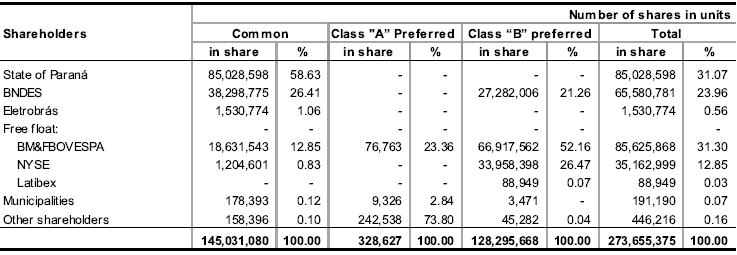
105
(CONVENIENCE TRANSLATION INTO ENGLISH FROM THE ORIGINAL PREVIOUSLY ISSUED IN PORTUGUESE)

31.1.2 Equity value adjustments
Fair values of fixed assets – deemed costs – were recognized on the first-time adoption of IFRS. The account “Equity value adjustments” was the balancing item of this adjustment, net of deferred income tax and social contribution, including under the equity method. The realization of such adjustments is recorded in the retained earnings account, to the extent of the depreciation or possible write-off of the valued items.
Adjustments arising from the changes in fair value involving financial assets available for sale, as well as actuarial gains and losses, are also recorded in this account.
Changes in equity value adjustments
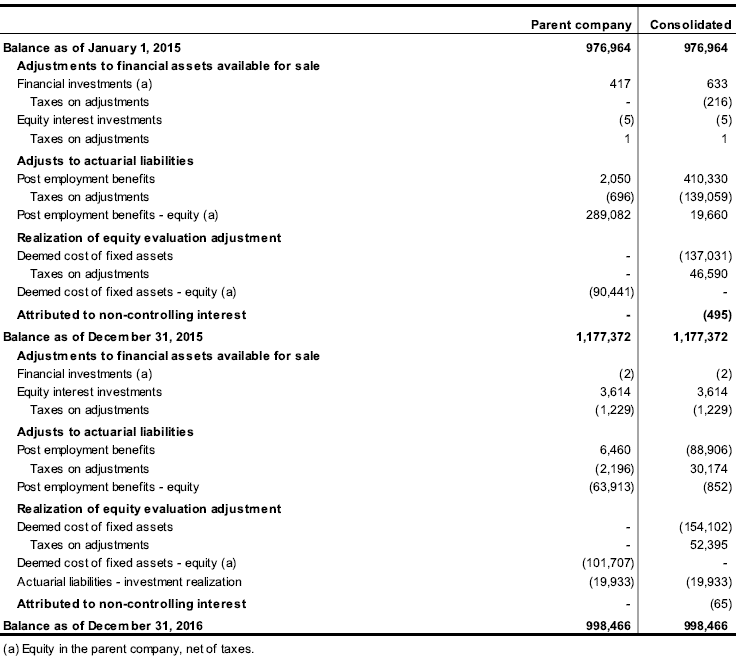
106
(CONVENIENCE TRANSLATION INTO ENGLISH FROM THE ORIGINAL PREVIOUSLY ISSUED IN PORTUGUESE)

31.1.3 Legal reserve and profit retention reserve
5% of the net income for the year is allocated to the legal reserve, before any other allocation, limited to 20% of capital.
The profit retention reserve is designed to cover the Company's investment program, according to Article 196 of Law No. 6,404/1976. It is funded by retaining any remaining net profit after legal reserve, interest on capital and dividends.
31.1.4 Proposed dividend distribution
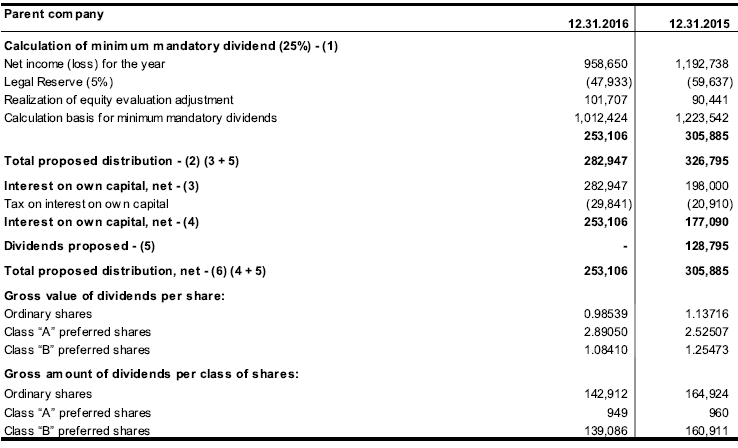
In accordance with legal and statutory requirements in effect, the basis for calculating the minimum mandatory dividends is obtained from the net income for the year, less the portion that will fund the legal reserve. However, Management decided to include in this basis the amount related to the realization of the equity value adjustments, specifically to compensate the effects coming from the increase of the depreciation expense arriving from the adoption of the new accounting standards. This procedure reflects the policy to distribute dividends to Company’s shareholders, which will be effective during the realization of the entire asset/liability valuation adjustments account.
The distribution of the minimum mandatory dividend is recognized as a liability in the Company’s and its subsidiaries financial statements at year-end.
The tax benefit of interest on capital is recorded in the statement of income in the moment of its recognition in accounts payable.
107
(CONVENIENCE TRANSLATION INTO ENGLISH FROM THE ORIGINAL PREVIOUSLY ISSUED IN PORTUGUESE)

31.1.5 Earnings per share - basic and diluted
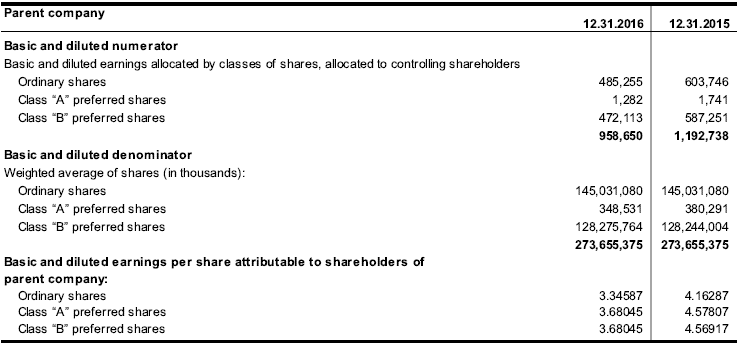
The earnings or loss per share are calculated based on the weighted average number of shares outstanding during the reporting period. For all periods presented, the Company has no potential instrument that could have a dilutive effect, therefore, basic earnings per share is equivalent to diluted earnings per share.
Since the preferred and common shareholders have rights to dividends, voting and different settlements, basic and diluted earnings per share were calculated using the “two-class” method. The two-class method is a formula for allocation of earnings which determines earnings per preferred share and per common share according to the declared dividends, pursuant to the Company’s by-laws and to the rights to participation in non-distributed earnings calculated in accordance with the right to dividends of each share type.
32 Net Operating Revenue

108
(CONVENIENCE TRANSLATION INTO ENGLISH FROM THE ORIGINAL PREVIOUSLY ISSUED IN PORTUGUESE)


32.1 Electric sales to final customers by category

32.2 Electricity sales to distributors

109
(CONVENIENCE TRANSLATION INTO ENGLISH FROM THE ORIGINAL PREVIOUSLY ISSUED IN PORTUGUESE)

32.3 Use of the main distribution and transmission grid by customer class

32.4 Other operating revenues

32.4.1 Revenues from leases and rentals

32.5 Regulatory charges

110
(CONVENIENCE TRANSLATION INTO ENGLISH FROM THE ORIGINAL PREVIOUSLY ISSUED IN PORTUGUESE)

32.5.1 Energy Development Account - CDE
The primary objectives of the Energy Development Account (CDE) created by Law No. 10,438/2002 are: (i) universalization; (ii) subsidy to the low income residential subclass; (iii) Fuel Consumption Account - CCC; (iv) amortization of financial operations related to the reversal of assets at the end of the concessions; (v) competitiveness of energy produced from wind power, small hydroelectric plants, biomass, natural gas and coal. CDE’s quotas were originally defined based on the CCC figures for the 2001 Interconnected Systems, the values of which were adjusted annually starting in 2002 in proportion to the market growth of each agent, and in 2004 also by the IPCA. As of Law 12,783/2013, the system is changed and quotas are defined based on the resources needed to achieve its purposes and other revenues related to the CDE. The CDE charge incorporates:
a) annual quota of “CDE-Uso”: this quota is allocated to the financing of the objectives of the CDE, set forth in its annual budget, defined by the Federal Government, as provided in §§ 2 and 3 of art. 13 of Law 10,438/2002, with wording given by Law No. 12,783/2013.
ANEEL Resolution No. 2,018/2016 defined the CDE-Uso quota, in the monthly amount of R$83,727 as of January 2016. However, as of June of the same year, the monthly amount of the quota was changed to R$71,600, established by ANEEL Resolution No. 2,077/2016;
b) annual quota of “CDE-Energia (ACR Account)”: This quota is intended for the discharge of credit operations contracted by CCEE in the management of the Regulated Contracting Environment - ACR Account, in compliance with Decree No. 8,222/2014, and pursuant to Normative Resolution No. 612/2014.
The purpose of the ACR Account is to cover costs relating to involuntary spot market exposure and the costs of thermal power dispatching in 2014.
Resolution No. 1,863/2015 defined the value of the CDE quota (ACR Account) at R$46,638, as of June 2015. Beginning June 2016, by means of Resolution No. 2004/2015, the amount of the quota was updated to R$49,362. As of 12.31.2016, there are 36 installments to be paid. These installments are updated annually, based on the tariff process of each distributor, in accordance with the conditions contracted by CCEE for each of the loans made to the participating financial institutions; and
c) annual quota of “CDE-Energia”: This quota is destined to the return of the resources received by the distribution concessionaires, from January 2013 to January 2014, to cover costs relating to involuntary spot market exposure and the hydrological risk of the plants contracted on a regime of quotas, and the costs of thermal power dispatching for reasons of energy security, in compliance with Decrees 7,895/2013 and Decree 8,203/2014.
ANEEL Resolution No. 1,857/2015 defined the CDE-Energia quota, in the monthly amount of R$17,120. As of June 2016, the monthly amount of the quota was changed to R$18,947, established by ANEEL Resolution No. 2,077/2016.
111
(CONVENIENCE TRANSLATION INTO ENGLISH FROM THE ORIGINAL PREVIOUSLY ISSUED IN PORTUGUESE)

Preliminary injunction Abrace and Anace
As a result of preliminary injunctions in favor of the Brazilian Association of Large Industrial Consumers and Free Consumers - Abrace, and of the National Association of Energy Consumers - Anace and other associates, which challenge at court the tariff components of CDE-Uso and CDE-Energia, ANEEL, through Resolutions 1,967/2015, 1,986/2015 and 2,083/2016, ratified the tariff calculation deducting these charges from associates of those entities, as long as the preliminary injunctions granted in Judicial Proceedings No. 24648-39.2015.4.01.3400 and No. 0069262-32.2015.4.01.3400 / 16th Federal Court are in effect.
On the other hand, by the preliminary injunction in favor of Abradee, the associated distributors are guaranteed the right of non-transfer, deducting from the portion of CDE-Uso and CDE-Energia the amounts not collected due to the effects of the preliminary injunction. This deduction, which covers all preliminary injunctions, was approved by Aneel by Order No. 1,576, dated 06.14.2016.
Recently, in compliance with the preliminary injunction granted in the Judicial Proceedings No. 0028882-30.2016.4.01.3400 of the 2nd Federal Court, ANEEL, through Order No. 2,634, dated 09.30.2016, ratified, regarding the 2016 tariff process, new Tariffs for Use of Distribution Systems - Tusd for Abrace members, effective as of 06.29.2016, for as long as the effects of the preliminary injunction relief remain.
Based on the December 2016 figures, there are currently 96 consumer units benefiting from the preliminary injunction. Accordingly, the Company has been carrying out, during the year, the deduction of the payment of the CDE quota from the unbilled amounts resulting from these injunctions, thus not impacting the distributor’s result.
The differences between the rate coverage for this charge and the amount actually paid, from the beginning of the preliminary injunction to December 2016, represent the amount of R$79,364 for CDE Uso and R$6,414 for CDE Energy.
32.6 Copel DIS periodic tariff review
Aneel’s Resolution No. 2,096 of June 21, 2016 approved the result of Copel DIS fourth Periodic Tariff Review and authorized a -12.87% average adjustment to be perceived by consumers, consisting of: -1.73% related to the inclusion of financial components; 4.48% from updating Portion B; -2.57% from adjusting Portion A; and -13.05% reflecting the withdrawal of the financial components from the previous tariff process.
This adjustment was fully applied to Copel DIS tariffs as of June 24, 2016.
In the Periodic Tariff Review process, which up to the 4th Cycle was carried out for four years, ANEEL redefined the costs that make up the so-called Portion B, that is, the operating and capital costs, which are depreciation and return on investments. In order to do so, the changes in the cost and market structure of the concessionaire, the tariff levels observed in similar companies, the incentives for efficiency and the modality of tariffs are taken into account.
112
(CONVENIENCE TRANSLATION INTO ENGLISH FROM THE ORIGINAL PREVIOUSLY ISSUED IN PORTUGUESE)

The Tariff Review process also involves updating the costs that make up Portion A, that is, the costs related to the acquisition of energy, the use of transmission systems and the sector charges.
Regulatory Remuneration Base (BRR)
The BRR corresponds to the amount of investments made by the distributors in the provision of services that will be covered by the tariffs charged by consumers. These assets related to the electric energy public service distribution concession agreement are only eligible to compose the Regulatory Remuneration Base when effectively used in the granted activity.
According to ANEEL’s Proret, for the evaluation of the electric power distribution companies’ assets, the remuneration base in the current RTP Cycle is calculated considering the remuneration base approved in the previous Cycle (“armored” base), approved by the appraisal report (associated to the existing assets, in operation, except for the changes occurred in the period), plus the values of the inclusions occurred between the previous and current RTP base dates (incremental basis).
In the 4th Tariff Review Cycle, Copel DIS achieved net BRR of R$4,920,381 and remuneration of capital of R$595,326.
33 Operating Costs and Expenses
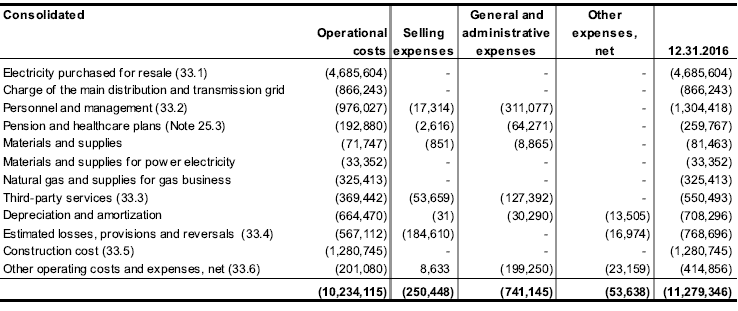
113
(CONVENIENCE TRANSLATION INTO ENGLISH FROM THE ORIGINAL PREVIOUSLY ISSUED IN PORTUGUESE)

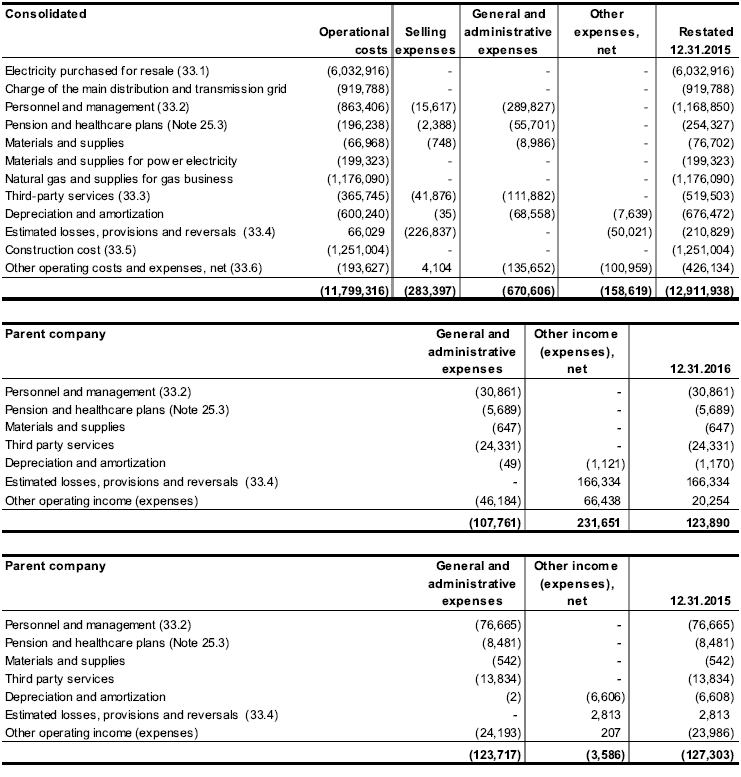
114
(CONVENIENCE TRANSLATION INTO ENGLISH FROM THE ORIGINAL PREVIOUSLY ISSUED IN PORTUGUESE)

33.1 Electricity purchased for resale

33.2 Personnel and management

33.3 Third-party services

115
(CONVENIENCE TRANSLATION INTO ENGLISH FROM THE ORIGINAL PREVIOUSLY ISSUED IN PORTUGUESE)

33.4 Estimated losses, provisions and reversals

33.5 Construction cost

33.6 Other operating costs and expenses, net

33.6.1 Leasing and rents

116
(CONVENIENCE TRANSLATION INTO ENGLISH FROM THE ORIGINAL PREVIOUSLY ISSUED IN PORTUGUESE)

34 Financial Results
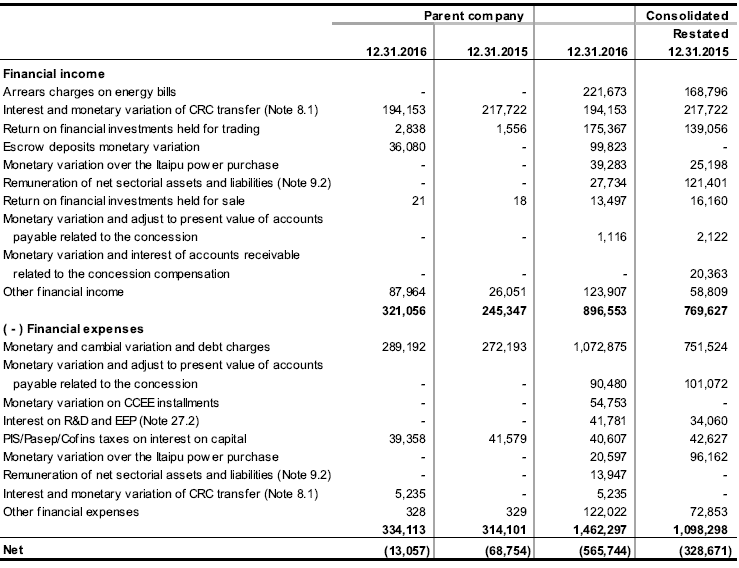
35 Operating Segments
Operating segments are business activities that generate revenues and incur expenses, whose operating results are regularly reviewed by the executive boards of the Parent Company and subsidiaries and by key strategic decision makers responsible for allocating funds and assessing performance.
35.1 Products and services from which we generate revenues from the reportable segments
The Company operates in five reportable segments identified by management, through the Chief Executive Office and the chief offices of each business area, taking into consideration the regulatory environments, the strategic business units, and the different products and services. These segments are managed separately, since each business and each company requires different technologies and strategies.
117
(CONVENIENCE TRANSLATION INTO ENGLISH FROM THE ORIGINAL PREVIOUSLY ISSUED IN PORTUGUESE)

In 2016 and 2015, all sales have been to customers within Brazilian territory, as well as all non-current assets are located in national territory.
The Company and its subsidiaries do not identified any customer who individually accounts for more than 10% of total net revenues in the year 2016.
The Company evaluates the performance of each segment based on information derived from accounting records.
The accounting policies of the operating segments are the same as those described in the summary of significant accounting policies and transactions between segments are recognized as transactions with third parties, i.e. at current market prices.
35.2 The Company’s reportable segments
The reportable segments of the Company, in accordance with CPC 22 / IFRS 8, are:
Power generation and transmission (GET) - this segment comprises the generation of electric energy from hydraulic, wind, and thermal projects (GER) and the transport and transformation of the power generated by the Company, and the construction, operation, and maintenance of all power transmission substations and lines(TRA). For managers, the assets and liabilities of the generation and transmission segments are shown on an aggregate basis while their result is shown separately;
Power distribution and sales (DIS) -this segment comprises the distribution and sale of electric energy, the operation and maintenance of the distribution infrastructure, and related services.
Telecommunications (TEL) -this segment comprises telecommunications and general communications services.
GAS- this segment comprises the public service of piped natural gas distribution.
Holding Company (HOL) - this segment comprises participation in other companies.
35.3 Assets per reportable segment

118
(CONVENIENCE TRANSLATION INTO ENGLISH FROM THE ORIGINAL PREVIOUSLY ISSUED IN PORTUGUESE)


35.4 Statement of income per reportable segment
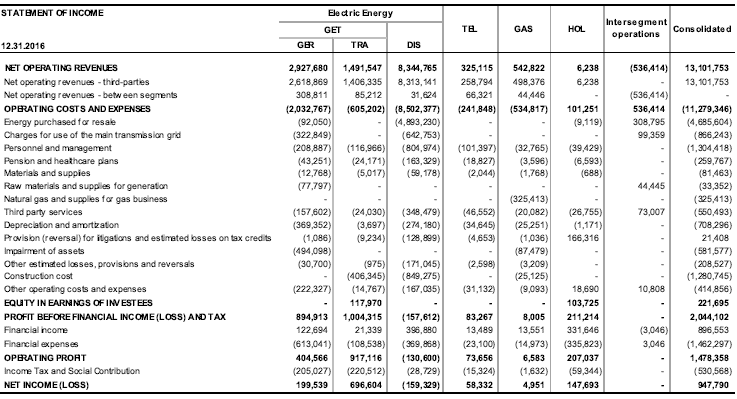
119
(CONVENIENCE TRANSLATION INTO ENGLISH FROM THE ORIGINAL PREVIOUSLY ISSUED IN PORTUGUESE)


35.5 Additions to noncurrent assets by reportable segment

120
(CONVENIENCE TRANSLATION INTO ENGLISH FROM THE ORIGINAL PREVIOUSLY ISSUED IN PORTUGUESE)

36 Financial instruments
36.1 Categories and determination of fair value of financial instruments
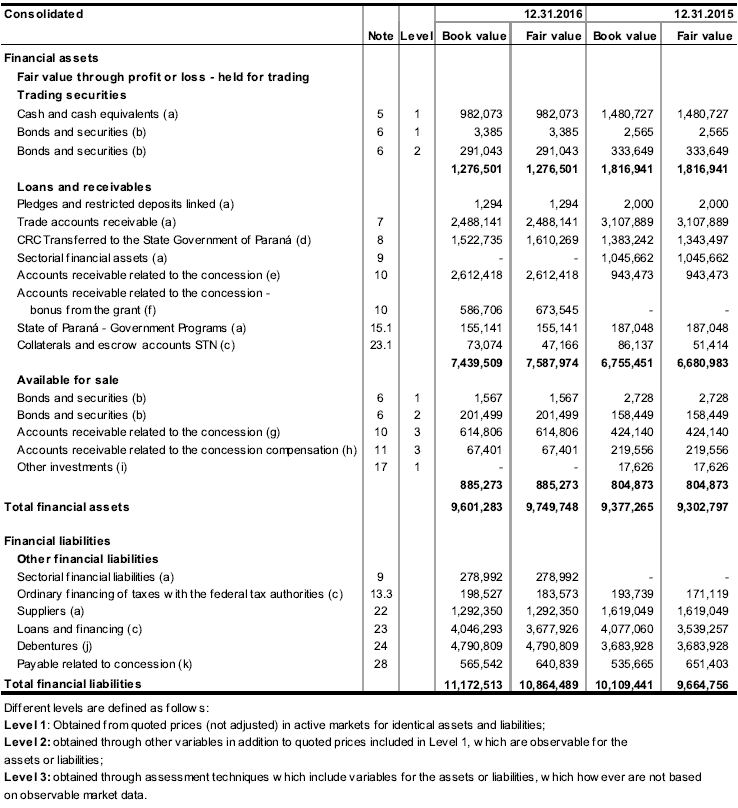
Determining fair values
a) Equivalent to their respective carrying values due to their nature and terms of realization.
121
(CONVENIENCE TRANSLATION INTO ENGLISH FROM THE ORIGINAL PREVIOUSLY ISSUED IN PORTUGUESE)

b) Calculated according to information made available by the financial agents and to the market values of the bonds issued by the Brazilian government.
c) Calculated based on the cost of the last issue by the Company, 124% of the CDI for discount of the expected payment flow.
d) The Company based its calculation on the comparison with a noncurrent, long-term and post-fixed National Treasury bond (NTN-B) maturing on August 15, 2024, which yields approximately 5.24% p.y. plus the IPCA inflation index.
e) Criteria and assumptions disclosed on note 4.4.9, transmission concession.
f) Receivables related to the concession agreement for providing electricity generation services under quota arrangements at their fair value calculated by expected cash inflows discounted at the rate established in Aneel auction notice 12/2015 (9.04%), the best market benchmark in this case.
g) Criteria and assumptions disclosed on note 4.4.9, distribution concession. The changes held in 2015 are as note 10.1.
h) The fair values of generation assets approximate their book values, according to Note 11.
i) Calculated from price quotations published on active markets.
j) Calculated from the Unit Price quotation (PU) for December 30, 2016, obtained from the Brazilian Association of Financial and Capital Markets (Anbima), net of financial cost to amortize.
k) Real net discount rate of 8.63% p.a., in line with the Company’s estimated rate for long-term projects
36.2 Financial risk management
The Company has a Corporate Risk Management Committee in charge of formulating and tracking risk management policies and assisting the Audit Committee to ensure a good management of resources and the protection and appreciation of its assets.
The Company's business activities are exposed to the following risks arising from financial instruments:
36.2.1 Credit risk
Credit risk is the risk of the Company and its subsidiaries incurring losses due to a customer or financial instrument counterparty, resulting from failure in complying with contract obligations.
122
(CONVENIENCE TRANSLATION INTO ENGLISH FROM THE ORIGINAL PREVIOUSLY ISSUED IN PORTUGUESE)

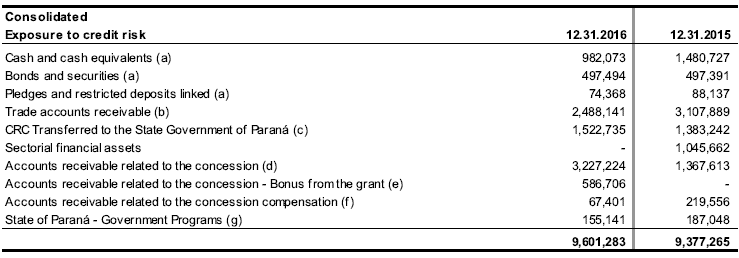
a) Company management manages the credit risk of its assets in accordance with the Group's policy of investing virtually all of its funds in federal banking institutions. As a result of legal and/or regulatory requirements, in exceptional circumstances the Company may invest funds in prime private banks.
b) The risk arises from the possibility that the Company might incur in losses resulting from difficulties to receive its billings to customers. This risk is closely related to internal and external factors of Copel. To mitigate this type of risk the Company manages its accounts receivable, detecting customer groups that pose the greatest risk of default, cutting off energy supplies and implementing specific collection policies, supported by real or personal guarantees for debits above R$200.
c) Management believes this credit risk is low because repayments are secured by funds from dividends.
d) Management believes this risk is very low because these contracts assure an unconditional right to be paid in cash by the concession Granting Authority at the end of the concession period for any infrastructure investments not recovered through tariffs by the end of the period, specifically for the transmission business, since RAP is guaranteed revenue that does not involve demand risk.
For the amount relating to RBSE assets existing on May 31, 2000, Aneel published Normative Resolution 589/2013, which defines criteria for calculating New Replacement Value (VNR). Given that on April 20, 2016, the Granting Authority defined the means and period for receiving this asset (still to be regulated by Aneel) through MME Ordinance 120, Management believes credit risk is low.
e) Management considers the risk of this credit to be very low, as the contract for the sale of energy by quotas guarantees the receipt of an Annual Generation Revenue - RAG guaranteed which includes the annual amortization of this amount during the concession term.
f) For the generation concession assets, Aneel published Normative Resolution No. 596/2013, which defines criteria for calculating New Replacement Value (VNR), for indemnity purposes. Although the Granting Authority has not yet disclosed the means of remunerating these assets and there are uncertainties as to approval or ratification of investments made in this respect, Management believes that compensation for these assets indicates the recoverability of the recorded balance.
123
(CONVENIENCE TRANSLATION INTO ENGLISH FROM THE ORIGINAL PREVIOUSLY ISSUED IN PORTUGUESE)

g) Management believes this credit risk is very low because these are specific programs together with the State Government to highlight the Luz Fraterna program (Note 37.a).
36.2.2 Liquidity risk
The Company's liquidity risk consists of the possibility of insufficient funds, cash or other financial asset to settle obligations on scheduled dates.
The Company manages liquidity risk relying on a set of methodologies, procedures and instruments applied for a permanent control over financial processes to ensure a proper management of risks.
Investments are financed by incurring medium and long-term debt with financial institutions and capital markets.
Short-term, medium-term and long-term business projections are made and submitted to management bodies for evaluation. The budget for the next fiscal year is annually approved.
Medium and long-term business projections cover monthly periods over the next five years. Short-term projections consider daily periods covering only the next 90 days.
The Company permanently monitors the volume of funds to be settled by controlling cash flows to reduce funding costs, the risk involved in the renewal of loan agreements and compliance with the financial investment policy, while at the same time keeping minimum cash levels.
The following table shows the expected undiscounted settlement amounts in each time range. Projections were based on financial indicators linked to the related financial instruments and forecast according to average market expectations as disclosed on the Central Bank of Brazil's Focus Report, which provides the average expectations of market analysts for these indicators for the current year and the following year. From 2019, 2018 indicators are repeated through the forecast period, except for the US dollar, which follows the US inflation rate.
124
(CONVENIENCE TRANSLATION INTO ENGLISH FROM THE ORIGINAL PREVIOUSLY ISSUED IN PORTUGUESE)

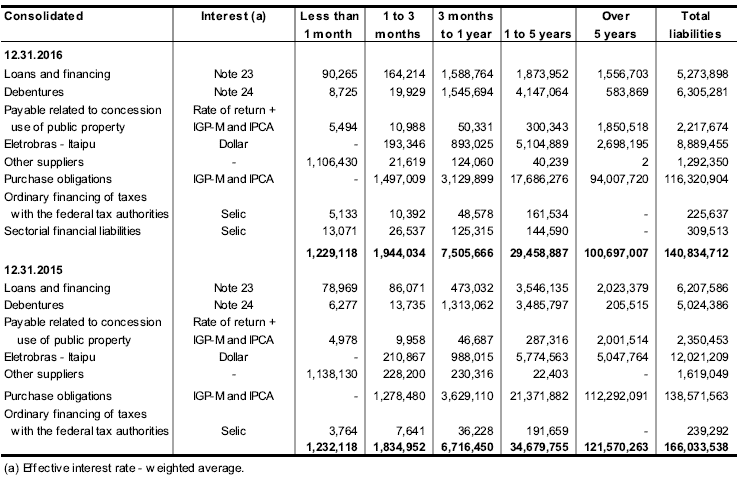
On December 31, 2016, Copel recorded a negative net working capital of R$371.351 and the Consolidated of R$1,253,046, mainly due to the reduction in current assets due to the realization of sectorial assets transferred to the tariff, together with the higher concentration of short-term debt. During the definition of the business budget for the year 2017, the Company's Management defined actions to balance the short-term financial capacity, preserving the Company's investment programs, however at lower levels than in 2016, as observed in the proposed capital budget for 2017, as well as seeking debt stretching.
As disclosed in notes 23.5 and 24.3, the Company and its subsidiaries have loans and financing agreements and debentures with covenants that if breached may have its payment accelerated.
36.2.3 Market risk
Market risk it is the risk that fair value or the future cash flows of a financial instrument shall oscillate due to changes in market prices, such as currency rates, interest rates and stock price. The purpose of managing this risk is to control exposures within acceptable limits, while optimizing return
a) Foreign currency risk (US Dollar)
This risk comprises the possibility of losses due to fluctuations in exchange rates, which may reduce assets or increase liabilities denominated in foreign currencies.
125
(CONVENIENCE TRANSLATION INTO ENGLISH FROM THE ORIGINAL PREVIOUSLY ISSUED IN PORTUGUESE)

The Company’s foreign currency indebtedness is not significant and it is not exposed to foreign exchange derivatives. The Company monitors all relevant exchange rates.
The effect of the exchange rate variation resulting from the power purchase agreement with Eletrobras (Itaipu) is passed on to customers in Copel Distribuição's next tariff adjustment.
The exchange rate risk posed by the purchase of gas arises from the possibility of Compagas reporting losses on the fluctuations in gas prices resulting from a fluctuation in the value of the OPEC Reference Basket and exchange rates, increasing the balances of accounts payable related to the acquired gas.
Compagas monitors these fluctuations on a permanent basis.
Currency risk sensitivity analysis
Sensitivity analysis of foreign currency risk
The Company has developed a sensitivity analysis in order to measure the impact of the devaluation of the U.S. dollar on its loans and financing subject to exchange risk.
The baseline takes into account the existing balances in each account as of December 31, 2016 and the probable scenario assumes a variation in the exchange rate - end of year (R$/US$3.29) based on the median market expectation for 2017 reported in the Central Bank’s Focus report of March 17, 2017. For the adverse and remote scenarios, deteriorations of 25% and 50%, respectively, were considered for the main risk factor for the financial instrument compared to the rate used in the likely scenario.

In addition to the sensitivity analysis required by CVM Resolution No. 475/2008, the Company evaluates its financial instruments considering the possible effects on profit and loss and shareholders’ equity of the risks evaluated by Company management on the reporting date for the financial instruments, as recommended by CPC 40 and IFRS 7. Based on the equity position and the notional value of the financial instruments held as of December 31, 2016, it is estimated that these effects will approximate the amounts stated in the above table in the column for the forecast probable scenario, since the assumptions used by the Company are similar to those previously described.
126
(CONVENIENCE TRANSLATION INTO ENGLISH FROM THE ORIGINAL PREVIOUSLY ISSUED IN PORTUGUESE)

b) Interest rate and monetary variation risk
This risk comprises the possibility of losses due to fluctuations in interest rates or other indicators, which may reduce financial income or financial expenses or increase the financial expenses related to the assets and liabilities raised in the market.
The Company has not engaged in transactions with derivatives to cover this risk, but it has continually monitored interest rates and market indicators, in order to assess the potential need for such transactions.
Sensitivity analysis of interest rate and monetary variation risk
The Company has developed a sensitivity analysis in order to measure the impact of variable interest rates and monetary variations on its financial assets and liabilities subject to these risks.
The baseline scenario takes into account the existing balances in each account as of December 31, 2016 while the ‘probable’ scenario assumes balances reflecting varying indicators as follows: CDI/Selic - 9.00%, IPCA - 4.15% IGP DI - 4.34% IGP-M - 4.52% and TJLP - 7.50%, estimated as market average projections for 2017 according to the Focus Report issued by the Central Bank of Brazil as of March 17, 2017.
For the adverse and remote scenarios, deteriorations of 25% and 50%, respectively, were considered for the main risk factor for the financial instrument compared to the rate used in the probable scenario.
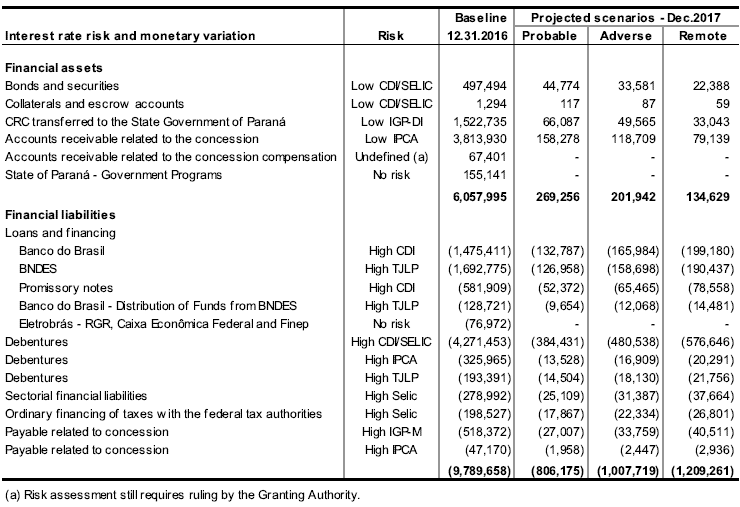
127
(CONVENIENCE TRANSLATION INTO ENGLISH FROM THE ORIGINAL PREVIOUSLY ISSUED IN PORTUGUESE)

In addition to the sensitivity analysis required by CVM Resolution No. 475/2008, the Company evaluates its financial instruments considering the possible effects on profit and loss and equity of the risks evaluated by Company management on the reporting date for the financial instruments, as recommended by CPC 40 and IFRS 7. Based on the equity position and the notional value of the financial instruments held as of December 31, 2016, it is estimated that these effects will approximate the amounts stated in the above table in the column for the forecast probable scenario, since the assumptions used by the Company are similar to those previously described.
36.2.4 Electricity shortage risk
Approximately 61.0% of installed capacity in the country currently comes from hydroelectric generation, which makes Brazil and the geographic region in which we operate subject to hydrological conditions that are unpredictable, due to non-cyclical deviations of mean precipitation. Unsatisfactory hydrological conditions may cause, among other things, the implementation of comprehensive programs of electricity savings, such as rationalization or even a mandatory reduction of consumption, which is the case of rationing.
From 2014, the reservoirs of the Southeast/Midwest, North and Northeast regions have been subject to adverse climate situations in recent years, leading agencies responsible for this industry to adopt water resources optimization measures to guarantee full compliance with load.
The economic crisis that the country is going through has had a significant impact on the consumption of electricity, practically stagnating its growth in the last 2 years, being decisive to avoid a greater difficulty in the full service of the market.
Regarding short-term risk, the Electric Power Industry Monitoring Committee - CMSE has been reporting a balance between energy supply and demand, and indices have been kept within safety margins. The same position is adopted by ONS regarding the risk of deficit in the medium term, as stated in the 2016-2020 Energy Operation Plan.
Although dam storage levels are not ideal, from the standpoint of regulatory agencies, when combined with other variables they are sufficient to keep the risk of deficit within the safety margin established by the National Energy Policy Council - CNPE (maximum risk of 5%) in all subsystems.
36.2.5 Risk of GSF impacts
The Energy Reallocation Mechanism (MRE) is a system of redistribution of electric power generated, characteristic of the Brazilian electric sector, which has its existence by the understanding, at the time, of the need for a centralized operation associated with a centrally calculated optimum price known as PLD. Since generators have no control over their production, each plant receives a certain amount of virtual energy which can be compromised through bilateral contracting. This value, which enables the registration of bilateral contracts, is known as Physical Guarantee - GF and, like the PLD, is also calculated centrally.
128
(CONVENIENCE TRANSLATION INTO ENGLISH FROM THE ORIGINAL PREVIOUSLY ISSUED IN PORTUGUESE)

Monthly, the GF committed to bilateral contracts needs to be backed by electricity generation. This is done, basically, through the allocation of power generated received from the MRE or purchase of generation valued to the PLD. The GSF is the ratio of the entire hydroelectric generation of the MRE participants to the GF sum of all the MRE plants. Basically, the GSF is used to calculate how much each plant will receive from generation to back up its GF. Thus, knowing the GSF of a given month the company will be able to know if it will need to back up its bilateral contracts through purchases to the PLD.
Where GF multiplied by GF is less than the sum of bilateral contracts, companies will need to buy the difference in the spot market. However, for the GSF multiplication situation by GF to be greater than the bilateral contracts, the Company receives the difference to the PLD.
The low inflows recorded since 2014 as well as problems with delays in the expansion of the transmission system have resulted in low GSF values, resulting in heavy losses for the companies holding MRE participating hydroelectric projects.
For plants with contracts in the Free Contracting Environment - ACL, the main way to manage the low GSF risk is not to compromise the entire GF with bilateral contracts, currently is the approach adopted by Copel.
For the contracts in the ACR, Law No. 13,203/2015, allowed the generators to contract insurance against the load, by means of payment of a Risk Premium. Copel adopted this approach to protect contracts related to energy produced by Mauá, Foz do Areia, Santa Clara and Fundão HPPs.
For the distribution segment, the effects of the GSF are perceived in the costs of the contracts for availability, as well as in the costs associated with quotas of Itaipu, Angra and the plants whose concessions wererenewed in accordance with Law No. 12,783/2013. This is a financial risk, however, since it guarantees the neutrality of energy purchase expenses through a tariff transfer.
36.2.6 Risk of non-renewal of concessions - generation and transmission
On March 3, 2017 Copel GeT filed an agreement with Aneel with its intention to extend the granting of the TPP Figueira, noting, however, that it will sign the necessary contracts and / or additives only after knowing and accepting the contractual terms and the rules that will govern any process related to the extension of the grant. For the other plants, the deadline for manifestation to opt or not to extend the generation concessions are shown below:

129
(CONVENIENCE TRANSLATION INTO ENGLISH FROM THE ORIGINAL PREVIOUSLY ISSUED IN PORTUGUESE)

These plants represent a Physical Guarantee of an average 620.69 MW. Currently, the extension of generation, transmission and distribution concessions covered by Articles 17, 19 and 22 of Law No. 9,074/1995 is governed by Law No. 12,783/2013. However, extension is permitted after express acceptance of conditions of that Law, such as: i) revenue determined according to criteria established by Aneel; ii) change from price remuneration to tariff calculated by Aneel for each plant; iii) allocation of plant energy and capacity physical guarantee shares to concessionaires and permittees of distribution public utilities; iv) submission to service quality standards defined by Aneel; and v) agreement with values established as indemnity of assets related to concession.
Concessions of hydroelectric power generation, electric power transmission and distribution may be extended at the discretion of Concession Grantor, one single time, for the period of up to 30 years. However, for concessions of thermoelectric power generation, extension period is limited to 20 years.
Current regulation also defined that the concessionaire has a period to request extension of concession of up to 60 months before final contract date or after granting of hydroelectric power generation plants, and of up to 24 months for thermoelectric plants.
It is also defined that, if the concessionaire opts to extend its concession, Concession Grantor may advance effects of extension by up to 60 months counted as of contract or grant date, and may also define initial tariff.
The Company will make analyses in the future to decide on whether or not concessions should be extended in view of conditions imposed by the Concession Grantor, aiming at preserving its profitability levels.
In case extension is not brought forward, Concession Grantor will open a tender bid process for concessions of the auction or competition type, for up to 30 years, considering, for tender bid judgment, the lowest tariff value and the highest offer to pay grant bonus.
In 2012, Copel GeT extended the Transmission Concession Agreement No. 060/2001, extending its main transmission concession up to 12.31.2042.
In 2016, after having won the bid carried out by Aneel, Copel GeT had its concession of Governador Parigot de Souza Hydroeletric Power Plant, with installed capacity of 260 MW and assured power of 109 average MW, renewed up to January 5, 2046.
36.2.7 Risk of non-renewal of concessions - distribution
Recently, pursuant to the terms of Concession Agreement amendment No. 46/1999 of Copel DIS, concession was extended, provided that quality and efficiency parameters for provision of distribution services are met, measured by indicators that consider duration and frequency of service interruptions (DECi and FECi) and efficiency in the Company’s economic and financial management.
130
(CONVENIENCE TRANSLATION INTO ENGLISH FROM THE ORIGINAL PREVIOUSLY ISSUED IN PORTUGUESE)

The Fifth Amendment to the Concession Agreement imposes indexes of economic and financial efficiency and quality. Failure to comply with the indexes for two consecutive years or any limits at the end of the period of the first five years will result in the termination of the concession. From the sixth year following the signing of the agreement, the breach of quality criteria for three consecutive years or of economic and financial criteria for two consecutive years will result in the opening of an expiration process. In addition, non-compliance with the electricity supply quality indicators (DEC and FEC) for two consecutive years or three times in five years, may limit dividends or interest on equity payments to shareholders, while the breach of the economic and financial sustainability indicators may require a capital contribution from the controlling shareholders.
The following table sets out the targets set for Copel DIS in the first five years of the renewal:
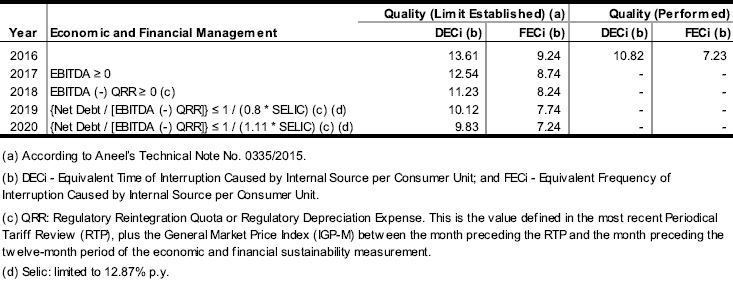
36.2.8 Risk of overcontracting and subcontracting of electricity
The agreement for purchase of electric power by distributors is regulated by Law No. 10,484/2014 and Decree No. 5,163/2004, which determine that distributors must purchase the volume required to serve 100% of their market through auctions on the Regulated Contacting Environment - ACR.
The contracting of the total output available in the market is verified by observing the period comprising the calendar year, and the difference between the costs remunerated by the tariff and those actually incurred on the power purchase are fully passed on to captive consumers as long as: (i) presents a contracting level between 100% and 105% of its market; (ii) presents a level lower than 100% - being, therefore, exposed to the risk of power purchase subject to the allowance for doubtful accounts, if the condition of involuntary undercontracting is recognized; and (iii) the Distributor presents a level higher than 105% - being, therefore, exposed to the risk of power sale subject to the allowance for doubtful accounts, if the condition of involuntary overcontracting is recognized.
131
(CONVENIENCE TRANSLATION INTO ENGLISH FROM THE ORIGINAL PREVIOUSLY ISSUED IN PORTUGUESE)

That is, even if distributors determine contracting levels lower or higher than the regulatory limits, there is the assurance of neutrality if it is identified that such violation derives from extraordinary and unforeseen events that are not manageable.
On the other hand, if the violation of the contracting limits derives from voluntary actions, these will be subject to the risk of spot market exposure, which can be advantageous or disadvantageous according to the amount of the difference settlement price (PLD).
In 2016, the distributors experienced a scenario of general overcontracting and most of the companies determined contracting level higher than 105%, arising from economic factors such as the fall of consumption related to the crisis in the country and industry, the allocation of the Assured Power Quota Agreements, and the migration of special consumers to the free market.
As regards industry issues, through Normative Resolution No. 706/2016, a ANEEL recognized as involuntary overcontracting the allocation of assured power quotas of hydro power plants classified under Law No. 783/2013 above the amount of replenishment of the distributors.
To recognize the overcontracting arising from the migration of special consumers to ACL, on 6.27.2016, as a partial result of the Public Hearing 85/2013, Normative Resolution No. 726/2016 was published. On that occasion, ANEEL confirmed the Distributors’ right to return the power not contracted by special consumers, based on Opinions No. 260/2012/PFANEEL/PGF/AGU and 219/2016/PFANEEL/PGF/AGU and Technical Notes NT 66/2012-SEM/ANEEL and NT 46/2016-SRM/ANEEL.
Nevertheless, ANEEL's Collegiate Body established that this possibility would be applicable only to existing power agreements signed after the publication of such resolution, thus following the vote of the Reporting Officer, who justified such proposal based on the principles of legal security and regulatory stability.
However, as it is not subject to Public Hearing and also because it considered such judgment on a general basis inappropriate, ANEEL understood that distributors eventually interested should request individually the recognition of the involuntary exposure, demonstrating the utilization of the other possibilities at their disposal.
Copel DIS put forth all efforts possible, provided for in the regulation, to mitigate the overcontracting generated by the migration of special consumers to the free market and requested from ANEEL that any overcontracting related to this matter was considered as involuntary, mainly based on Opinion No. 219/2016/PFANEEL/PGF/AGU, which explicitly addressed special consumers in article 29, item I, of Decree 5,163/2004.
36.2.9 Gas shortage risk
This risk involves potential periods of shortage of natural gas supply to meet the Company’s gas distribution and thermal generation business requirements
132
(CONVENIENCE TRANSLATION INTO ENGLISH FROM THE ORIGINAL PREVIOUSLY ISSUED IN PORTUGUESE)

Long periods of gas shortage could result in losses due to lower revenues by subsidiaries Compagas and UEG Araucária.
36.3 Capital management
The Company seeks to maintain a strong capital base to maintain the trust of investors, creditors and market and ensure the future development of the business. Management strives to maintain a balance between the highest possible returns with more adequate levels of loans and the advantages and the assurance afforded by a healthy capital position. Thus, it maximizes the return for all interested parties in its operations, optimizing the balance of debts and equity.
The Company monitors capital by using an index represented by adjusted net debt divided by adjusted EBITDA, as presented below. Corporate goal established in strategic planning provides for maintenance of index below 3.5 while any expectation of failing to meet this target will prompt management to take steps to correct its course by the end of each reporting period. As of December 31, 2016, the index performed is shown below:
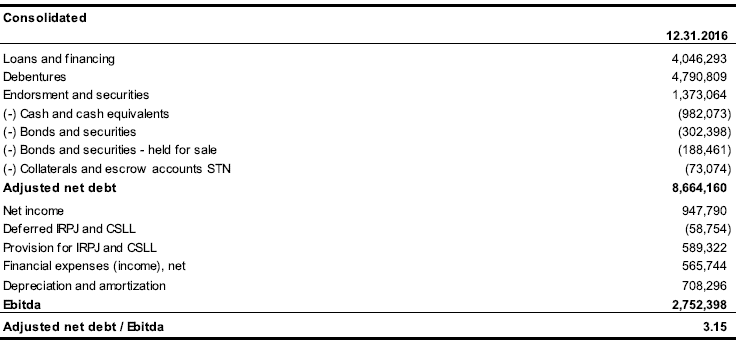
The equity indebtedness is shown below:

133
(CONVENIENCE TRANSLATION INTO ENGLISH FROM THE ORIGINAL PREVIOUSLY ISSUED IN PORTUGUESE)

37 Related Party Transactions
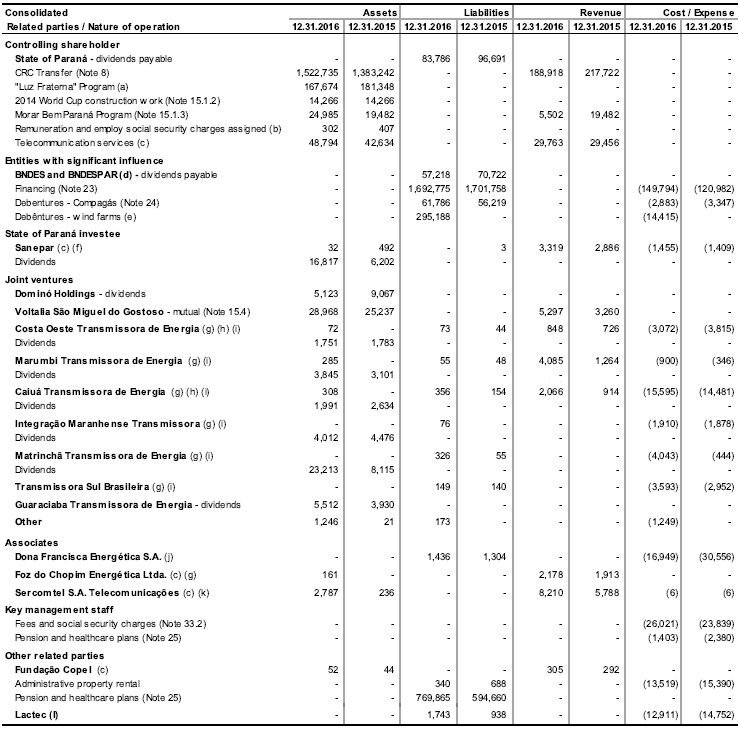
a) The Luz Fraterna Program, created under Law No. 491/ 2013 and No. 17,639/2013 allows the State Government to pay for the electricity bills of low income families in Paraná – which have duly applied for the program – provided their consumption does not exceed 120 kWh a month. This benefit is available to residential customers with single-phase connections, rural customers with single-phase connections or two-phase connections with circuit breakers of up to 50 amperes. Applicants must not have more than one electricity bill under their names and must not have any pending debts to Copel DIS.
134
(CONVENIENCE TRANSLATION INTO ENGLISH FROM THE ORIGINAL PREVIOUSLY ISSUED IN PORTUGUESE)

As of August 2016, monthly payments were made in a timely manner, totaling the amount of R$17,085 in 2016, and the possibility of using presumed ICMS credits for the discharge of outstanding invoices related to this program is being evaluated, as fixed in Decree No. 2,789/2015.As of December 31, 2016, the amount of R$115,890 (R$153,300 as of December 31, 2015) is recognized in the Parent Company’s Related Parties account as per Note 15.1.1.
b) Reimbursement of wages and social charges for employees transferred to the Paraná State Government. The balances shown are net of allowance for loan losses in the amount of R$1,749 as of December 31, 2016 (R$1,040 as of December 31, 2015).
c) Telecommunications services rendered in accordance with the agreement entered into by Copel Telecomunicações with the State of Paraná.
d) BNDES is the parent company of BNDES Participações S.A. (BNDESPAR), which has significant influence over Copel (Note 31.1.1).
e) BNDES and BNDESPAR acquired all the debentures issued by the subsidiaries Nova Asa Branca I, Nova Asa Branca II, Nova Asa Branca III, Nova Eurus IV and Ventos de Santo Uriel (Note 24).
f) Basic sanitation provided by Sanepar.
g) Charges for the use of the Transmission System and revenue from operating and maintenance contracts and rendering of engineering services with Copel GeT.
h) Copel DIS has transmission system connection contracts (CCT) with two companies - Costa Oeste Transmissora de Energia and Caiuá Transmissora de Energia – expiring upon the termination of the distribution or transmission concession, whichever occurs first.
i) Copel DIS Copel Distribuição maintains a Contract for the Use of Transmission System (Cust) with ONS and power transmission concessionaires whose object is the contracting of Transmission System Use Amount (Must). Contracting is permanent and is regulated by Aneel Regulatory Resolution No. 399/2010. Amounts are defined for four subsequent years, with annual reviews.
j) Power purchase and sale agreement signed by Dona Francisca Energética and Copel GeT, expiring on March 31, 2025.
k) Light pole sharing agreement signed between Sercomtel S.A. Telecomunicações and Copel DIS, expiring on December 28, 2018.
l) The Institute of Technology for Development (Lactec) is a Public Interest Civil Society Organization (OSCIP), in which Copel is an associated. Lactec has service and R&D contracts with Copel Geração e Transmissão and Copel Distribuição, which are subject to prior or later control and approval by Aneel.
The asset balances refer to Energy Efficiency and R&D programs, recorded under current assets, in service in progress, until the respective projects are concluded, pursuant to Aneel.
135
(CONVENIENCE TRANSLATION INTO ENGLISH FROM THE ORIGINAL PREVIOUSLY ISSUED IN PORTUGUESE)

The values resulting from operating activities of Copel DIS with related parties are billed at the rates approved by Aneel.
37.1 Guarantees and endorsements awarded to related parties
Sureties and guarantees granted by Copel to its subsidiaries for financing and debentures are informed in Notes 23 and 24.
Copel provided financial guarantees, in the form of corporate bond, for power purchase agreements made by Copel GeT in May 2015, in the total amount of R$3,052 and made by Copel Energia, in November 2016, in the amount of R$16,406.
Sureties and guarantees granted by Copel and Copel GeT for financing, debentures and insurance contracts of joint ventures are shown below:
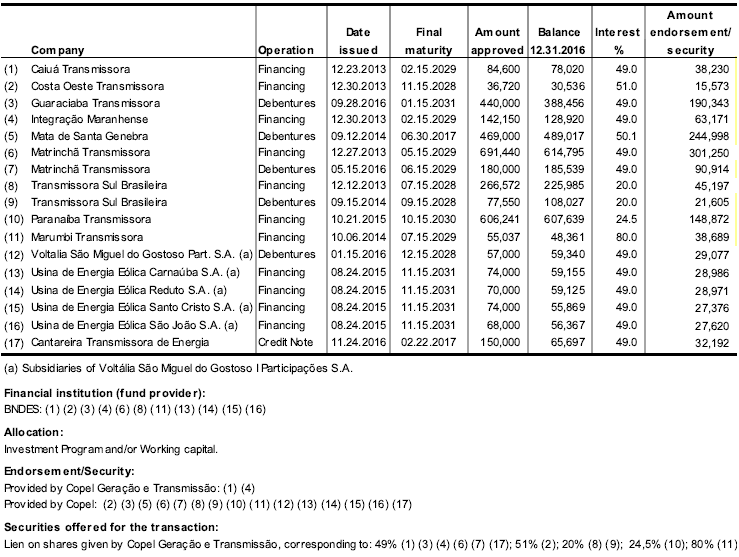
136
(CONVENIENCE TRANSLATION INTO ENGLISH FROM THE ORIGINAL PREVIOUSLY ISSUED IN PORTUGUESE)


38 Insurance
Details by risk type and effectiveness date of the main policies can be seen below.
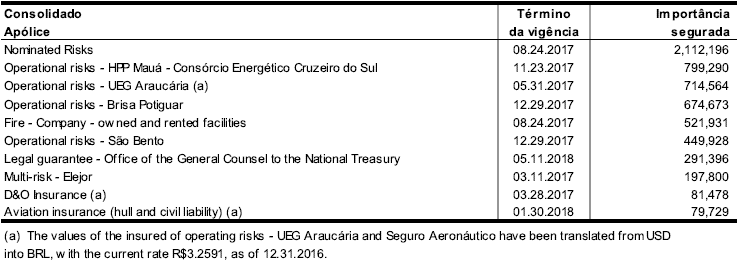
In addition to the related insurance, the Company and its subsidiaries contract other insurance policies with lower values, such as: general civil liability, payment guarantee, several risks, national and international transportation and life insurance.
The guarantee insurance contracted by the subsidiaries and joint ventures have Copel as a guarantor, within the limits of their participation in each project.
39 Subsequent Events
39.1 Bank Credit Note- CCB,of Banco do Brasil
On February 24, 2010, Copel raised R$77,000 through a Bank Credit Note issued by Banco do Brasil, with a payment of 124.5% of the average daily rates of Interbank Deposits - DI, with semiannual interest payments, term of 3 years and amortization in the second and third years.
137
(CONVENIENCE TRANSLATION INTO ENGLISH FROM THE ORIGINAL PREVIOUSLY ISSUED IN PORTUGUESE)

39.2 Related party guarantees
39.2.1 Cantareira Transmissora de Energia S.A.
In January 2017, BNDES made the first release of financial resources, in the amount of R$285,000, from the long-term financing contracted in December 2016, for the implementation of the transmission line between Ibiraci/MG and Fernão Dias/SP, with 328 Km, by the Cantareira Transmissora de Energia. The financial support will be through the BNDES Finem financing agreement, with a total amount of R$426,833, with a term of 14 years, remunerated by the TJLP variation, plus 2.12% pa, and monthly amortizations as of 10.15.2018. The following guarantees were provided: (i) the Concession Agreement; (ii) the shares of the SPE; (iii) contracts for the provision of energy transmission services; and (iv) a bank guarantee, with counter-guarantee from Copel, proportional to Copel GeT's ownership interest in the project, from 49%.
39.2.2 Paranaíba Transmissora de Energia S.A.
On March 17, 2012, Paranaíba Transmissora de Energia concluded the issuance of simple debentures, pursuant to article 2 of Law No. 12,431, dated June 24, 2011 ("Infrastructure Debentures"), not convertible into shares, for public offering of distribution with restricted placement efforts under CVM Instruction No. 476/2009, in the total amount of R$120,000. 120,000 debentures were issued, with a nominal unit value of R$1 (one real), with a term of 11 years and 2 months, amortization and semi-annual interest, as of 09.15.2017. The debentures will be remunerated with interest corresponding to the variation of the IPCA, plus a surcharge of 6.9045% per year. The following guarantees were provided: (i) the Concession Agreement; (ii) the shares of the SPE; (iii) contracts for the provision of energy transmission services; and (iv) corporate bonds of the shareholders, proportional to their participation (24.5% of Copel GeT's interest). The funds raised will be allocated to the implementation of the enterprise.
138
A FREE TRANSLATION FROM PORTUGUESE INTO ENGLISH OF INDEPENDENT AUDITOR’S REPORT
INDEPENDENT AUDITOR’S REPORT
INDEPENDENT AUDITOR’S REPORT
ON INDIVIDUAL AND CONSOLIDATED FINANCIAL STATEMENTS
To the Board of Directors and to Shareholders of
Companhia Paranaense de Energia - COPEL
Paraná – PR.
Opinion
We have audited the individual and consolidated financial statements of Companhia Paranaense de Energia (“Copel” or “Company”), identified as the parent company and consolidated, respectively, which includes the balance sheet of December 31, 2016, and the related income statement, the comprehensive income statement, as well as changes in equity and cash flow statements for the year then ended, and a summary of significant accounting policies and other explanatory notes.
In our opinion, the financial statements referred to above fairly present, in all material respects, Copel’s individual and consolidated financial position as at December 31, 2016, the individual and consolidated performance of its operations and cash flows for the year then ended, in accordance with accounting practices adopted in Brazil and International Financial Reporting Standards (IFRS) issued by the International Accounting Standards Board (IASB).
Basis for Opinion
We conducted our audit in accordance with Brazilian and international standards on auditing. Our responsibilities under those standards are further described in the “Auditor’s Responsibilities for the Audit of the Individual and Consolidated Financial Statements” section of this report. We are independent from the Company and its subsidiaries in accordance with the relevant ethical requirements in the Code of Ethics for Professional Accountants and the professional standards issued by the Federal Accounting Council – CFC, and we have fulfilled our other ethical responsibilities in accordance with these standards. We believe that the audit evidence we have obtained is sufficient and appropriate to provide a basis for our audit opinion.
Key Audit Matters
Key audit matters are those matters that, in our professional judgment, were of most significance in our audit of the financial statements of the current period. These matters were addressed in the context of our audit of the individual and consolidated financial statements as a whole, and in forming our opinion thereon and, accordingly, we do not provide a separate opinion on these matters.
139
A FREE TRANSLATION FROM PORTUGUESE INTO ENGLISH OF INDEPENDENT AUDITOR’S REPORT
Revenue recognition
Revenue of the Company and its subsidiaries mainly derive from the supply of electric energy, electric power distribution network, revenue from building infrastructure, telecommunication services and distribution of piped gas, as described in Notes 4.10, 4.11 and 32. This issue was considered a key audit matter, given the complexity in the capture, processing and registration of transactions and the high dependence on technology systems and the respective internal controls involved in the recognition of the Company's revenue.
Our audit procedures to address this key audit matter included, but were not limited to: (i) assessing the design and the implementation of relevant internal controls related to Management's processes for revenue recognition; (ii) assessing the information technology environment with the assistance of our internal specialists, including measurement and billing systems, as well as the relevant change and access management controls related to the systems involved in the revenue recognition processes; (iii) testing, on a sample basis, the occurrence, completeness and accuracy of revenues recognized by Copel, as well as assessing whether such revenues were accounted for in the appropriate period; (iv) testing the accuracy of invoice generation, on a sampling basis; (v) testing the subsequent receipt of invoices, on a sampling basis; (vi) testing the unbilled revenues by assessing Management's estimation process; and (vii) analyzing the appropriateness of the disclosures.
Capitalization of expenditures as intangible assets related to the concession
As disclosed in Explanatory Note No. 20, the Company has significant balances of Intangible Assets related to the Concession. Due to the amount involved and the spreading of investments throughout the concession area of the distributor controlled by the Company, and considering that the distribution infrastructure is the basis used by the regulator (National Electric Energy Agency – ANEEL) in determining each tariff review cycle, that is, the distribution infrastructure is the basis for calculating remuneration – BRR, we consider the segregation and capitalization of expenditures as the intangible asset of the concession as a key audit matter, since errors may occur in the determination and capitalization of non-qualifying expenditures, mainly related to third-party services and personnel.
Our audit procedures to address this key audit matter related to segregation and capitalization of expenditures from the distribution infrastructure included, but were not limited to: (i) assessing the design and the implementation of relevant internal controls related to Management's processes for segregation and capitalization of expenditures from the distribution infrastructure; (ii) involving Information Technology specialists to assess the Company's systems to control the intangible asset and the respective capitalized expenditures; (iii) testing, on a sample basis, the accuracy of capitalized amounts on segregated and capitalized expenditures to the intangible and financial assets of the concession; (iv) testing the assumptions used by Management in determining and segregating capitalized expenses; and (v) analyzing capitalized amounts compared to those approved by the regulator in its last tariff review cycle of the distributor controlled by the Company.
Provision for litigation
As disclosed in the Explanatory Note No. 30, the Company is the defendant in a number of lawsuits related to labor, tax and civil matters, involving large amounts. In determining the amounts to be accounted for to cover these risks, as well as the amounts of possible risks disclosed in the financial statements, Management applies a high level of judgment that requires the use of technical and historical knowledge of the Company, case law analysis and individual analysis of processes.
140
A FREE TRANSLATION FROM PORTUGUESE INTO ENGLISH OF INDEPENDENT AUDITOR’S REPORT
Our audit procedures to address this key audit matter included: (i) assessing the design, implementation and effectiveness of internal controls related to contingencies, specifically in determining provisions for such risks; (ii) testing, with the assistance of our information technology specialists, automated controls and systems used by Management and its external legal advisors to control and assess the provisions; (iii) testing the completeness and accuracy of the database used by Management to develop estimates of perspectives of loss processes; (iv) independent confirmation with the external legal advisors and process patrons regarding the classification of the risk of loss, the procedural stage and the amount involved; and (vi) testing the assumptions and judgments used by Management in the development of this estimate. We also analyzed the appropriateness of the disclosures related to these processes and provisions included in Explanatory Note No. 30.
Other matters
Audit of amounts corresponding to the previous year
As mentioned in Explanatory Note No. 4.1, the amounts corresponding to the fiscal year ended December 31, 2015, presented for comparison purposes and restated as a result of the subject matter described in the aforementioned note, were audited by other independent auditors who issued a report dated March 28, 2017, which did not contain any modification. Our opinion contains no modification related to this matter.
Statements of value added
The individual and consolidated statements of value added (“DVA”) for the fiscal year ended December 31, 2016, prepared under the responsibility of the Company’s Management and disclosed as supplemental information for purposes of the IFRSs, were subject to audit procedures performed together with the audit of the Company’s financial statements. In forming our opinion, we assess whether these statements are reconciled with the financial statements and accounting records, as applicable, and whether their form and content are in accordance with the criteria set out in Technical Pronouncement CPC 09 – Statement of Value Added. In our opinion, these statements of value added were fairly prepared, in all material respects, in accordance with the criteria set out in such Technical Pronouncement and are consistent in relation to the individual and consolidated financial statements taken as a whole.
Other information accompanying the individual and consolidated financial statements and the independent auditor’s report
Management is responsible for such other information, which comprises the Management Report.
Our opinion on the individual and consolidated financial statements does not cover the Management Report and we do not express any form of audit conclusion thereon.
In connection with our audit of the individual and consolidated financial statements, our responsibility is to read the Management Report and, in doing so, consider whether it is materially inconsistent with the financial statements or our knowledge obtained in the audit or otherwise appears to be materially misstated. If, based on the work we have performed, we conclude that there is a material misstatement of the Management Report, we are required to report that fact. We have nothing to report in this regard.
141
A FREE TRANSLATION FROM PORTUGUESE INTO ENGLISH OF INDEPENDENT AUDITOR’S REPORT
Responsibilities of Management and those charged with governance for the individual and consolidated financial statements
Management is responsible for the preparation and fair presentation of the individual and consolidated financial statements in accordance with accounting practices adopted in Brazil and the International Financial Reporting Standards (IFRS), as issued by the International Accounting Standards Board (IASB), and for such internal control as Management determines is necessary to enable the preparation of financial statements that are free from material misstatement, whether due to fraud or error.
In preparing the individual and consolidated financial statements, Management is responsible for assessing the Company’s ability to continue as a going concern, disclosing, as applicable, matters related to going concern and using the going concern basis of accounting unless Management either intends to liquidate the Company and its subsidiaries or to cease operations, or has no realistic alternative but to do so.
Those charged with governance are responsible for overseeing the Company’s and its subsidiaries’ financial reporting process.
Auditor’s responsibilities for the audit of the individual and consolidated financial statements
Our objectives are to obtain reasonable assurance about whether the individual and consolidated financial statements as a whole are free from material misstatement, whether due to fraud or error, and to issue an auditor’s report that includes our opinion. Reasonable assurance is a high level of assurance, but is not a guarantee that an audit conducted in accordance with Brazilian and International Standards on Auditing will always detect a material misstatement when it exists. Misstatements can arise from fraud or error and are considered material if, individually or in the aggregate, they could reasonably be expected to influence the economic decisions of users taken on the basis of these financial statements.
As part of an audit in accordance with Brazilian and international standards on auditing, we exercised professional judgment and maintained professional skepticism throughout the audit.We also:
· Identified and assessed the risks of material misstatement of the individual and consolidated financial statements, whether due to fraud or error, design and perform audit procedures responsive to those risks, and obtain audit evidence that is sufficient and appropriate to provide a basis for our opinion. The risk of not detecting a material misstatement resulting from fraud is higher than for one resulting from error, as fraud may involve collusion, forgery, intentional omissions, misrepresentations, or the override of internal control.
· Obtained an understanding of internal control relevant to the audit in order to design audit procedures that were appropriate in the circumstances, but not for the purpose of expressing an opinion on the effectiveness of the Company’s and its subsidiaries’ internal controls.
· Evaluated the appropriateness of accounting policies used and the reasonableness of accounting estimates and related disclosures made by Management.
142
A FREE TRANSLATION FROM PORTUGUESE INTO ENGLISH OF INDEPENDENT AUDITOR’S REPORT
· Concluded on the appropriateness of Management’s use of the going concern basis of accounting and, based on the audit evidence obtained, whether a material uncertainty exists related to events or conditions that may cast significant doubt on the Company’s and its subsidiaries’ ability to continue as going concerns. If we conclude that a material uncertainty exists, we are required to draw attention in our auditor’s report to the related disclosures in the individual and consolidated financial statements or, if such disclosures are inadequate, to modify our opinion. Our conclusions are based on the audit evidence obtained up to the date of our auditor’s report. However, future events or conditions may cause the Company and its subsidiaries to cease to continue as going concerns.
· Evaluated the overall presentation, structure and content of the financial statements, including the disclosures, and whether the individual and consolidated financial statements represent the underlying transactions and events in a manner that achieves fair presentation.
· Obtained sufficient appropriate audit evidence regarding the financial information of the entities or business activities within the Group to express an opinion on the consolidated financial statements. We are responsible for the direction, supervision and performance of the Group audit and for our audit opinion.
We communicated with those charged with governance regarding, among other matters, the planned scope and timing of the audit and significant audit findings, including any significant deficiencies in internal control that we identify during our audit.
We also provided those charged with governance with a statement that we have complied with relevant ethical requirements regarding independence, and to communicate with them all relationships and other matters that may reasonably be thought to bear on our independence, and, where applicable, related safeguards.
From the matters communicated with those charged with governance, we determined those matters that were of most significance in the audit of the financial statements of the current period and are therefore the Key Audit Matters. We described these matters in our auditor’s report unless law or regulation precludes public disclosure about the matter or when, in extremely rare circumstances, we determined that a matter should not be communicated in our report because the adverse consequences of doing so would reasonably be expected to outweigh the public interest benefits of such communication.
Curitiba, March 28, 2017
/s/ DELOITTE TOUCHE TOHMATSU Independent Auditors CRC nº 2 SP 011609/O-8 F-PR | /s/ Fernando de Souza Leite Accountant CRC n.º 1 PR-050.422/O-3 |
143
(CONVENIENCE TRANSLATION INTO ENGLISH FROM THE ORIGINAL PREVIOUSLY ISSUED IN PORTUGUESE)

SUMMARY OF THE AUDIT COMMITTEE’S ANNUAL REPORT
2016
The Audit Committee - CAU of Companhia Paranaense de Energia - Copel held, in 2016, thirteen meetings with CAU exclusive agenda and three meetings jointly with the Supervisory Board, for the analysis of the Company’s financial statements, with the presence of the Independent Audit and Internal Audit teams to address matters of its operating area and the analysis of other matters of its competence.
The Committee’s activities in 2016 were focused on the assessment of the internal control systems and management of risks; analysis of the work of the Independent Auditing Firm - KPMG Auditores Independentes and, subsequently, Deloitte Touche Tohmatsu, which served the Company in 2016 as to its results, financial statements and financial reports; analysis of the aspects involving the process of preparation of trial balances and balance sheets, the notes to the financial statements and the financial reports published in conjunction with the consolidated financial statements; in the examination of the significant practices adopted by Copel in the preparation of the financial statements; and in the analysis and monitoring of the Internal Auditing work, with the purpose if improving its performance.
In the exercise of its regulatory activities, the following stand out:
a) Monitoring of the Internal Audit activities;b) Monitoring of the Confidential Communication Channel;c) Approval of the Internal Audit Work Plan for 2016/2017;d) Establishment of operating procedures for the Audit Committee;e) Analysis and approval of the 2015 Annual Management Report, Balance Sheet and other Financial Statements for the year ended 2015;f) Appreciation of the Officers' proposal for allocation of the profit for 2015 and for the payment of sharing relating to the integration between capital and work and the incentive to productivity;g) Appreciation of the process of engagement of an independent auditing firm;h) Analysis and approval of the Audit Committee's 2015 Annual Report;i) Monitoring of the Work of the Corporate Risk Integrated Management Committee;j) Preliminary analysis of the Report 20-F - 2015-2016;k) Review of the accounting policies, practices and principles used by Copel in the preparation of the accounting and financial statements;l) Review of the alternative methods of accounting treatment related to accounting and financial information;m) Appreciation of the Independent Audit work planning for 2016;n) Engagement of other services that can be provided by the independent auditing firms that are auditing the Company's accounting and financial statements;o) Approval of the Report 20-F - 2015-2016;p) Analysis of the documentation related to the judicial agreement with the company Ivaí Engenharia de Obras S.A.;q) Analysis of the novation of the Term of Adjustment of the Account for Compensation of Income and Losses - CRC;r) Engagement of advisory specialized in International Financial Reporting Standards - IFRS;s) Analysis of the evolution of the corporate budget;t) Review of the Financial Statements - ITR 1st quarter 2016;u) Certificate of Independence of the External Auditing Firm - KPMG Auditores Independentes;v) Submission of the Management Letter by the External Auditing Firm - KPMG Auditores Independentes and verification of its recommendations;w) Review of the Company’s Risk Assessment and Management Policies;x) Follow-up of the points raised by the Independent Auditing Firm KPMG in its Management Letter;y) Review of the Financial Statements - ITR for the 2nd quarter of 2016;z) Presentation of Price Consultoria - PWC on International Financial Reporting Standards - IFRS);aa) Analysis of the proposal for judicial settlement with the company Ivaí Engenharia de Obras S.A.;bb) Approval of the activities report of the Audit Committee – 1st half/2016;cc) Approval of the Corporate Risk Management Policy;dd) Analysis of the proposal for simple updates of the Copel’s Internal Audit regulations;ee) Verification of the recommendations made by the Audit Committee;ff) Review of the Financial Statements - ITR for the 3rd quarter of 2016;gg) Presentation of PriceWaterHouseCoopers – PWC on the “New External Audit Report” and “Unusual Accounting Transactions”;hh) Monitoring by the Internal Audit and by the Corporate Integrity Coordination - CIC, of the points raised by the Independent Auditing Firm KPMG, in its Management Letter;ii) Annual Self-Assessment of the Audit Committee;jj) Approval of the calendar of meetings of the Audit Committee for 2017; andkk) Approval of the Related-Party Transaction Policy.
144
(CONVENIENCE TRANSLATION INTO ENGLISH FROM THE ORIGINAL PREVIOUSLY ISSUED IN PORTUGUESE)

In the appreciation of the Committee, the form and the actions adopted to monitor these systems at Copel (Holding) and in its subsidiaries, in their material respects, are well established and properly addressed, and no material exception that may impact them has been detected.
Based on the exams and the information provided by KPMG Auditores Independentes and by Deloitte Touche Tohmatsu, the Committee attests to the objectivity and independence of the External Auditors since it has not identified any situations that might affect them and assesses as appropriate the Company's Internal Auditing structures, as well as the quality of its technical and management staff and the results presented by its work.
There was no reporting of non-compliance with standards, lack of controls, act or omission by the Company’ management that would indicate the existence or evidence of fraud, failures or errors that could jeopardize Copel's ability to continue as a going concern or the credibility of its accounting and financial statements.
Considering the internal control systems in place, the extent and effectiveness of the work performed by the independent auditors, as well as their opinion, this Audit Committee has concluded that the financial statements at 12.31.2016 present fairly the financial position of Companhia Paranaense de Energy - Copel in relation to accounting practices adopted in Brazil, the Brazilian corporate law, the rules of the Securities and Exchange Commission of Brazil (CVM) and the standards issued by the Brazilian Electricity Regulatory Agency - Aneel and the Brazilian Telecommunications Agency - Anatel, and recommends its approval by the Board of Directors.
A copy of the supporting documentation of the matters decided by the Audit Committee during 2016, described in the activities report of this Collegiate, is electronically filed at the Copel’s Corporate Governance Secretariat (SEC) and remains available for consultation.
Curitiba, May 28, 2017
/s/
Carlos Homero Giacomini
Chairman
/s/
José Richa Filho
/s/
Mauro Ricardo Machado Costa
145
(CONVENIENCE TRANSLATION INTO ENGLISH FROM THE ORIGINAL PREVIOUSLY ISSUED IN PORTUGUESE)

SUPERVISORY BOARD’S OPINION
ON THE ANNUAL MANAGEMENT REPORT, BALANCE SHEET
AND OTHER FINANCIAL STATEMENTS FOR 2016 AND
ON THE OFFICERS’ PROPOSAL FOR ALLOCATION OF THE PROFIT FOR 2016
The undersigned members of the Supervisory Board of Companhia Paranaense de Energia - Copel, within their legal attributions and responsibilities, have examined the Annual Management Report, Balance Sheet and Other Financial Statements for the year 2016 and Management's Proposal for Allocation of the Profit for the year ended December 31, 2016 and, based on the analyses performed and additional clarifications provided by Management, considering also the Report of the Independent Auditors, Deloitte Touche Tohmatsu Auditores Independentes, issued without qualifications, have concluded that the analyzed documents are properly presented, in all material respects, and, for this reason, give their favorable opinion to its submission for the General Meeting of Shareholders.
Curitiba, May 28, 2017
/s/ OSNI RISTOW | /s/ GEORGE HERMANN RODOLFO TORMIN |
/s/ NELSON LEAL JUNIOR | /s/ MASSAO FABIO OYA |
/s/ JOÃO CARLOS FLOR JUNIOR | |
146
(CONVENIENCE TRANSLATION INTO ENGLISH FROM THE ORIGINAL PREVIOUSLY ISSUED IN PORTUGUESE)

CAPITAL BUDGET PROPOSAL
In conformity with CVM Instruction 480/2009, in effect since 1.01.2010, below we present the capital budget proposal for 2017, approved at the 161st annual meeting of the Board of Directors of Companhia Paranaense de Energia, held on 12.14.2016, as well as the origin of the funds.
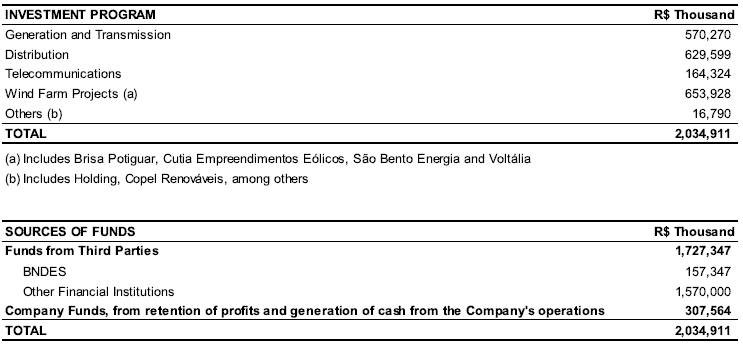
147
(CONVENIENCE TRANSLATION INTO ENGLISH FROM THE ORIGINAL PREVIOUSLY ISSUED IN PORTUGUESE)

STATEMENT
By this document, the Chief Executive Officer and the other Officers of Companhia Paranaense de Energia - Copel, mixed capital corporation, with registered office at Rua Coronel Dulcídio nº 800, Curitiba - PR, enrolled in the National Registry of Legal Entities (CNPJ No. 76.483.817/0001-20) for the purposes of the provisions in items V and VI of article 25 of CVM Instruction 480/2009, state that:
(i) they have reviewed and discussed and agree with the opinions expressed in the audit report of Deloitte Touche Tohmatsu Auditores Independentes related to the financial statements of Copel for the year ended December 31, 2016; and
(ii) they have reviewed and discussed and agree with the financial statements of Copel for the year ended December 31, 2016.
Curitiba, May 28, 2017
/s/ ANTONIO SERGIO DE SOUZA GUETTER Chief Executive Officer | /s/ GILBERTO MENDES FERNANDES Chief Corporate Management Officer |
/s/ LUIZ EDUARDO DA VEIGA SEBASTIANI Chief Financial and Investor Relations Officer | /s/ JONEL NAZARENO IURK Chief Business Development Officer |
/s/ CRISTIANO HOTZ Chief Legal and Institutional Relations Office r | /s/ FABIO MALINA LOSSO Chief Governance, Risk and Compliance Officer |
148
Pursuant to the requirements of the Securities Exchange Act of 1934, the registrant has duly caused this report to be signed on its behalf by the undersigned, thereunto duly authorized.
| COMPANHIA PARANAENSE DE ENERGIA – COPEL |
| | |
| By: | /S/ Jonel Nazareno Iurk
| |
| | Jonel Nazareno Iurk
Chief Executive Officer | |
FORWARD-LOOKING STATEMENTS
This press release may contain forward-looking statements. These statements are statements that are not historical facts, and are based on management's current view and estimates of future economic circumstances, industry conditions, company performance and financial results. The words "anticipates", "believes", "estimates", "expects", "plans" and similar expressions, as they relate to the company, are intended to identify forward-looking statements. Statements regarding the declaration or payment of dividends, the implementation of principal operating and financing strategies and capital expenditure plans, the direction of future operations and the factors or trends affecting financial condition, liquidity or results of operations are examples of forward-looking statements. Such statements reflect the current views of management and are subject to a number of risks and uncertainties. There is no guarantee that the expected events, trends or results will actually occur. The statements are based on many assumptions and factors, including general economic and market conditions, industry conditions, and operating factors. Any changes in such assumptions or factors could cause actual results to differ materially from current expectations.




























